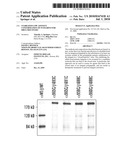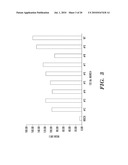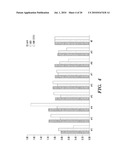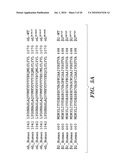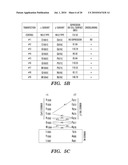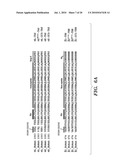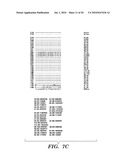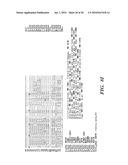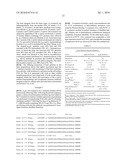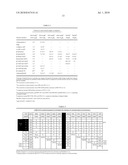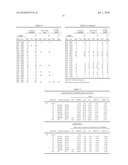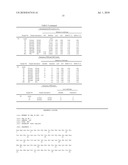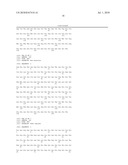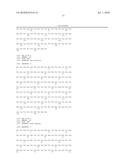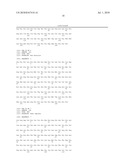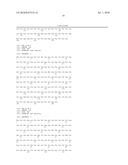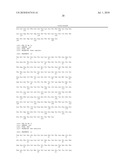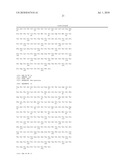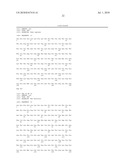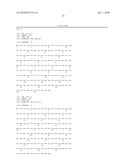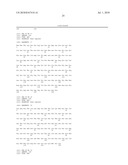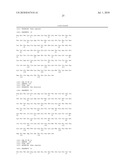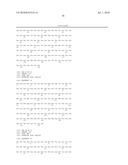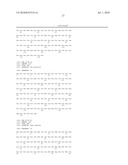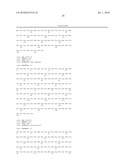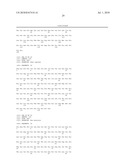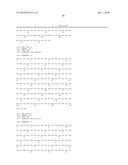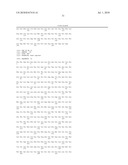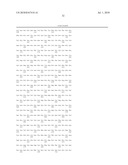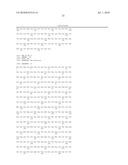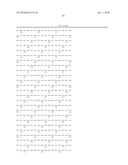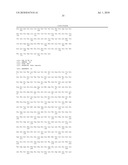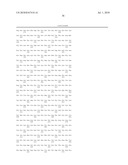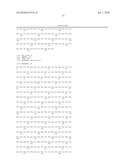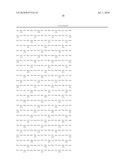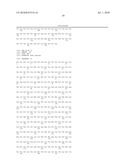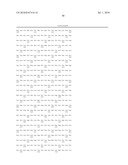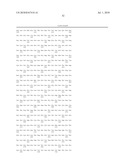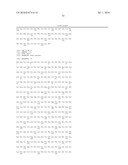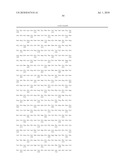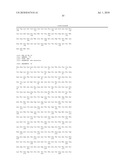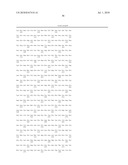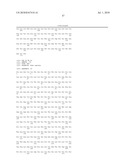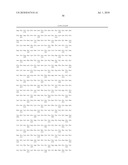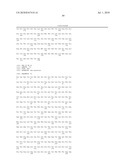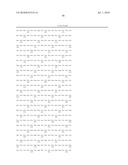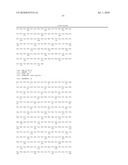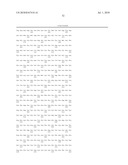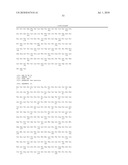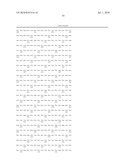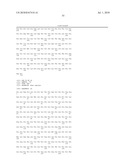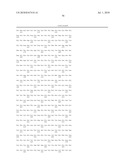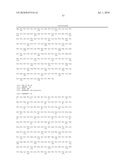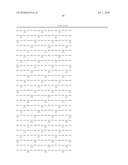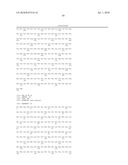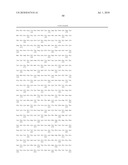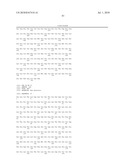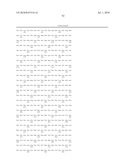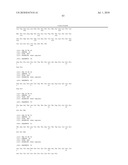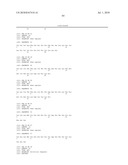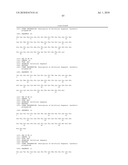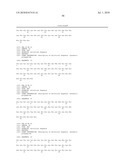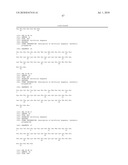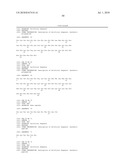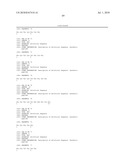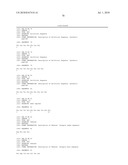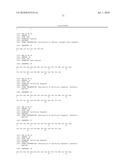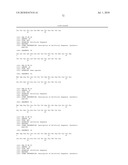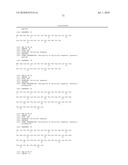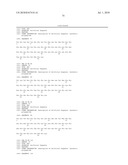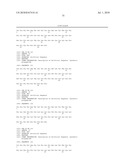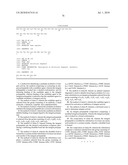Patent application title: STABILIZED LOW AFFINITY CONFORMATION OF INTEGRINS FOR DRUG DISCOVERY
Inventors:
Timothy A. Springer (Chestnut Hill, MA, US)
Bing Hao Luo (Baton Rouge, LA, US)
Assignees:
IMMUNE DISEASE INSTITUTE, INC.
IPC8 Class: AG01N3353FI
USPC Class:
436501
Class name: Chemistry: analytical and immunological testing biospecific ligand binding assay
Publication date: 2010-07-01
Patent application number: 20100167418
Claims:
1. A method for identifying a candidate modulator of integrin activity,
the method comprising (a) contacting an integrin polypeptide with a
candidate agent, wherein the integrin polypeptide is locked into a
desired conformation; and (b) detecting binding of the candidate agent to
the integrin polypeptide, wherein binding of the candidate agent to the
integrin polypeptide is indicative that the candidate agent is a
candidate modulator of integrin activity.
2. The method of claim 1, wherein the candidate agent is selected from the group consisting of an antibody, a small molecule, a chemical, a peptide, and a peptidomimetic.
3. The method of claim 1, wherein the candidate modulator stabilizes the integrin polypeptide into a closed conformation.
4. The method of claim 1, wherein the candidate modulator inhibits binding of an integrin ligand to the integrin polypeptide.
5. The method of claim 1, wherein the integrin polypeptide is selected from the group consisting of αVβ3, αIIbβ3, αVb6, αVβ1, αVβ5, αMβ2, αXβ2, αLβ2, and αVβ.sub.8.
6. The method of claim 1, wherein locking the integrin polypeptide into the desired conformation comprises introducing a stabilizing disulfide bond into the integrin polypeptide.
7. The method of claim 6, wherein the disulfide bond is formed by a cysteine residue substitution of at least one amino acid residue of the integrin polypeptide.
8. The method of claim 6, wherein the substitution comprises a mutation selected from the group consisting of: L959C (human αIIb), E960C (human αIIb), 1955C (human αV), Q956C (human αV), V664C (human β3), P688C (human β3), L662C (human β6), P686C (human β6), A619C (human β8), and F636C (human β3).
9. The method of claim 8, wherein an optimal sequence alignment is used to identify homologous residues for a cysteine substitution in an integrin polypeptide selected from the group consisting of αVβ3, αIIbβ3, αVb6, αVβ1, αVβ5, αMβ2, αXβ2, αLβ2, and αVβ.sub.8.
10. The method of claim 1, wherein the candidate agent is assayed for activation or inhibition of integrin activity.
11. The method of claim 9, wherein a cell-based assay is used to determine integrin activity.
12. An integrin polypeptide composition comprising: a modified integrin polypeptide, wherein the integrin polypeptide is locked in a closed conformation.
13. The composition of claim 12, wherein the integrin polypeptide is modified by substitution of at least one amino acid residue for a cysteine residue, whereby a disulfide bond is formed.
14. The composition of claim 13, wherein the substitution comprises a mutation selected from the group consisting of: L959C (human αIIb), E960C (human αIIb), I955C (human αV), Q956C (human αV), V664C (human β3), P688C (human β3), L662C (human β6), P686C (human β6), A619C (human β7), and F636C (human β3).
Description:
CROSS REFERENCE TO RELATED APPLICATIONS
[0001]This application claims the benefit under 35 U.S.C. §119(e) of U.S. Provisional Application No. 61/141,145 filed on Dec. 29, 2008, the contents of which are incorporated herein by reference in its entirety.
FIELD OF THE INVENTION
[0002]The field of the invention relates to stabilized integrins and uses thereof.
BACKGROUND
[0003]Integrins are cell adhesion receptors that transmit bidirectional signals across the plasma membrane and link the extracellular environment of a cell to the actin cytoskeleton. The conformation of the integrin extracellular domain and its affinity for ligand are dynamically regulated by a process termed "inside-out signaling." Rapid upregulation of adhesiveness of integrins on platelets and white blood cells mediates hemostasis and leukocyte trafficking to sites of inflammation. By coupling to the actin cytoskeleton, integrins promote firm adhesion and provide traction for lamellipodium protrusion and locomotion. In migrating cells the adhesiveness of integrins is spatially and temporally regulated so that integrins are activated near the leading edge to support lamellipod extension and deactivated near the trailing edge to support uropod retraction and internalization (Alon and Dustin, 2007; Arnaout et al., 2005; Broussard et al., 2008; Calderwood, 2004; Evans and Calderwood, 2007; Luo et al., 2007).
[0004]Integrin αIIbβ3, the most abundant receptor on platelets, binds to fibrinogen and von Willebrand factor, and mediates platelet aggregation and association with injured vessel walls. Inherited mutations in its αIIb or β3 subunits result in the bleeding disorder Glanzmann's thrombasthenia. RGD-mimetic small molecules and an antibody to αIIbβ3 are prescribed for the prevention of thrombosis ((Springer et al., 2008; Xiao et al., 2004).
[0005]The integrin α and β subunits have large N-terminal extracellular domains, single-pass transmembrane domains, and usually short C-terminal cytoplasmic domains. The first crystal structure of an integrin ectodomain, of αVβ3, represented a huge advance (Xiong et al., 2001; Xiong et al., 2002). Together with subsequent work, ten of twelve domains in the ectofragment were revealed in a bent conformation (Xiao et al., 2004; Xiong et al., 2004). A ligand-binding head formed by both subunits is followed by legs in each subunit that connect to the transmembrane domains. There is an extreme bend at knees between the upper and lower legs. Integrin epidermal growth factor-like (I-EGF) domains 1 and 2 at the β-knee were disordered in the previous αVβ3 structure. Crystals of β2 leg fragments containing I-EGF domains 1 and 2 have been solved in two different orientations (Shi et al., 2007), but the conformation of these domains in the bent integrin conformation remains unknown.
[0006]Subsequent to the αVβ3 crystal structure, mutational studies on cell surface integrins and EM studies on αVβ3, αLβ2, and αXβ2 integrins demonstrated that the bent conformation is the physiologically relevant, low affinity integrin conformation (Nishida et al., 2006; Takagi et al., 2002). Nonetheless, a cryo EM study on αIIbβ3 revealed a different, less compact conformation with a different arrangement of leg domains (Adair and Yeager, 2002). Furthermore, two recent studies have revealed extended conformations of αIIbβ3 but failed to find a bent conformation (Rocco et al., 2008; Ye et al., 2008). Crystal structure studies on αIIbβ3 are important to resolve these controversies. Revealing the structure within a complete ectodomain of the bent β-knee is important to understanding the mechanism of integrin extension. Moreover, no integrin crystal structure to date has described the bent structure in the light of current knowledge that it is physiologically relevant, is in a low-affinity state, and with the aim of understanding how the bent conformation is stabilized and how it transitions to extended conformations. The previous αVβ3 bent conformation was described as "not expected to occur in the membrane-bound receptor," and being in "its active (ligand competent) state" (Xiong et al., 2001).
[0007]Most studies find that upon activation, integrins extend. Upon extension, the headpiece can remain in the closed conformation, as when bent, or transition to an open conformation with high affinity for ligand (Xiao et al., 2004). In contrast, a "deadbolt model" posits that activation can occur in the absence of extension (Arnaout et al., 2005). Binding of cytoskeletal proteins such as talin and kindlins to the integrin β cytoplasmic domain appears to interfere with α/β cytoplasmic domain association, and induce integrin extension (Wegener and Campbell, 2008). However, there is currently no known feature of integrin structure that would enable cytoskeleton binding to couple to the extended, open conformation with high affinity for ligand. This would appear to be important to fulfill the key role of integrins in integrating the extracellular and intracellular environments.
[0008]Three closely linked metal ion binding sites in the β I domain are especially important in ligand binding. Mg2+ at the central, metal ion-dependent adhesion site (MIDAS) site directly coordinates the acidic sidechain shared by all integrin ligands. However, in previous unliganded, bent αVβ3 structures, the MIDAS and one adjacent site were unoccupied, and it was proposed that metal binding was either caused by integrin activation or induced by ligand binding (Xiong et al., 2002) However, crystals have not been reported with a combination of the two metal ions important for integrin ligand binding, Mg2+ and Ca2+. Therefore, in current comparisons between low and high affinity β I domain conformations, the changes associated with ligand binding and metal binding cannot be deconvoluted.
SUMMARY OF THE CLAIMS
[0009]The methods described herein are based in part on the discovery that a disulfide bond can be introduced to an integrin polypeptide by the substitution of at least one cysteine residue in the polypeptide. The disulfide bond(s) formed in the integrin polypeptide stabilize the integrin in a "closed/inactive" state, which permits the integrins to be screened for a candidate molecule that can bind to the closed state. In particular, this approach can be used to screen for agents that bind to the closed state of an integrin polypeptide, and would be useful as therapeutic treatments to prevent integrin activation.
[0010]In one aspect, the methods described herein relate to a method of identifying a candidate modulator of integrin activity, comprising (a) contacting an integrin polypeptide with a candidate agent, wherein the integrin polypeptide is locked into a desired conformation; and (b) detecting binding of the candidate agent to the integrin polypeptide, wherein binding of the candidate agent to the integrin polypeptide is indicative that the candidate agent is a candidate modulator of integrin activity.
[0011]In one embodiment of this aspect and all other aspects described herein, The method of the candidate agent is selected from the group consisting of an antibody, a small molecule, a chemical, a peptide, and a peptidomimetic.
[0012]In another embodiment of this aspect and all other aspects described herein, the candidate modulator stabilizes the integrin polypeptide into a closed conformation. Alternatively, the candidate modulator can induce a conformational shift from the open conformation to the closed conformation.
[0013]In another embodiment of this aspect and all other aspects described herein, the candidate modulator inhibits binding of an integrin ligand to the integrin polypeptide. Alternatively, the candidate modulator may act at a site distant from the integrin ligand site to prevent integrin-mediated activity in response to ligand binding--that is, ligand binding may occur but activation of the integrin activity is blocked (e.g., non-competitive inhibition).
[0014]In another embodiment of this aspect and all other aspects described herein, the integrin polypeptide is selected from the group consisting of αVβ3, αIIbβ3, αVb6, αVβ1, αVβ5, αMβ2, αXβ2, αLβ2, and αVβ8.
[0015]In another embodiment of this aspect and all other aspects described herein, wherein locking the integrin polypeptide into the desired conformation comprises introducing a stabilizing disulfide bond into the integrin polypeptide.
[0016]In another embodiment of this aspect and all other aspects described herein, the disulfide bond is formed by a cysteine residue substitution of at least one amino acid residue of said integrin polypeptide.
[0017]In another embodiment of this aspect and all other aspects described herein, the substitution comprises a mutation selected from the group consisting of: L959C (human αIIb), E960C (human αIIb), 1955C (human αV), Q956C (human αV), V664C (human β3), P688C (human β3), L662C (human β6), P686C (human β6), A619C (human β8), and F636C (human β3).
[0018]In another embodiment of this aspect and all other aspects described herein, the candidate agent is further assayed for activation or inhibition of integrin activity. In one embodiment, a cell-based assay is used to determine integrin activity.
[0019]Another aspect described herein is an integrin polypeptide composition stabilized in the "closed" conformation. In one embodiment, the integrin polypeptide is stabilized by substitution of at least one amino acid residue for a cysteine residue, wherein a disulfide bond is formed.
[0020]In another embodiment of this aspect and all other aspects described herein, the substitution comprises a mutation selected from the group consisting of: L959C (human αIIb), E960C (human αIIb), 1955C (human αV), Q956C (human αV), V664C (human β3), P688C (human β3), L662C (human β6), P686C (human β6), A619C (human β8), and F636C (human β3).
[0021]In another embodiment of this aspect, the composition further comprises a solid support such as a bead, a dish, a well, a plate, etc.
DEFINITIONS
[0022]As used herein, a "modified integrin I-domain polypeptide" or "modified integrin polypeptide" includes an integrin I-domain polypeptide that has been altered with respect to the wild-type sequence or the native state such that at least one disulfide bond has been introduced into the polypeptide thereby stabilizing the integrin in a desired conformation. An integrin polypeptide is considered "locked into a desired conformation" if the disulfide bond prevents a conformational shift in the integrin polypeptide from occurring under non-denaturing conditions (i.e., denaturing conditions can be induced by e.g., high temperatures, the presence of reducing agents (such as β-mercaptoethanol, dithiothreitol), the presence of strong denaturing reagents (such as 6M guanidinium hydrochloride, 8M urea, or 1% sodium dodecyl sulfate), or any combination thereof).
[0023]As used herein, the term "stabilizing disulfide bond" is used to describe substitution of at least one cysteine residue that permits the formation of a disulfide bond, which in turn prevents a conformational shift in the integrin polypeptide even in the presence of an activating ligand. The "stabilizing disulfide bond" is introduced to the polypeptide by one of skill in the art and does not reflect a natural or native disulfide bond of the polypeptide. However, it is contemplated that an integrin polypeptide with such a stabilizing disulfide bond can be found in nature due to a mutation in amino acid sequence.
[0024]As used herein, the term "binding of the candidate agent" refers to an interaction of a candidate agent with an integrin polypeptide stabilized in a closed conformation. Since the conformation of the integrin polypeptide is held in place by a disulfide bond, the term "binding" reflects an interaction and is insufficient to indicate the inhibitory or activating activity of the compound. Further screening assays for integrin activity, as described herein, should be used to determine the action of a candidate agent.
[0025]As used herein, the term "candidate agent" includes a compound or other agent that is capable of at least binding to an integrin polypeptide or modified polypeptide as described herein. In an alternative embodiment, the compound or agent is "a modulator of integrin activity," which is capable of modulating or regulating at least one integrin activity, as described herein. Modulators of integrin activity may include, but are not limited to, small organic or inorganic molecules, nucleic acid molecules, peptides, antibodies, and the like. A modulator of integrin activity can be an inducer or inhibitor of integrin-mediated activities such as cell adhesion or ligand binding. As used herein, an "inducer of integrin activity" stimulates, enhances, and/or mimics an integrin activity. As used herein, an "inhibitor of integrin activity" reduces, blocks or antagonizes an integrin activity.
[0026]As used interchangeably herein, the terms "integrin activity", or "integrin-mediated activity" refer to an activity exerted by an integrin polypeptide or nucleic acid molecule on an integrin responsive cell, or on integrin ligand or receptor, as determined in vitro and in vivo, according to standard techniques. In one embodiment, an integrin activity is the ability to mediate cell adhesion events, e.g., cell to cell, or cell to extracellular matrix adhesion. In another embodiment, an integrin activity can be measured as the ability to transduce cellular signaling events. In yet another embodiment, an integrin activity is the ability to bind a ligand, e.g., ICAM.
[0027]As used herein, the term "activation of integrin activity" refers to an increase in basal integrin activity of at least 10% as assessed using a cell-based integrin assay; preferably the activity of the integrin is increased by at least 20%, at least 30%, at least 40%, at least 50%, at least 60%, at least 70%, at least 80%, at least 90%, at least 95%, at least 99%, at least 1-fold, at least 2-fold, at least 5-fold, at least 10-fold, at least 50-fold, at least 100-fold, at least 1000-fold or higher than basal integrin activity in the same cell-based integrin assay.
[0028]As used herein, the term "inhibition of integrin activity" refers to a decrease in ligand activated integrin activity of at least 10% as assessed using a cell-based integrin assay; preferably the activity of the integrin is decreased by at least 20%, at least 30%, at least 40%, at least 50%, at least 60%, at least 70%, at least 80%, at least 90%, at least 95%, at least 99%, or even 100% (i.e., no activity) integrin activity in the same cell-based integrin assay.
[0029]As used herein the term "comprising" or "comprises" is used in reference to compositions, methods, and respective component(s) thereof, that are essential to the invention, yet open to the inclusion of unspecified elements, whether essential or not.
[0030]As used herein the term "consisting essentially of" refers to those elements required for a given embodiment. The term permits the presence of elements that do not materially affect the basic and novel or functional characteristic(s) of that embodiment of the invention.
[0031]The term "consisting of" refers to compositions, methods, and respective components thereof as described herein, which are exclusive of any element not recited in that description of the embodiment.
BRIEF DESCRIPTION OF THE FIGURES
[0032]FIG. 1. Disulfide bond formation in mutant receptors and effect on function. 293T cells were co-transfected with full-length, wild-type or mutant integrin subunits to express the indicated α/β pairs on the cell surface. A. Integrin heterodimers were immunoprecipitated from 35S-labeled cell detergent lysates with anti-β3 mAb AP3 and subjected to non-reducing SDS-PAGE and fluorography. Molecular size markers are shown on the left. B. Soluble fibrinogen binding to 293T transfectants in the presence of 1 mM Ca2+/1 mM Mg2+ (white) or 1 mM Mn2+ plus 10 mg/ml PT25-2 antibody (black). Binding was measured as the mean fluorescence intensity of FITC-conjugated fibrinogen staining as a percentage of mean fluorescence intensity of staining with Cy3-conjugated AP3 mAb. Methods were as described previously (Luo, et al. 2004; Zhu, et al. 2007).
[0033]FIG. 2. Disulfide formation efficiency of the αLβ2 cys mutants on cell surface. The lane numbers in the left panel correspond to the combination of αL and β2 subunits connected by lines shown in the right panel. #1 was not well expressed in this particular experiment.
[0034]FIG. 3. Expression level of disulfide locked αLβ2 mutants on 293T cell surface.
[0035]FIG. 4. Exemplary LFA-1 disulfide mutants on 293T cell.
[0036]FIG. 5. LFA-1 crosslinking on cell surface. A. Sequences around the cysteine mutations are shown. Cysteine mutations were introduced and are shown, and the names of each exemplary construct are labeled at the right. B. Expression of the tested α/β combinations was tested using a FACS assay to identify cell surface expression. Disulfide bond formation was detected by Western blotting of lysed cell after transfection. C. A schematic representation of the α/β combinations tested and shown in FIG. 2B.
[0037]FIG. 6. Soluble integrin αLβ2 (LFA-1) and αXβ2 (CR4) crosslinking and activation. A. C-terminal sequence of constructs used for soluble integrin expression. The cysteine mutations were introduced and are shown. The name of each construct is depicted at the right of each sequence. Tags and other features are labeled above the sequences. B. Exemplary α/β combinations were tested in transfection and protein purification experiments. Crosslinking was confirmed by SDS-PAGE after protein purification and TEV cleavage. C. Activation status of purified integrin proteins was monitored by KIM127 exposure in 1 mM Ca2+/Mg2+.
[0038]FIG. 7. Optimal sequence alignments of exemplary integrin alpha subunits. FIG. 7 includes a sequence alignment of AV_HU--45047636 (SEQ ID NO: 1), AV_MO--6680486 (SEQ ID NO: 2), A5_HU--124946 (SEQ ID NO: 3), A5_MO--6754378 (SEQ ID NO:4), A5--HU--124951 (SEQ ID NO: 5), A5_MO--12643835 (SEQ ID NO: 6), A5_HU--1706570 (SEQ ID NO: 7), A6_HU--4557675 (SEQ ID NO: 8), A6_MO--7110659 (SEQ ID NO: 9), A7_HU--450-4753 (SEQ ID NO: 10), A7_MO1--3378244 (SEQ ID NO: 11), A7_MO2--3378244 (SEQ ID NO: 12), A3_HU-11467963 (SEQ ID NO: 13), A3_MO--7305159 (SEQ ID NO: 14), A4_HU--4504749 (SEQ ID NO: 15), A4_MO--7110657 (SEQ ID NO: 16), A9_HU--2833247 (SEQ ID NO: 17), A1_HU--2829468 (SEQ ID NO: 18), A2_HU--4504743 (SEQ ID NO: 19), A2_MO--6680478 (SEQ ID NO: 20), A10_HU--6650625 (SEQ ID NO: 21), A11_HU--12643694 (SEQ ID NO: 22), AE--1HU--6007851 (SEQ ID NO: 23), AE_MO--6650452 (SEQ ID NO: 24), AD_HU--12643717 (SEQ ID NO: 25), AX_HU--4504765 (SEQ ID NO: 26), AX_MO--10946646 (SEQ ID NO: 27), AM_HU--1708572 (SEQ ID NO: 28), AM_MO--124956 (SEQ ID NO: 29), AL_HU--1170591 (SEQ ID NO: 30), and AL_MO--124953 (SEQ ID NO: 31).
[0039]FIG. 8. Optimal sequence alignments of exemplary integrin beta subunits. FIG. 8 includes a sequence alignment of sequences B1_HUMAN--4504767 (SEQ ID NO: 32), B1_MOUSE--124964 (SEQ ID NO: 33), B2_HUMAN--14780741 0332-H (SEQ ID NO: 34), B2_MOUSE--3183523 (SEQ ID NO: 35), B3_HUMAN--2119640 (SEQ ID NO: 36), B3_MOUSE--7949057 (SEQ ID NO: 37), B4_HUMAN--14768997 (SEQ ID NO: 38), B4_MOUSE--484-472 (SEQ ID NO: 39), B5_HUMAN--106776 (SEQ ID NO: 40), B5_MOUSE--3478697 y236-C (SEQ ID NO: 41), B6_HUMAN--9625002 (SEQ ID NO: 42), B6_MOUSE--10946686 (SEQ ID NO: 43), B7_HUMAN--4504777 (SEQ ID NO: 44), B7_MOUSE--7305193 (SEQ ID NO: 45), B8_HUMAN--4504779 (SEQ ID NO: 46), and PACTOLU_MOUSE--3287491 (SEQ ID NO: 47).
DETAILED DESCRIPTION
[0040]The methods described herein are based in part on the discovery that the introduction of a disulfide bond into an integrin polypeptide by the substitution of at least one cysteine residue in the polypeptide permits stabilization of the integrin in a "closed/inactive" state. This stabilizing disulfide bond permits integrins to be screened for a candidate molecule that can bind to the closed state. In particular, this approach can be used to screen for agents that bind to the closed state of an integrin polypeptide, and would be useful as therapeutic treatments to prevent integrin activation.
The αIIbβ3 crystal structure. A crystal structure for molecule I in αIIbβ3 crystals was determined and ribbon diagrams were prepared (data not shown). The following characteristics are noted. In one model, the αIIbβ3 is extended by torsion at the α and β-knees. Upon supersition of molecules 1 and 2 of αIIbβ3 and αVβ3 (Xiong et al., 2004) the structures indicate "breathing". It is determined that there is a variation in the distance of the lower α-leg from the lower β-leg, opening its cleft, and variation in the lower β-leg: αIIbβ3 molecule 1 and αVβ3. A view of the α-subunit only rotated about 90° indicates variation in the distance of the lower α-leg from the upper α-headpiece: αIIbβ3 molecule 1 and molecule 2; αVβ3. The headpieces of αIIbβ3 molecule 1 and αVβ3 show breathing at the β I/hybrid domain interface. Further information regarding the solved crystal structure for the αIibβ3 integrin can be found in a published paper by the inventors (Zhu, et al., Molecular Cell (2008) 32(6): 849-862).
Disulfide Bonds
[0041]Disulfide bond formation occurs between two cysteine residues that are appropriately positioned within the three-dimensional structure of an integrin polypeptide. In one embodiment of the invention, a polypeptide is stabilized in the closed conformation by introducing at least one cysteine substitution into the amino acid sequence such that a disulfide bond is formed. The introduction of a single cysteine substitution is performed in circumstances in which an additional cysteine residue is present in the native amino acid sequence of the polypeptide at an appropriate position such that a disulfide bond is formed. Alternatively, in another embodiment, two cysteine substitutions are introduced into the amino acid sequence of the polypeptide at positions that allow a disulfide bond to form, thereby stabilizing the polypeptide in a desired conformation.
[0042]In one embodiment of the invention, cysteine substitutions are introduced such that the formation of a disulfide bond is favored only in one protein conformation (i.e., a closed conformation), such that the protein is stabilized in that particular conformation.
[0043]Preparation of a modified Polypeptide of the invention by introducing cysteine substitutions can be achieved by mutagenesis of DNA encoding the integrin polypeptide of interest. For example, an isolated nucleic acid molecule encoding a modified integrin I-domain polypeptide can be created by introducing one or more nucleotide substitutions into the nucleotide sequence of an integrin gene such that one or more amino acid substitutions, e.g., cysteine substitutions, are introduced into the encoded protein. Mutations can be introduced into a nucleic acid sequence by standard techniques, such as site-directed mutagenesis and PCR-mediated mutagenesis.
[0044]Some non-limiting examples of substituted cysteine residues in α/β subunits include the following and are denoted with a bold, underlined C:
TABLE-US-00001 Subunit Human αIIb 946 RGEAQVWTQLLRACEERA- 963; Human αIIb 946 RGEAQVWTQLLRALCERA- 963; Human αv 942 TNSTLVTTNVTWGCQPAPM 960; Human αv 942 TNSTLVTTNVTWGICPAPM 960; Human β3 663 CCVRFQYYEDSS--GKSILYVVEEPECPKG 690; Human β3 663 CVVRFQYYEDSS--GKSILYVVEEPECCKG 690; Human β6 661 CCITFLITTDNE--GKTIIHSINEKDCPKP 688; Human β6 661 CLITFLITTDNE--GKTIIHSINEKDCCKP 688; Human β8 619 CCLMEQQ-----------HYVDQTSECFSS 637; and Human β8 619 CALMEQQ-----------HYVDQTSECCSS 637.
[0045]In another embodiment, the method of the invention can be used to stabilize a protein in a biologically inactive conformation, e.g., a conformation that is enzymatically inactive or does not have ligand binding capacity and/or effector functions, e.g., a "closed" conformation.
[0046]Proteins that are stabilized in a particular conformation find use in, for example, in proteomic screening technologies. In proteomic screens of tissues and disease states, antibodies, polypeptide, and/or small molecules that are specific for, e.g., an inactive protein conformer, can be used to assess the activity of different cellular signaling, metabolic, and adhesive pathways. Thus, associations can be made between specific diseases and the activation of specific biochemical and signaling pathways. Furthermore, the methods described herein relate to polypeptides, antibodies, and small molecules identified using the methods described herein and uses for same, e.g., to treat, for example, inflammatory disorders. Conformer-specific reagents can also be placed on chips and used to screen tissue extracts, or used to stain tissue sections. Furthermore, drugs or antibodies, e.g., anti-integrin antibodies which specifically recognize a modified integrin I-domain polypeptide, e.g., an anti-LFA-1 antibody which specifically recognizes a modified LFA-1 I-domain polypeptide, that are selective for a particular conformer, e.g., an open conformer or a closed conformer, may provide differential therapeutic effects. Therefore, selective screening assays using a protein stabilized in a particular conformer can be used to rationally obtain compounds with a desired activity.
Integrins
[0047]Integrins, exist on cell surfaces in an inactive conformation that does not bind ligand. Upon cell activation, integrins change shape (conformation) and can bind ligand. Over 20 different integrin heterodimers (different α and β subunit combinations) exist that are expressed in a selective fashion on all cells in the body. After activation, integrins bind in a specific manner to protein ligands on the surface of other cells, in the extracellular matrix, or that are assembled in the clotting or complement cascades. Integrins on leukocytes are of central importance in leukocyte emigration and in inflammatory and immune responses. Ligands for the leukocyte integrin Mac-1 (αMβ2) include the inflammation-associated cell surface molecule ICAM-1, the complement component iC3b, and the clotting component fibrinogen. Ligands for the leukocyte integrin LFA-1 (αLβ2) include ICAM-1, ICAM-2, and ICAM-3. Antibodies to leukocyte integrins can block many types of inflammatory and auto-immune diseases, by, e.g., modulating, or inhibiting, for example, cell to cell interactions, or cell to extracellular matrix interactions. Integrins on platelets are important in clotting and in heart disease and approved drugs that interact with platelet integrin function include the antibody abciximab (Reopro®) and the peptide-like antagonist eptifibatide (Integrilin®). Integrins on connective tissue cells, epithelium, and endothelium are important in disease states affecting these cells. They regulate cell growth, differentiation, wound healing, fibrosis, apoptosis, and angiogenesis. Integrins on cancerous cells regulate invasion and metastasis.
[0048]It is contemplated herein that an agent can be used to bind to integrins in the "closed conformation" in order to stabilize integrins in their off state and modify or prevent integrin activation.
[0049]One embodiment of the methods described herein provides a modified integrin I-domain polypeptide comprising at least one disulfide bond, such that the modified I-domain polypeptide is stabilized in a desired conformation. A modified integrin I-domain polypeptide of the invention may be derived from an I-domain of an integrin a subunit including α1, α2, α10, α11, αD, αV, αX, αM, αE, αL (CD11a), αM (CD11b) and αX (CD11c).
[0050]Also contemplated herein are integrins with conservative substitutions. Conservative substitutions (substituents) typically include the substitution of one amino acid for another with similar characteristics (e.g., charge, size, shape, and other biological properties) such as substitutions within the following groups: valine, glycine; glycine, alanine; valine, isoleucine; aspartic acid, glutamic acid; asparagine, glutamine; serine, threonine; lysine, arginine; and phenylalanine, tyrosine. The non-polar (hydrophobic) amino acids include alanine, leucine, isoleucine, valine, proline, phenylalanine, tryptophan and methionine. The polar neutral amino acids include glycine, serine, threonine, cysteine, tyrosine, asparagine and glutamine. The positively charged (basic) amino acids include arginine, lysine and histidine. The negatively charged (acidic) amino acids include aspartic acid and glutamic acid. It is also contemplated herein that a substitution can occur among amino acid groups with varying characteristics.
[0051]In other embodiments, derivatives with amino acid substitutions which are less conservative may also result in desired derivatives, e.g., by causing changes in charge, conformation and other biological properties. Such substitutions would include, for example, substitution of a hydrophilic residue for a hydrophobic residue, substitution of a cysteine or proline for another residue, substitution of a residue having a small side chain for a residue having a bulky side chain or substitution of a residue having a net positive charge for a residue having a net negative charge. When the result of a given substitution cannot be predicted with certainty, the derivatives may be readily assayed according to the methods disclosed herein to determine the presence or absence of the desired characteristics. The polypeptides and proteins as described herein may also be modified by various changes such as insertions, deletions and substitutions, either conservative or nonconservative where such changes might provide for certain advantages in their use.
[0052]In a preferred embodiment, a cysteine residue is substituted into the integrin polypeptide to permit the formation of a disulfide bond. In one embodiment, a modified integrin I-domain polypeptide of the invention is encoded by an amino acid sequence containing at least one cysteine substitution, or alternatively two cysteine substitutions, as compared to the wild-type sequence.
[0053]The introduction of cysteine residues at appropriate positions within the amino acid sequence of the I-domain polypeptide allows for the formation of a disulfide bond that stabilizes the domain in a particular conformation, e.g., an inactive "closed" conformation. For example, the αL L289C/K294C mutant and the αM Q163C/R313c mutants are stabilized in an inactive or "closed" conformation that does not bind ligand.
[0054]In one embodiment, described herein is a modified integrin I-domain which is comprised within an integrin subunit, and which may be further associated with an integrin β subunit. In another embodiment, a modified integrin I-domain polypeptide of the invention is a soluble polypeptide. Furthermore, the invention provides a modified integrin I-domain polypeptide which is operatively linked to a heterologous polypeptide. Modified integrin polypeptides of the invention include modified integrin I-domain and I-like domain polypeptides that are comprised within an integrin α or β subunit polypeptide, respectively; soluble modified integrin I-domain and I-like domain polypeptides; and modified integrin I-domain and I-like domain polypeptides that are operatively linked to a heterologous polypeptide, e.g., fusion proteins.
[0055]Some non-limiting examples of substituted cysteine residues in α/β subunits include the following and are denoted with a bold, underlined C:
TABLE-US-00002 Subunit Human αIIb 946 RGEAQVWTQLLRACEERA- 963; Human αIIb 946 RGEAQVWTQLLRALCERA- 963; Human αv 942 TNSTLVTTNVTWGCQPAPM 960; Human αv 942 TNSTLVTTNVTWGICPAPM 960; Human β3 663 CCVRFQYYEDSS--GKSILYVVEEPECPKG 690; Human β3 663 CVVRFQYYEDSS--GKSILYVVEEPECCKG 690; Human β6 661 CCITFLITTDNE--GKTIIHSINEKDCPKP 688; Human β6 661 CLITFLITTDNE--GKTIIHSINEKDCCKP 688; Human β8 619 CCLMEQQ-----------HYVDQTSECFSS 637; and Human β8 619 CALMEQQ-----------HYVDQTSECCSS 637.
[0056]The cDNAs, for multiple human integrin α and β subunit polypeptides have been cloned and sequenced, and the polypeptide sequences have been determined (see, for example, GenBank Accession Numbers: NM--002203 (α2), AF112345 (α10), NM--012211 (α1), NM--005353 (αD), NM--002208 (αE), NM--000887 (αX), NM--000632 (αM), NM--002209 (αL), X68742 and P56199 (α1), NM000211 (β2), NM--000212 (β3), NM--002214 (β8)). In addition, the sequences encoding integrin α and β subunit polypeptides from other species are available in the art. Furthermore, as described previously, three dimensional structure of the αM, αL, α1 and α2 I-domains has been solved (Lee, J-O, et al. (1995) Structure 3:1333-1340; Lee, J-O, et al. (199S) Cell 80:631-638; Qu, A and Leahy, D J (1995) Proc Natl Acad Sci USA 92:10277-10281; Qu, A and Leahy, D J (1996) Structure 4:931-942; Emsley, Jet al. (1997) J Biol Chem 272:28512-28517; Baldwin, E T et al. (1998) Structure 6:923-935; Kallen, J et al. (1999) J Mol Biol 292:1-9).
[0057]Isolated modified integrin polypeptides as described herein preferably have an amino acid sequence that is sufficiently identical to the amino acid sequence of a native integrin polypeptide, yet which comprise at least one, and alternatively two cysteine substitutions, such that a disulfide bond is formed that stabilizes the polypeptide in a desired conformation. As used herein, the term "sufficiently identical" refers to an amino acid (or nucleotide) sequence which contains a sufficient or minimum number of identical or equivalent (e.g., an amino acid residue that has a similar side chain) amino acid residues (or nucleotides) to an integrin amino acid (or nucleotide) sequence such that the polypeptide shares common structural domains or motifs, and/or a common functional activity with a native integrin polypeptide. For example, amino acid or nucleotide sequences which share at least 30%, 40%, or 50%, preferably 60%, more preferably 70%, 75%, 80%, 85% or 90%, 91%, 92%, 93%, 94%, 95% or greater identity and share a common functional activity (e.g., an activity of a modified integrin I-domain or I-like domain as described herein) are defined herein as sufficiently identical. An integrin I-domain polypeptide may differ in amino acid sequence from the integrin polypeptides disclosed herein due to natural allelic variation or mutagenesis.
[0058]To determine the percent identity of two amino acid sequences or of two nucleic acid sequences, the sequences are aligned for optimal comparison purposes (e.g., gaps can be introduced in one or both of a first and a second amino acid or nucleic acid sequence for optimal alignment and non-identical sequences can be disregarded for comparison purposes). In a preferred embodiment, the length of a reference sequence aligned for comparison purposes is at least 30%, preferably at least 40%, more preferably at least 50%, even more preferably at least 60%, and even more preferably at least 70%, 80%, or 90% of the length of the reference sequence. The amino acid residues or nucleotides at corresponding amino acid positions or nucleotide positions are then compared. When a position in the first sequence is occupied by the same amino acid residue or nucleotide as the corresponding position in the second sequence, then the molecules are identical at that position (as used herein amino acid or nucleic acid "identity" is equivalent to amino acid or nucleic acid "homology"). The percent identity between the two sequences is a function of the number of identical positions shared by the sequences, taking into account the number of gaps, and the length of each gap, which need to be introduced for optimal alignment of the two sequences.
[0059]The comparison of sequences and determination of percent identity between two sequences can be accomplished using a mathematical algorithm. In one embodiment, the percent identity between two amino acid sequences is determined using the Needleman and Wunsch (J. Mol. Biol. (48):444-453 (1970)) algorithm which has been incorporated into the GAP program in the GCG software package (available on the world wide web at gcg.com), using either a Blossom 62 matrix or a PAM250 matrix, and a gap weight of 16, 14, 12, 10, 8, 6, or 4 and a length weight of 1, 2, 3, 4, 5, or 6. In another embodiment, the percent identity between two nucleotide sequences is determined using the GAP program in the GCG software package (available on the world wide web at gcg.com), using a NWSgapdna.CMP matrix and a gap weight of 40, 50, 60, 70, or 80 and a length weight of 1, 2, 3, 4, 5, or 6. In another embodiment, the percent identity between two amino acid or nucleotide sequences is determined using the algorithm of E. Meyers and W. Miller (Comput. Appl. Biosci., 4:11-17 (1988)) which has been incorporated into the ALIGN program (version 2.0), using a PAM120 weight residue table, a gap length penalty of 12 and a gap penalty of 4.
[0060]Alternatively, sequences aligned for optimal comparison purposes can be used to find residues that are homologous among a variety of α or β integrin subunits, such that substitution of a cysteine residue known to stabilize an integrin in a closed conformation in one isoform can be extended to another isoform. One of skill in the art can readily align sequences in an optimal manner to determine a preferred site for cysteine substitution. Provided herein are sequences aligned in an optimal manner for the purpose of determining a preferred site for cysteine substitution. For example, mutation sites in αVβ1, and αVβ5 can be determined from alignment with αVβ6 and αVβ8 sequences. Alternatively, mutation sites in αMβ2 can be determined from alignment with the αXβ2 sequence.
[0061]In one embodiment, modified integrin polypeptides are produced by recombinant DNA techniques. For example, a modified integrin polypeptide can be isolated from a host cell transfected with a polynucleotide sequence encoding a modified integrin polypeptide (e.g., a I-domain polypeptide or a soluble I-domain fusion protein) using an appropriate purification scheme using standard protein purification techniques. Alternative to recombinant expression, a modified integrin polypeptide can be synthesized chemically using standard peptide synthesis techniques.
Integrins and Disease
[0062]Integrins are key targets in many diseases. Accordingly, isolated high affinity I-30 domains of the invention, as well as antibodies, or small molecule antagonists selective for activated leukocyte integrins can be used to modulate, e.g., inhibit or prevent, autoimmune and inflammatory disease, transplant rejection, ischemia/reperfusion injury as in hypovolemic shock, myocardial infarct, and cerebral shock. Furthermore, co-crystals of high affinity I domains bound to natural ligands and/or small molecule antagonists can readily be made, which will enable computational drug design, and advance modification and improvement of drug development candidates.
[0063]Accordingly, in one aspect the methods described herein provide a method for identifying a modulator of integrin activity comprising assaying the ability of a test compound to bind to a modified integrin I-domain polypeptide which is stabilized in the closed conformation. In another embodiment, the invention provides a method for identifying a compound capable of modulating the interaction of an integrin and a cognate ligand wherein binding of a ligand to a modified integrin I-domain polypeptide, which is stabilized in the closed conformation, is assayed in the presence and absence of a test compound.
[0064]As used herein, an integrin mediated disorder includes, for example, an inflammatory or immune system disorder, and/or a cellular proliferative disorder. Examples of integrin-mediated disorders include myocardial infarction, stroke, restenosis, transplant rejection, graft versus host disease or host versus graft disease, and reperfusion injury. An inflammatory or immune system disorder includes, but is not limited to adult respiratory distress syndrome (ARDS), multiple organ injury syndromes secondary to septicemia or trauma, viral infection, inflammatory bowel disease, ulcerative colitis, Crohn's disease, leukocyte adhesion deficiency II syndrome, thermal injury, hemodialysis, leukapheresis, peritonitis, chronic obstructive pulmonary disease, lung inflammation, asthma, acute appendicitis, dermatoses with acute inflammatory components, wound healing, septic shock, acute glomerulonephritis, nephritis, amyloidosis, reactive arthritis, rheumatoid arthritis, chronic bronchitis, Sjorgen's syndrome, sarcoidosis, scleroderma, lupus, polymyositis, Reiter's syndrome, psoriasis, dermatitis, pelvic inflammatory disease, inflammatory breast disease, orbital inflammatory disease, immune deficiency disorders (e.g., HIV, common variable immunodeficiency, congenital X-linked infantile hypogammaglobulinemia, transient hypogammaglobulinemia, selective IgA deficiency, necrotizing enterocolitis, granulocyte transfusion associated syndromes, cytokine-induced toxicity, chronic mucocutaneous candidiasis, severe combined immunodeficiency), autoimmune disorders, and acute purulent meningitis or other central nervous system inflammatory disorders.
Screening Assays
[0065]The methods described herein (also referred to herein as a "screening assay") can be used to identify modulators, i.e., candidate or test compounds or agents (e.g., peptides, antibodies, peptidomimetics, small molecules (organic or inorganic) or other drugs) which modulate integrin activity. These assays are designed to identify compounds, for example, that bind to an integrin I-domain polypeptide, e.g., an integrin I-domain polypeptide in an active conformation, binds to other proteins that interact with an integrin I-domain polypeptide, induce binding, and modulate the interaction of an integrin I-domain polypeptide with other proteins, e.g., an integrin ligand, e.g., ICAM, and thus modulate integrin activity.
[0066]In the case of an integrin stabilized in the closed conformation, a lack of integrin activity indicates that the integrin is stabilized in the "off" position. In order to screen candidate modulators that bind to this particular conformation, it is necessary to measure binding of the candidate agent to the integrin, rather than assessing integrin activity. Binding assays are known in the art and can be achieved using e.g., radioligand binding assays or fluorescence-detected binding. Candidate modulators that are capable of binding an integrin stabilized in a desired conformation will need to be confirmed as an inhibitor or stimulator of integrin activity using an integrin that is not stabilized in a particular confirmation. Integrin activity assays for such purposes are well known in the art and/or are described herein.
[0067]In an alternate embodiment, a soluble, recombinant high affinity integrin I-domain can be used to screen for small molecule antagonists that interfere with integrin ligand binding. Furthermore, antagonists, e.g., antibodies, with direct/competitive and indirect/noncompetitive modes of inhibition can be discriminated, based on comparison with effects on wild-type integrin I-domains which show minimal ligand binding activity. For example, an indirect inhibitor should inhibit ligand binding by an activated, wild-type integrin I-domain, but not by a disulfide-locked high affinity I-domain.
[0068]In another embodiment, an assay is a cell-based assay comprising contacting a cell expressing a modified integrin polypeptide on the cell surface with a test compound and determining the ability of the test compound to modulate (e.g., induce or inhibit) an integrin activity. For example, a cell expressing a modified integrin I-domain polypeptide stabilized in an open conformation on the cell surface is contacted with a test compound, and the ability of the test compound to modulate adhesion to an integrin ligand is determined, as described herein.
[0069]In another embodiment, the ability of a test compound to modulate integrin ligand binding can also be determined, for example, by coupling a modified integrin I-domain polypeptide that is stabilized in e.g., an open conformation with a detectable label such that the binding of the modified integrin polypeptide can be determined by detecting the amount of labeled integrin I-domain binding to an immobilized integrin ligand.
[0070]Animal-based model systems, such as an animal model of inflammation, may be used, for example, as part of screening strategies designed to identify compounds which are modulators of integrin activity. Thus, the animal-based models may be used to identify drugs, pharmaceuticals, therapies and interventions which may be effective in modulating inflammation and treating integrin-mediated disorders. For example, animal models may be exposed to a compound suspected of exhibiting an ability to modulate integrin activity, and the response of the animals to the exposure may be monitored by assessing inflammatory activity before and after treatment. Transgenic animals, e.g., transgenic mice, which express modified integrin I-domain polypeptides as described herein can also be used to identify drugs, pharmaceuticals, therapies and interventions which may be effective in modulating inflammation and treating integrin-mediated disorders
[0071]In another aspect, the methods described herein pertain to a combination of two or more of the assays described herein. For example, a modulator of integrin activity can be identified using a cell-based assay, and the ability of the agent to modulate integrin activity can be confirmed in vivo, e.g., in an animal such as an animal model for inflammation.
[0072]Moreover, screening assays can be used to identify inducers of integrin activity, for example, that mimic the activity of a integrin polypeptide, e.g., the binding of an integrin to a ligand or receptor, or the activity of an integrin towards an integrin responsive cell. Such compounds may include, but are not limited to, peptides, antibodies, or small organic or inorganic compounds. An anti-integrin antibody, e.g., an anti-LFA-1 antibody, which selectively binds to an open, activated conformer can be used to assess the ability of a test compound to activate, inactivate, or prevent activation of an integrin.
[0073]The test compounds can be obtained using any of the numerous approaches in combinatorial library methods known in the art, including: biological libraries; spatially addressable parallel solid phase or solution phase libraries; synthetic library methods requiring deconvolution; the `one-bead one-compound` library method; and synthetic library methods using affinity chromatography selection. The biological library approach is limited to peptide libraries, while the other four approaches are applicable to peptide, non-peptide oligomer or small molecule libraries of compounds (Lam, K. S. (1997) Anticancer Drug Des. 12:145).
[0074]Examples of methods for the synthesis of molecular libraries can be found in the art, for example in: DeWitt et al. (1993) Proc. Natl. Acad. Sci. U.S.A. 90:6909; Erb et al. (1994) Proc. Natl. Acad. Sci. USA 91:11422; Zuckermann et al. (1994). J. Med. Chem. 37:2678; Cho et al. (1993) Science 261:1303; Carrell et al. (1994) Angew. Chem. Int. Ed. Engl. 33:2059; Carell et al. (1994) Angew. Chem. Int. Ed. Engl. 33:2061; and in Gallop et al. (1994) J. Med. Chem. 37:1233.
[0075]Libraries of compounds may be presented in solution (e.g., Houghten (1992) Biotechniques 13:412-421), or on beads (Lam (1991) Nature 354:82-84), chips (Fodor (1993) Nature 364:555-556), bacteria (Ladner U.S. Pat. No. 5,223,409), spores (Ladner U.S. Pat. No. '409), plasmids (Cull et al. (1992) Proc Natl Acad Sci USA 89:1865-1869) or on phage (Scott and Smith (1990) Science 249:386-390); (Devlin (1990) Science 249:404-406); (Cwirla et al. (1990) Proc. Natl. Acad. Sci. 87:6378-6382); (Felici (1991) J. Mol. Biol. 222:301-310); (Ladner supra.).
[0076]The methods described herein further pertain to novel agents identified by the above-described screening assays. With regard to intervention, any treatments which modulate integrin activity and/or inflammatory activity should be considered as candidates for human therapeutic intervention.
Other Embodiments
[0077]Reported herein are disulfide bonds between integrin α and β subunits in their C-terminal domains or in the linkers between these C-terminal domains and the transmembrane domain. These disulfides may be used in either intact integrins on the cell surface or truncated extracellular domain fragments. The results with disulfide bonds introduced into cell surface integrins are predictive of those that can be successfully introduced into extracellular domain fragments.
[0078]Also shown herein are disulfide bonds that stabilize integrins in the bent, low affinity conformation. The stabilized integrins bind ligands and ligand-mimetic Fab less well. The stabilized integrins have utility for screening for conformation-dependent antibodies and drug molecules. Antibodies and drugs may be identified that are selective for the active, non-bent, or inactive, bent integrins, using either cell surface integrins or extracellular domain fragments.
[0079]In addition, stabilized integrins on cells, in comparison with wild-type integrins, can be used to select for antibodies selective for the bent, inactive conformation or extended, active conformation. Alternatively, stabilized and wild-type ectodomain integrin fragments can be used to screen for drugs selective for the bent inactive conformation. Such drugs would bind to and stabilize the bent, inactive conformation, but not the extended, active conformation. Thus they would represent a novel class of non-competitive integrin antagonists.
[0080]The present invention may be as described in any one of the following numbered paragraphs. [0081]1. A method for identifying a candidate modulator of integrin activity, the method comprising (a) contacting an integrin polypeptide with a candidate agent, wherein the integrin polypeptide is locked into a desired conformation; and (b) detecting binding of the candidate agent to the integrin polypeptide, wherein binding of the candidate agent to the integrin polypeptide is indicative that the candidate agent is a candidate modulator of integrin activity. [0082]2. The method of paragraph 1, wherein the candidate agent is selected from the group consisting of an antibody, a small molecule, a chemical, a peptide, and a peptidomimetic. [0083]3. The method of paragraph 1 or 2, wherein the candidate modulator stabilizes the integrin polypeptide into a closed conformation. [0084]4. The method of paragraphs 1, 2, or 3 wherein the candidate modulator inhibits binding of an integrin ligand to the integrin polypeptide. [0085]5. The method of any one of paragraphs 1-4, wherein the integrin polypeptide is selected from the group consisting of αVβ3, αIIbβ3, αVb6, αVβ1, αVβ5, αMβ2, αXβ2, αLβ2, and αVβ8. [0086]6. The method of any one of paragraphs 1-5, wherein locking the integrin polypeptide into the desired conformation comprises introducing a stabilizing disulfide bond into the integrin polypeptide. [0087]7. The method of any one of paragraphs 1-6, wherein the disulfide bond is formed by a cysteine residue substitution of at least one amino acid residue of the integrin polypeptide. [0088]8. The method of any one of paragraphs 1-7, wherein the substitution comprises a mutation selected from the group consisting of: L959C (human αIIb), E960C (human αIIb), 1955C (human αV), Q956C (human αV), V664C (human β3), P688C (human β3), L662C (human β6), P686C (human β6), A619C (human β8), and F636C (human β3). [0089]9. The method of any one of paragraphs 1-8, wherein an optimal sequence alignment is used to identify homologous residues for a cysteine substitution in an integrin polypeptide selected from the group consisting of αVβ3, αIIbβ3, αVb6, αVβ1, αVβ5, αMβ2, αXβ2, αLβ2, and αVβ8. [0090]10. The method of any one of paragraphs 1-9, wherein the candidate agent is assayed for activation or inhibition of integrin activity. [0091]11. The method of any one of paragraphs 1-10, wherein a cell-based assay is used to determine integrin activity. [0092]12. An integrin polypeptide composition comprising: a modified integrin polypeptide, wherein the integrin polypeptide is locked in a closed conformation. [0093]13. The composition of paragraph 12, wherein the integrin polypeptide is modified by substitution of at least one amino acid residue for a cysteine residue, whereby a disulfide bond is formed. [0094]14. The composition of paragraph 12 or 13, wherein the substitution comprises a mutation selected from the group consisting of: L959C (human αIIb), E960C (human αIIb), 1955C (human αv), Q956C (human αV), V664C (human β3), P688C (human β3), L662C (human β6), P686C (human β6), A619C (human β8), and F636C (human β3).
EXAMPLES
Example 1
Structure of a Complete Integrin Ectodomain
[0095]Herein the inventors describe a crystal structure of platelet integrin αIIbβ3 in the bent conformation useful for screening for agents that bind to the integrin in its bent conformation. Crystals in Ca2+ and Mg2+ show that physiologically in the low affinity state the metal binding sites in the β I domain are fully occupied. Of two different αIIbβ3 molecules in the asymmetric unit, one has density for all integrin domains. Thus, the conformation in the bent state is revealed of I-EGF domains 1 and 2 at the β-knee, at the epicenter of conformational change. The overall structure, the linkages between domains, the arrangement of the legs within the bent structure, and the effect of hybrid domain swing-out on affinity for ligand, have profound implications for the mechanism of integrin activation. Use of this information in models of extended integrins experiencing forces at sites of cell adhesion reveals how integrin affinity is regulated by force exerted parallel to the membrane by a motile actin cytoskeleton. Integrin structure and mechanochemistry provides a natural mechanism for increasing integrin affinity upon cytoskeleton attachment and decreasing it upon cytoskeleton disassembly.
αIIbβ3 Crystal Structure and Negative Stain EM
[0096]A 2.55 Å resolution crystal structure of the complete αIIbβ3 ectodomain in Ca2+ and Mg2+ has been refined to an Rfree of 26.8% (FIG. 1A, Table 1). In comparisons to αVβ3 below, differences in resolution and refinement should be kept in mind. The 3.1 Å αVβ3 structure is refined to an Rfree of 36.7% (Xiong et al., 2004). αIIbβ3 has 95% and 0.4% residues in favored and outlier Ramachandran regions, respectively, and geometry in the 98th percentile (where 100 is the best); whereas αVβ3 has 76% and 6.7% residues in favored and outlier regions, respectively, and geometry in the 21st percentile; all values are as reported by MOLPROBITY (Davis et al., 2007). Water molecules, which have important roles in protein structures such as in forming hydrogen bonds and metal coordinations, have been added to the αIIbβ3 but not to the αVβ3 structure, as appropriate for their respective resolutions. No cis-prolines are present in the αVβ3 structure, whereas 6 are present in the αIIbβ3 structure. Two of the cis-prolines, Pro-163 and Pro-169, are in the ligand-binding β3 I domain. The region around cis-Pro-169 has an electron density typical for the αIIbβ3 structure. There is a shift in the sequence-to-structure register between αVβ3 and αIIbβ3 at β3 167-176, in the specificity-determining loop that forms the outer rim of the ligand-binding pocket in the β3 I domain. Thus, with its higher resolution and better refinement, the αIIbβ3 structure provides details about backbone conformation, hydrogen bonding, and side-chain packing that are important for understanding ligand and metal binding; and for accurate molecular dynamics simulations and structure-guided mutagenesis. Furthermore, for the first time, the structure factors for an integrin ectodomain have been deposited, opening access to the experimental electron density upon which the atomic models are based.
[0097]Overall bent structure. The overall arrangement of domains in the two independent αIIbβ3 molecules in the crystal asymmetric unit is similar to that seen in αVβ3 crystals (FIG. 1C), except for differences in angles between domains described below that give insights into breathing. A similar bent conformation in solution in physiologic divalent cations is seen for three distinct αIIbβ3 constructs in negative stain EM with class averaging (FIG. 1F-H). The bent integrins from the three types of constructs are indistinguishable from one another (FIG. 1F panels 1-3, G panels 1-2, H panels 1-4) and show excellent cross-correlation with the αIIbβ3 crystal structure (FIG. 1F panels 1 and 5, G panels 1 and 5, and H, panels 1, 5 and 6). One construct was clasped by appending to the α and β ectodomain C-termini 15-residue linkers containing TEV protease sites, followed by ACID and BASE peptides that associate in an α-helical coiled-coil (Nishida et al., 2006). Association near the C-termini of the α and β subunit ectodomains that is provided in vivo by the association between the αIIb and β3 transmembrane domains (Luo et al., 2004) is mimicked by the clasp (Takagi et al., 2002). The clasped αIIbβ3 particles were 64% bent and 32% extended (with 4% unclassified) (FIG. 1F). Unclasped particles, in which the clasp was removed with TEV protease, were 44% bent and 52% extended (FIG. 1G). A third construct, which was identical to that used in crystallization, contained cysteines introduced in C-terminal portions of the αIIb and β3 subunits in positions that resulted in efficient disulfide bond formation in cell surface integrins (FIG. 2). These mutations, αIIb-L959C and β3-P688C, stabilized the integrin in a bent, closed conformation that closely mimics the bent, closed conformation seen in the clasped and unclasped constructs that lack this disulfide. The disulfide-bonded construct was 100% bent (FIG. 1H).
[0098]The differing proportion of bent particles in the three preparations shows that tighter association near the C-termini correlated with maintenance of the bent conformation, and also, with resistance to activation on the cell surface (FIG. 2). This is in agreement with work on other soluble integrin preparations, and a large body of work on cell surface integrins, which has shown that association of the α and β subunit transmembrane and cytoplasmic domains stabilizes integrins in the low-affinity state and in the bent conformation (Luo et al., 2007).
[0099]Similar bent conformations have previously been described in EM studies of the resting states of αVβ3, αXβ2, and αLβ2 (Nishida et al., 2006; Takagi et al., 2002). Furthermore, extensive studies using mutations and antibodies to ligand-induced binding sites show that αIIbβ3 is compact on the cell surface when resting, and extended when activated (Honda et al., 1995; Luo et al., 2007). The similarity in packing of two independent examples of αIIbβ3 and of αVβ3 in crystal lattices and similar appearance of multiple soluble integrins in EM, together with the work cited above, strongly suggests that the bent crystal structure determined here is representative of the resting state of most, if not all, integrins. However, three cryo EM, EM, and hydrodynamic studies of detergent soluble αIIbβ3 from platelets have reached conclusions that are incompatible with one another, and with the domain arrangement seen here (Adair and Yeager, 2002; Rocco et al., 2008; Ye et al., 2008). The difficulty in obtaining a consensus view on αIIbβ3 structure may reflect the delicate equilibrium between bent and extended structures (FIG. 1G-H), averaging over ensembles of bent and extended conformations, the poor association of the αIIb and β3 transmembrane domains in detergent (Wegener and Campbell, 2008), and the ease with which the αIIb and β3 subunits dissociate, even on the platelet surface (Luo et al., 2003).
[0100]Conceptual advances since the previously described αVβ3 crystal structures allow us to describe the bent αIIbβ3 crystal structure in light of its physiological relevance as the low affinity integrin state, and as the starting point for integrin extension. Furthermore, the αIIbβ3 structure reveals I-EGF domains 1 and 2, and a highly acute bend between them in the bent conformation (FIG. 1A). In contrast, I-EGF domains 2, 3, and 4 extend in an almost straight orientation, with an approximate 90° left-handed twist between successive domains, to cover most of the length of the lower β-leg (FIG. 1A). The β-knee, at the junction between I-EGF1 and I-EGF2, is flanked on one side by the PSI domain and on the other by a knob-like projection in the thigh domain (FIG. 1A).
[0101]In the view in FIG. 1A, the lower α-leg is in front of the upper α-leg, whereas the lower β-leg is to the right of the upper β-leg, between it and the α-subunit. In other words, the bent α and β-legs are oriented approximately at right angles rather than parallel to one another. Thus the I-EGF domains of the lower β-leg are deeply buried in a narrow crevice between the upper β-leg on one side and the lower α-leg on the other, with the β I and β-propeller domains helping to form the back of the crevice (FIG. 1A). Exit of the β leg from the crevice appears to be the key step in integrin extension.
[0102]Overall extended structure. In the extended conformation of αIIbβ3, the α and β -legs straighten at the knees, and extend away from rather than fold up against the headpiece (FIGS. 1F and G, panel 4). The headpiece fragment excised from the crystal structure cross-correlates excellently with the headpiece seen in EM (FIGS. 1F and G, panels 6-8). Furthermore, cross-correlation demonstrated that in Ca2+ and Mg2+, extended αIIbβ3 predominantly assumes the closed headpiece conformation with low affinity for ligand, as seen in the bent crystal structure, rather than the open conformation with high affinity. Most extended class averages, whether with clasped or unclasped αIIbβ3, show the α-leg crossing over or under the β-leg (FIG. 1F, G, panel 4). Leg crossing appears to be a consequence of upper leg configuration in the bent conformation with the long axis of 1-EGF1 pointing toward the α-knee (FIG. 1A). When the bent crystal structure is extended at the α and β-knees, leg crossing results. However, the legs are highly flexible, and for clarity are shown side-by-side in FIG. 1B. Extended integrins with crossed and uncrossed legs have also been seen for activated αVβ3, αXβ2, and detergent soluble αIIbβ3 integrins (Iwasaki et al., 2005; Nishida et al., 2006; Takagi et al., 2002).
[0103]After physiological activation of αIIbβ3 on platelets or treatment with high concentrations of ligands, multiple ligand-induced binding site (LIBS) epitopes are exposed. These epitopes map to the lower β-leg, and to the PSI domain (Honda et al., 1995). The lower β-leg is buried in a cleft in the bent conformation (FIG. 1A), but will be exposed in the extended conformation (FIG. 1B). Similarly, the LIBS epitope in the PSI domain, mapped to residues 1-6 (Honda et al., 1995), is masked by I-EGF2 in the bent conformation (FIG. 1A). By contrast, this epitope is exposed after extension at the I-EGF1/I-EGF2 interface in the β-knee brings I-EGF2 away from the PSI domain (FIG. 1B). The previous functional studies, together with the location of these epitopes within the αIIbβ3 structure, demonstrate that bent and extended αIIbβ3 represent latent and activated integrins, respectively, contradict suggestions that αIIbβ3 is extended in the resting state (Rocco et al., 2008; Ye et al., 2008), and agree with election tomography of active, detergent soluble αIIbβ3 showing that it is extended (Iwasaki et al., 2005).
Methods
Crystallography
[0104]Briefly, αIIb and β3 ectodomains were fused to C-terminal segments containing a tobacco etch protease (TEV) site, ACID or BASE coiled-coils, and strep II or His6 tags, with or without αIIb-L959C and β3-P688C mutations to introduce a disulfide bond. Proteins were purified from CHO Lec 3.2.8.1 cell supernatants. αIIbβ3 with the extra disulfide bond and the C-terminal tag removed by TEV protease in buffer containing 1 mM CaCl2 was crystallized in 10% PEG 3350, 50 mM magnesium acetate, and 0.1 M imidazole, pH 7.0. Diffraction data collected at 19-ID of APS was solved using molecular replacement in space group P41. Final refinement with REFMAC5 utilized TLS and NCS. Crystals of the αIIbβ3 ectodomain contain two molecules per asymmetric unit. Density is present for all ectodomain residues (αIIb 1-959 and β3 1-690) except for five loops, and in one molecule, the C-terminal portion of the β-tail domain. Thirteen or 18 N-linked carbohydrate residues are visualized in each molecule. I-EGF1 from the complete αIIb β3 ectodomain was used to model density for this domain in re-refined αIIb β3 headpiece structures with (Springer et al., 2008) or without Fab (Table 1).
Negative stain EM
[0105]The clasped and unclasped αIIbβ3 was purified on a Superdex 200 HR column equilibrated with TBS plus 1 mM Ca2+ and 1 mM Mg2+. The peak fraction was adsorbed to glow discharged carbon-coated copper grids, stained with uranyl formate, and inspected with an FEI Tecnai 12 electron microscope operated at 120 kV. Images were acquired at a nominal magnification of 67,000×. Imaging plates were scanned and digitized with a Ditabis micron imaging plate scanner (DITABIS Digital Biomedical Imaging System, AG, Pforzheim, Germany) using a step size of 15 μm and 2×2 pixels were averaged to yield a final pixel size of 4.46 Å at the specimen level. 2,000-5,000 particles were interactively collected, windowed into 75×75-pixel individual images, and subjected to ten cycles of multi-reference alignment and classification. Image processing and cross-correlation using the SPIDER image processing package (Frank et al., 1996) was as described previously (Nishida et al., 2006).
Example 2
Disulfide-Stabilized Integrins for Antibody, Ligand-Binding and Drug Screening
Methods
Production of Soluble αIIbβ3
[0106]DNA constructs of the extracellular domains of soluble αIIbβ3 were made and expressed as described previously (Takagi, et al), or with modifications as described below to introduce an additional disulfide. αIIb extracellular domain residues 1-963 were fused with a tobacco etch virus (TEV) protease site, acidic coiled coil and StrepII tag to give the C-terminal sequence QLLRALEERA/TGGLENLYFQGGENAQCEKELQALEKENAQLEWELQALEKELAQWSH PQFEK, where the slash marks the fusion position, and then inserted into the pcDNA3.1 vector with hygromycin resistance gene. β3 extracellular domain residues 1-690 were fused with a TEV protease site, basic coiled coil and His6 tag to give the C-terminal sequence VVEEPECPKG/TSGLENLYFQGGKNAQCKKKLQALKKKNAQLKWKLQALKKKLAQGG HHHHHH, where the slash marks the fusion position, and then inserted into the pEF1 vector with the puromycin resistance gene. Cysteine mutations αIIb-L959C and β3-P688C were introduced at the underlined positions in the above sequences using a site-directed mutagenesis kit. Plasmid DNA of the αIIb and β3 constructs was co-transfected into CHO Lec 3.2.8.1 cells using electroporation. Cells were cultured in selection medium containing puromycin and hygromycin for about 10 days until single colonies were obtained. ELISA was used with mAb 7E3 as the capturing antibody and biotinylated mAb AP3 as the detecting antibody to screen for clones with high expression cell lines. Three rounds of screening of approximately 150 colonies yielded one clone (clone #11) with an expression level of about 5 mg/L for the disulfide-bonded construct. The clone was expanded and cultured in roller bottles.
[0107]The culture supernatant was concentrated by ultra-filtration and exchanged into 25 mM TrisHCl (pH 8.0) and 300 mM NaCl, plus 5 mM CaCl2 and 10 mM imidazole (loading buffer). The solution was loaded onto a Ni-NTA matrix (QIAGEN®) column (5 ml of resin per 1 liter of culture supernatant) pre-equilibrated with loading buffer. The column was then washed with ten bed-volumes of loading buffer plus 20 mM imidazole and the bound proteins were eluted with five bed-volumes of the loading buffer plus 250 mM imidazole. Eluted proteins were concentrated with an Amicon YM-30 filter (Millipore, Bedford, Mass.) into 20 mM TrisHCl (pH 7.5) and 150 mM NaCl (TBS), plus 5 mM CaCl2, and loaded on a Strep-Tactin column (IBA, St. Louis, Mo.), which was washed with ten bed-volumes of the same buffer. Protein was eluted with the same buffer plus 5 mM desthiobiotin. Purified αIIbβ3 was concentrated with an Amicon YM-30 centrifugal filter to about 1 mg/ml and treated with TEV protease (2.5 units of enzyme per μg αIIbβ3) at 25° C. for 16 hr in TBS plus 5 mM CaCl2. The unclasped αIIbβ3 protein was collected in the flow-through of a second Ni-NTA chromatography step. Purified αIIbβ3 was subjected to Superdex 200 chromatography (Amersham, Piscataway, N.J.) in 20 mM TrisHCl (pH 8), 150 mMNaCl, 1 mM CaCl2.
Negative stain EM.
[0108]The clasped and unclasped αIIbβ3 was purified on a Superdex 200 HR column in Tris saline, 1 mM Ca2+, 1 mM Mg2+. The peak fraction was adsorbed to glow discharged carbon-coated copper grids, stained with uranylformate, and inspected with an FEI Tecnai 12 electron microscope operated at 120 kV. Images were acquired at a nominal magnification of 67,000×. Imaging plates were scanned and digitized with a Ditabis micron imaging plate scanner (DITABIS Digital Biomedical Imaging System, AG, Pforzheim, Germany) using a step size of 15 gm and 2×2 pixels were averaged to yield a final pixel size of 4.46 Å at the specimen level. 2,000-5,000 particles were interactively collected, windowed into 75×75-pixel individual images, and subjected to ten cycles of multi-reference alignment and classification. Images were processed and cross-correlated using SPIDER (Frank, et al) as described (Nishida, et al).
Disulfide Crosslinking and Immunoprecipitation
[0109]Twenty-four hours after transfection, 293T cells in 12-well plates with 1.5 ml DMEM medium containing 10% FCS were pre-treated with 15 μg/ml of 2-BP for 1 hour, the medium was replaced with 0.75 ml Met, Cys-free RPMI 1640 (Sigma R-7513), supplemented with 10% dialyzed FCS, 10 μl [35S] cysteine/methionine (10mCi/ml, PerkinElmer Life Science), 15 μg/ml 2-BP. After 1.5 h at 37° C., 0.75 ml of RPMI 1640 containing 10% FCS, 500 μg/ml cysteine, 100 μg/ml methionine, and 15 μg/ml 2-BP was added, and cells chased for at least 17 hours. Cells were detached by vigorous pipetting, washed, and suspended (106 cells in 100 μl) in Tris-buffered saline (TBS, 20 mM Tris-HCl, pH 7.5, 150 mM NaCl) containing 1 mM Ca2+/1 mM Mg2+ and proteinase inhibitors (1 μg/ml each aprotinin, leupeptin, and pepstatin). The cells were kept intact or broken by 3 cycles of freezing on dry ice and thawing. Saponin (40 μg/ml) gave results identical to freeze-thawing, but freeze-thawing was adapted as the least membrane-perturbing. After chilling on ice for 5 minutes, 200 μM CuSO4/1000 μM o-phenanthroline was added by 10 fold dilution from stock solution, and cells were incubated on ice for another 10 minutes. N-ethylmaleimide (10 mM) was added and after 10 minutes on ice, cells were lysed with an equal volume of TBS containing 2% Triton X-100 and 0.1% NP-40 for 10 minutes on ice. Cell lysates were cleared by centrifugation at 14,000 RPM for 10 minutes and immunoprecipitated with anti-β3 mAb AP3 and protein G agarose at 4° C. for 1 hour. The precipitated proteins were subjected to non-reducing 7.5% SDS-PAGE. The SDS-PAGE gel was dried and exposed for 3 h to storage phosphor screens which were measured with a Storm PhosphorImager (Molecular Dynamics, Sunnyvale, Calif., United States). Disulfide bond formation was quantitated as the intensity of the disulfide-bonded heterodimer band divided by the sum of the intensity of αIIb, β3, and heterodimer bands. Specific intensity of each band was determined by subtraction of background intensity.
[0110]For constitutively cross-linked extracellular and exofacial residues, crosslinking was also measured in redox buffer and after DTT treatment followed by Cu-phenanthroline. For redox buffer treatment, cells were suspended in pH 8.2 TBS containing 1 mM Ca2+/1 mM Mg2+ and 5 mM cysteamine/1 mM cystamine, and incubated at 37° C. for 1 hour. Following addition of 10 mM N-ethylmaleimide, cells were lysed and immunoprecipitated as described above.
Results
Disulfide Bonds Near the Ectodomain-Transmembrane Domain Junction of αIIbβ3
[0111]The interface between the αIIb and β3 TM domains has been defined by scanning the TM domains with cysteine and determining the propensity for disulfide bond formation (Luo, et al). Similarly disulfide-bond formation between residues just outside the plasma membrane in intact integrins expressed on the surface of 293 cells was examined (FIG. 2A). A cysteine introduced at residue 688 in the β3 tail domain efficiently formed an inter-subunit disulfide bond with a cysteine introduced at either residue 959 or 960 in the αIIb calf-2 domain (FIG. 2A).
[0112]Furthermore, cysteine introduced at β3 686 efficiently disulfide-bonded to cysteine introduced at αIIb 958, 959, and 960, but not 957 (data not shown). Cysteine introduced at residues β3 691 or 693, in the linker between the β3 tail domain and transmembrane domain, also efficiently formed disulfides with residue 965, in the linker between the αIIb calf-2 domain and transmembrane domain (FIG. 2A). αIIb residues 958-960 and β3 residues 686 and 688 are in structured portions of the calf-2 and β-tail domains, respectively. Without wishing to be bound by theory, the ability to form a range of disulfides between these residues indicates that a range of orientations between the calf-2 and β-tail domains can occur on the cell surface. This is consistent with the different orientations seen between calf-2 and β-tail domains in molecules 1 and 2 in αIIbβ3 crystals, even when an αIIb-959 to β3-688 disulfide is present.
[0113]Disulfide cross-links between αIIb and β3 transmembrane residues prevent transmission of activation signals across the membrane both in the inside-out and outside-in directions; however, they do not prevent activation of extracellular ligand binding by extracellular signals, such as Mn2+ and activating antibody (Luo, et al; Zhu, et al). Similarly, the α965C/β693C and α965C/β691C mutants with inter-subunit disulfide bonds in the linker regions could be activated by extracellular stimuli to bind the ligand fibrinogen as efficiently as wild-type (FIG. 2B). However, the α959C/β688C and α960C/β688C mutants with inter-subunit disulfide bonds between C-terminal β tail domain and calf-2 residues were partially resistant to activation by Mn2+ and PT25-2 antibody. These results indicate that the tighter association between the α and β subunits enforced by the more ectodomain-proximal disulfide between the β-tail and calf-2 domains makes them more resistant to activation.
[0114]The greater stability (higher frequency) of bent particles in αIIbβ3 preparations with than without the αIIb959C/β3688C disulfide correlates with the greater resistance to activation of cell-surface αIIb959C/β3688C than wild-type αIIbβ3 (FIG. 2B). This finding is consistent with conclusions from EM and functional studies on αVβ3 and αXβ2 integrins, that the bent conformation represents the resting state and integrin activation requires extension (Takagi, et al; Nishida, et al).
EM Studies on Disulfide-Mutant Integrins
[0115]A similar bent conformation in solution with physiologic divalent cations is seen for three distinct αIIbβ3 constructs in negative stain EM with class averaging (FIG. 1F-H). The bent integrins from the three types of constructs are indistinguishable from one another (FIG. 1F panels 1-3, G panels 1-2, H panels 1-4) and show excellent cross-correlation with the α11bβ3 crystal structure (FIG. 1F panels 1 and 5, G panels 1 and 5, and H, panels 1, 5 and 6). One construct was clasped by appending to the α and β ectodomain C-termini 15-residue linkers containing TEV protease sites, followed by an α-helical coiled-coil (Nishida, et al). Association near the C-termini of the α and β subunit ectodomains provided in vivo by association between the αIIb and β3 transmembrane domains (Luo, et al) is mimicked by the clasp (Takagi, et al). The clasped αIIbβ3 particles were 64% bent and 32% extended (with 4% unclassified) (FIG. 1F). Unclasped particles, in which the clasp was removed with TEV protease, were 44% bent and 52% extended (FIG. 1G). A third construct, which was identical to that used in crystallization, contained cysteines introduced in C-terminal portions of the αIIb and β3 subunits in positions that resulted in efficient disulfide bond formation in cell surface integrins. The disulfide-bonded construct was 100% bent (FIG. 1H).
[0116]The differing proportion of bent particles in the three preparations shows that tighter association near the C-termini correlates with maintenance of the bent conformation, and also, with resistance to activation on the cell surface (FIG. 2). This is in agreement with work on other soluble integrin preparations, and a large body of work on cell surface integrins, which has shown that association of the α and β subunit transmembrane and cytoplasmic domains stabilizes integrins in the low-affinity state and in the bent conformation (reviewed in Luo, et al).
Example 3
[0117]αXβ2 was clasped at its C-terminal residues shown herein in the following table. Following the protein sequence, generic coiled coil and hexameric histidine tag were added to the C terminal of construct. Soluble expression of ectodomain was performed via transfecting 293S cells with PEI (Polyethylenimine) method. Following five days of incubation in 37° C., DMEM media containing 10% FCS and 10% CO2, Western blotting with anti-His antibody was performed to investigate formation disulfide formation.
TABLE-US-00003 PreCission/linkerLG /coiled coil /His-tag | Human αX 1079 EKgcg------LQTLFQGR LG AQGEKELQALEKENAQLEWELQALEKELAQ-HHHHHH Human αX 1079 EKYgcg-----LQTLFQGP LG AQGEKELQALEKENAQLEWELQALEKELAQ-HHHHHH Human αX 1079 EKYgcg-----LQTLFQGP LG AQGEKELQALEKENAQLEWELQALEKELAQ-HHHHHH Human αX 1079 EKYKVgcg---LQTLFQGP LG AQGEKELQALEKENAQLEWELQALEKELAQ-HHHHHH Human αX 1079 EKYKVHgcg--LQTLFQGP LG AQGEKELQALEKENAQLEWELQALEKELAQ-HHHHHH PreCission/linkerLG /coiled coil /His-tag | Human β2 672 ECgcg------LQTLFQGP LG AQGKKKLQALKKKNAQLKWKLQALKKKLAQ-HHHHHH Human β2 672 ECVgcg-----LQTLFQGP LG AQGKKKLQALKKKNAQLKWKLQALKKKLAQ-HHHHHH Human β2 672 ECVAgcg----LQTLFQGP LG AQGKKKLQALKKKNAQLKWKLQALKKKLAQ-HHHHHH Human β2 672 ECVAGgcg---LQTLFQGP LG AQGKKKLQALKKKNAQLKWKLQALKKKLAQ-HHHHHH Human β2 672 ECVAGPgcg--LQTLEQGP LG AQGKKKLQALKKKNAQLKWKLQALKKKLAQ-HHHHHH
[0118]5 constructs for both αx and β2 were transfected, and 25 (5×5) combinations of heterodimeric formation were tested by Western blotting. 5 constructs of αx with P677C of β2 constructs resulted in partial formation of disulfide linkage, whereas rest of heterodimeric combinations displayed completely formation dilsulfide. On the other hand, expression level of P677C of β2 construct was comparable to wild type expression based on ELISA, and considerable lessening of expression level was observed for other 20 combinations.
TABLE-US-00004 TABLE 1 X-ray diffraction data and refinement Protein αIIbβ3 ectodomain αIIbβ3 headpiece Spacegroup P41 P62 Unit cell (a, b, c) (Å) 81.3, 81.3, 654.6 332.1, 332.1, 88.3 (α, β, γ) (°) 90, 90, 90 90, 90, 120 Wavelength (Å) 0.97934 0.9760 Resolution (Å) 50-2.55 45-2.90 Number of reflections 614,293/135,066 1,251,268/122,126 (total/unique) Completeness (%) 98.6/93.9* 98.3/93.9* I/σ(I) 12.2/2.1* 17.4/3.0* Rmerge (%).sup. 7.1/56.6* 9.7/60.2* Rwork.sup. /Rfree.sup..dagger-dbl..dagger-dbl. 0.233/0.268 0.174/0.196 RMSD: Bond (Å) 0.003 0.006 Angle (°) 0.736 0.659 Ramachandran plot** 95.0%/4.6%/0.4% 96.9%/2.9%/0.2% PDB code (prev. 1TYE) *Asterisked numbers correspond to the last resolution shell. .sup. Rmerge = ΣhΣi|Ii(h) - <I(h)>|/ΣhΣiIi(h), where Ii(h) and <I(h)> are the ith and mean measurement of the intensity of reflection h. .sup. Rwork = Σh||Fobs(h)| - |Fcalc (h)||/Σh|Fobs (h)|, where Fobs (h) and Fcalc (h) are the observed and calculated structure factors, respectively. No I/σ cutoff was applied. .sup..dagger-dbl..dagger-dbl.Rfree is the R value obtained for a test set of reflections consisting of a randomly selected 1.3% subset of the data set excluded from refinement. **Residues in favorable, allowed, and outlier regions of the Ramachandran plot as reported by MOLPROBITY (Davis et al., 2007).
TABLE-US-00005 TABLE 2 Variation in inter-domain angles in integrinsa. bent αIIbβ3b bent αIIbβ3c bent αIIbβ3d open αIIbβ3e bent β3f frag β2g Domain interface bent αIIbβ3 bent αVβ3 open αIIbβ3 open αIIbβ3 frag β2 frag β2 α β-propeller-α 0.5° 9.7-9.9° -- -- -- -- thigh α thigh-α calf1 1.3° 19-20° -- -- -- -- α calf1-α calf2 3.4° 14-17° -- -- -- -- β I-β hybrid 0.2° 6.7-6.7° 58-70° 1.2-12° -- -- β hybrid-β PSI 0.4° 7.2-7.8° 2.0-11° 1.8-9.2° 18-27° 5.0-8.3° β PSI-β I-EGF1 0.8° -- 3.4-13° 5.7-18° 5.5-40° 5.5-41° β hybrid-β I-EGF1 0.5° -- 6.8-23° 11-26° 29-51° 3.7-46° β I-EGF1-β I-EGF2 0.4° -- -- -- 140-170° 67° β I-EGF2-β I-EGF3 1.2° -- -- -- 8.4-8.5° -- β I-EGF3-β I-EGF4 2.3° 5.4-7.2° -- -- -- -- β I-EGF4-β ankle 1.2° 10-11° -- -- -- -- β I-ankle-β TD 46°h 18°i -- -- -- -- α β-propeller-β I 0.2° 3.0-3.3° 1.7-2.8° 0.6-1.1° -- -- aEach pair of domains from two molecules were superposed using the first domain, and the change in angle upon superimposing the second domain was calculated. Dashes indicate where no comparison is possible, because only one or no domain pairs are available. bTwo molecules in current structure (1 × 1). cTwo molecules in current structure versus PDB code IU8C (2 × 1). dTwo molecules in current structure versus PDB 2VDR and three molecules in PDB ITYE (2 × 4). eComparisons among 2VDR and three molecules in ITYE (3 × 4/2). fTwo molecules in current structure, and PDB 1U8C versus PDB 1YUK, PDB 2P26, and PDB 2P28 (3 × 3 to 3 × 1, depending on fragment length). gcomparisons among PDB 1YUK, 2P26, and 2P28 (3 to 1 comparisons depending on fragment length). hResidues common to molecules 1 and 2 in βTD are used, 606-612 iαIIbβ3 molecule 1 compared to αVβ3
TABLE-US-00006 TABLE 3 αXβ2-GCG constructs prepared to investigate the clasping of C-terminal region of ectodomain. ##STR00001## Residues changed to Cys are always both preceded and followed by Gly to introduce local flexibility to Cys. *Clasping sequence of crystallized αXβ2-GCG -TCSH construct are shown on wild type sequence as red and asterisked.
TABLE-US-00007 TABLE 4 Cu-Ph Constitutive Redox buffer oxidation/ disulfideb treat. inta αIIbβ3 Av- Av- Av- alpha beta Exp1 Ex2 erage Exp1 Exp2 erage Exp1 erage R957 E686 28 28 0 0 R957 C687 2 2 R957 P688 95 82 88.5 R957 G690 15 15 R957 P691 10 10 R957 D692 12 12 A958 E686 100 100 54 54 A958 C687 2 2 A958 P688 96 96 A958 G690 12 12 A958 P691 15 15 A958 D692 8 8 L959 E686 94 94 L959 C687 2 2 L959 P688 98 98 100 100 L959 G690 30 30 L959 P691 12 12 L959 D692 2 2 E960 E686 92 92 59 59 E960 C687 3 3 E960 P688 91 91 98 98 E960 G690 77 77 E960 P691 64 64 E960 D692 15 15 R962 P691 100 100 56 56 100 100 R962 D692 67 67 5 5 72 72 R962 I693 77 77 3 3 82 82 R962 L694 8 8 0 0 6 6 R962 V695 0 0 0 0 0 0 R962 V696 0 0 0 0 0 0 R962 L697 0 0 0 0 0 0 A963 P691 100 100 30 38 34 100 100 A963 D692 41 41 2 5 3.5 44 44 A963 I693 100 100 19 24 21.5 100 100 A963 L694 5 5 0 0 0 13 13 A963 V695 1 1 1 3 3 A963 V696 0 2 1 13 13 A963 L697 1 0 0.5 6 6 I964 P691 60 60 61 54 57.5 59 59 I964 D692 77 77 21 19 20 80 80 I964 I693 74 74 90 89 89.5 92 92 I964 L694 33 33 5 8 6.5 35 35 I964 V695 18 18 4 6 5 16 16 I964 V696 31 31 30 54 42 39 39 I964 L697 6 6 5 6 5.5 6 6 I964 L698 0 0 0 0 0 0 0 Values are % disulfide bond formation indicates data missing or illegible when filed
TABLE-US-00008 TABLE 5 052504 FACS (LFA-1 disulfide mutants on 293T cell) Mean Sample No Sample description X63 MHM24 m24 A03 KIM127 (1) KIM127 (2) 5A mock -- -- 6.34 6.17 6.27 6.79 5.54 #2 E1061C G676C 97.38 35.81 59.26 8.27 9.59 #3 K1062C G676C 117.13 57.43 67.16 11.14 15.81 #4 Q1063C G676C 95.90 47.81 61.04 12.12 12.15 #5 K1062C P677C 102.18 43.50 58.30 10.26 9.36 #6 Q1063C P677C 116.87 52.29 72.99 10.89 14.43 #7 M1064C P677C 125.86 52.95 77.00 10.77 11.85 #8 Q1063C N678C 88.46 38.63 52.54 8.54 12.25 #9 M1064C N678C 4.06 147.12 57.10 88.01 10.03 12.09 WT WT WT 5.96 158.96 66.32 105.85 12.15 13.91 Normalization Mean value normalized with expression level (MHM24) Sample No Sample description X63 MHM24 m24 A03 KIM127 (1) KIM127 (2) 5B mock -- -- 6.34 -- -- -- -- #2 E1061C G676C 97.38 0.33 0.58 0.016 0.044 #3 K1062C G676C 117.13 0.46 0.55 0.039 0.093 #4 Q1063C G676C 95.90 0.46 0.61 0.060 0.074 #5 K1062C P677C 102.18 0.39 0.54 0.036 0.040 #6 Q1063C P677C 116.87 0.42 0.60 0.037 0.080 #7 M1064C P677C 125.86 0.39 0.59 0.033 0.053 #8 Q1063C N678C 88.46 0.40 0.56 0.021 0.082 #9 M1064C N678C 4.06 147.12 0.36 0.58 0.023 0.047 WT WT WT 5.96 158.96 0.39 0.65 0.035 0.055 Normalization (WT is set to 1.0) Relative to wild-type Sample No Sample description X63 MHM24 m24 A03 KIM127 (1) KIM127 (2) 5C mock -- -- 6.34 -- -- -- -- #2 E1061C G676C 97.38 0.83 0.89 0.46 0.81 #3 K1062C G676C 117.13 1.17 0.84 1.12 1.69 #4 Q1063C G676C 95.90 1.18 0.94 1.69 1.35 #5 K1062C P677C 102.18 0.99 0.83 1.03 0.73 #6 Q1063C P677C 116.87 1.06 0.93 1.06 1.47 #7 M1064C P677C 125.86 0.99 0.91 0.95 0.96 #8 Q1063C N678C 88.46 1.00 0.86 0.61 1.49 #9 M1064C N678C 4.06 147.12 0.92 0.89 0.66 0.85 WT WT WT 5.96 158.96 1.00 1.00 1.00 1.00 Summary of WB and FACS result Relative to wild-type Sample No Sample description disulfide Expressio m24 A03 KIM127 (1) KIM127 (2) 5D mock -- -- - - -- -- -- -- #2 E1061C G676C ++ ++ 0.83 0.89 0.46 0.81 #3 K1062C G676C ++ ++ 1.17 0.84 1.12 1.69 #4 Q1063C G676C + ++ 1.18 0.94 1.69 1.35 #5 K1062C P677C ++ ++ 0.99 0.83 1.03 0.73 #6 Q1063C P677C ++ +++ 1.06 0.93 1.06 1.47 #7 M1064C P677C ++ +++ 0.99 0.91 0.95 0.96 #8 Q1063C N678C ++ 1.00 0.86 0.61 1.49 #9 M1064C N678C + +++ 0.92 0.89 0.66 0.85 WT WT WT - +++ 1.00 1.00 1.00 1.00 Summary of RB result ve to wild-type Sample No Sample description disulfide Expression 5E mock -- -- - - #2 E1061C G676C ++ ++ #3 K1062C G676C ++ ++
Sequence CWU
1
1051159PRTHomo sapiens 1Arg Asp Leu Ala Leu Ser Glu Gly Asp Ile His Thr
Leu Gly Cys Gly1 5 10
15Val Ala Gln Cys Leu Lys Ile Val Cys Gln Val Gly Arg Leu Asp Arg
20 25 30Gly Lys Ser Ala Ile Leu Tyr
Val Lys Ser Leu Leu Trp Thr Glu Thr 35 40
45Phe Met Asn Lys Glu Asn Gln Asn His Ser Tyr Ser Leu Lys Ser
Ser 50 55 60Ala Ser Phe Asn Val Ile
Glu Phe Pro Tyr Lys Asn Leu Pro Ile Glu65 70
75 80Asp Ile Thr Asn Ser Thr Leu Val Thr Thr Asn
Val Thr Trp Gly Ile 85 90
95Gln Pro Ala Pro Met Pro Val Pro Val Trp Val Ile Ile Leu Ala Val
100 105 110Leu Ala Gly Leu Leu Leu
Leu Ala Val Leu Val Phe Val Met Tyr Arg 115 120
125Met Gly Phe Phe Lys Arg Val Arg Pro Pro Gln Glu Glu Gln
Glu Arg 130 135 140Glu Gln Leu Gln Pro
His Glu Asn Gly Glu Gly Asn Ser Glu Thr145 150
1552159PRTMus musculus 2Arg Gly Leu Thr Leu Arg Glu Gly Asp Val His
Thr Leu Gly Cys Gly1 5 10
15Ile Ala Lys Cys Leu Gln Ile Thr Cys Gln Val Gly Arg Leu Asp Arg
20 25 30Gly Lys Ser Ala Ile Leu Tyr
Val Lys Ser Leu Leu Trp Thr Glu Thr 35 40
45Phe Met Asn Lys Glu Asn Gln Asn His Ser Tyr Ser Leu Lys Ser
Ser 50 55 60Ala Ser Phe Asn Ile Ile
Glu Phe Pro Tyr Lys Asn Leu Pro Ile Glu65 70
75 80Asp Leu Phe Asn Ser Thr Leu Val Thr Thr Asn
Ile Thr Trp Gly Ile 85 90
95Gln Pro Ala Pro Met Pro Val Pro Val Trp Val Ile Ile Leu Ala Val
100 105 110Leu Ala Gly Leu Leu Leu
Leu Ala Val Leu Val Phe Val Met Tyr Arg 115 120
125Met Gly Phe Phe Lys Arg Val Arg Pro Pro Gln Glu Glu Gln
Glu Arg 130 135 140Glu Gln Leu Gln Pro
His Glu Asn Gly Glu Gly Asn Ser Glu Thr145 150
1553153PRTHomo sapiens 3Pro Ser Arg Ser Ser Ala Ser Ser Gly Pro Gln
Ile Leu Lys Cys Pro1 5 10
15Glu Ala Glu Cys Phe Arg Leu Arg Cys Glu Leu Gly Pro Leu His Gln
20 25 30Gln Glu Ser Gln Ser Leu Gln
Leu His Phe Arg Val Trp Ala Lys Thr 35 40
45Phe Leu Gln Arg Glu His Gln Pro Phe Ser Leu Gln Cys Glu Ala
Val 50 55 60Tyr Lys Ala Leu Lys Met
Pro Tyr Arg Ile Leu Pro Arg Gln Leu Pro65 70
75 80Gln Lys Glu Arg Gln Val Ala Thr Ala Val Gln
Trp Thr Lys Ala Glu 85 90
95Gly Ser Tyr Gly Val Pro Leu Trp Ile Ile Ile Leu Ala Ile Leu Phe
100 105 110Gly Leu Leu Leu Leu Gly
Leu Leu Ile Tyr Ile Leu Tyr Lys Leu Gly 115 120
125Phe Phe Lys Arg Ser Leu Pro Tyr Gly Thr Ala Met Glu Lys
Ala Gln 130 135 140Leu Lys Pro Pro Ala
Thr Ser Asp Ala145 1504153PRTMus musculus 4Pro Gly Arg
Ser Ser Thr Ala Ser Gly Thr Gln Val Leu Lys Cys Pro1 5
10 15Glu Ala Lys Cys Phe Arg Leu Arg Cys
Glu Phe Gly Pro Leu His Arg 20 25
30Gln Glu Ser Arg Ser Leu Gln Leu His Phe Arg Val Trp Ala Lys Thr
35 40 45Phe Leu Gln Arg Glu Tyr Gln
Pro Phe Ser Leu Gln Cys Glu Ala Val 50 55
60Tyr Glu Ala Leu Lys Met Pro Tyr Gln Ile Leu Pro Arg Gln Leu Pro65
70 75 80Gln Lys Lys Leu
Gln Val Ala Thr Ala Val Gln Trp Thr Lys Ala Glu 85
90 95Gly Ser Asn Gly Val Pro Leu Trp Ile Ile
Ile Leu Ala Ile Leu Phe 100 105
110Gly Leu Leu Leu Leu Gly Leu Leu Ile Tyr Val Leu Tyr Lys Leu Gly
115 120 125Phe Phe Lys Arg Ser Leu Pro
Tyr Gly Thr Ala Met Glu Lys Ala Gln 130 135
140Leu Lys Pro Pro Ala Thr Ser Asp Ala145
1505143PRTHomo sapiens 5Pro Glu Gln Pro Ser Arg Leu Gln Asp Pro Val Leu
Val Ser Cys Asp1 5 10
15Ser Ala Pro Cys Thr Val Val Gln Cys Asp Leu Gln Glu Met Ala Arg
20 25 30Gly Gln Arg Ala Met Val Thr
Val Leu Ala Phe Leu Trp Leu Pro Ser 35 40
45Leu Tyr Gln Arg Pro Leu Asp Gln Phe Val Leu Gln Ser His Ala
Trp 50 55 60Phe Asn Val Ser Ser Leu
Pro Tyr Ala Val Pro Pro Leu Ser Leu Pro65 70
75 80Arg Gly Glu Ala Gln Val Trp Thr Gln Leu Leu
Arg Ala Leu Glu Glu 85 90
95Arg Ala Ile Pro Ile Trp Trp Val Leu Val Gly Val Leu Gly Gly Leu
100 105 110Leu Leu Leu Thr Ile Leu
Val Leu Ala Met Trp Lys Val Gly Phe Phe 115 120
125Lys Arg Asn Arg Pro Pro Leu Glu Glu Asp Asp Glu Glu Gly
Glu 130 135 1406143PRTMus musculus
6Gln Gly Pro Lys Pro Gly Gln Gln Asp Pro Val Leu Val Ser Cys Asp1
5 10 15Gly Ser Ala Ser Cys Thr
Val Val Glu Cys Glu Leu Arg Glu Met Val 20 25
30Arg Gly Gln Arg Ala Met Val Thr Val Gln Ala Met Leu
Gly Leu Ser 35 40 45Ser Leu Arg
Gln Arg Pro Gln Glu Gln Phe Val Leu Gln Ser His Ala 50
55 60Trp Phe Asn Val Ser Ser Leu Pro Tyr Ser Val Pro
Val Val Ser Leu65 70 75
80Pro Ser Gly Gln Ala Arg Val Gln Thr Gln Leu Leu Arg Ala Leu Glu
85 90 95Glu Arg Ala Ile Pro Val
Trp Trp Val Leu Val Gly Val Leu Gly Gly 100
105 110Leu Leu Leu Leu Thr Leu Leu Val Leu Ala Met Trp
Lys Ala Gly Phe 115 120 125Phe Lys
Arg Asn Arg Pro Pro Leu Glu Glu Asp Glu Glu Glu Glu 130
135 1407159PRTHomo sapiens 7Lys Arg Asp Val His Val Val
Glu Phe His Arg Gln Ser Pro Ala Lys1 5 10
15Ile Leu Asn Cys Thr Asn Ile Glu Cys Leu Gln Ile Ser
Cys Ala Val 20 25 30Gly Arg
Leu Glu Gly Gly Glu Ser Ala Val Leu Lys Val Arg Ser Arg 35
40 45Leu Trp Ala His Thr Phe Leu Gln Arg Lys
Asn Asp Pro Tyr Ala Leu 50 55 60Ala
Ser Leu Val Ser Phe Glu Val Lys Lys Met Pro Tyr Thr Asp Gln65
70 75 80Pro Ala Lys Leu Pro Glu
Gly Ser Ile Ala Ile Lys Thr Ser Val Ile 85
90 95Trp Ala Thr Pro Asn Val Ser Phe Ser Ile Pro Leu
Trp Val Ile Ile 100 105 110Leu
Ala Ile Leu Leu Gly Leu Leu Val Leu Ala Ile Leu Thr Leu Ala 115
120 125Leu Trp Lys Cys Gly Phe Phe Asp Arg
Ala Arg Pro Pro Gln Glu Asp 130 135
140Met Thr Asp Arg Glu Gln Leu Thr Asn Asp Lys Thr Pro Glu Ala145
150 1558156PRTHomo sapiens 8Phe Ala Glu Arg Lys
Tyr Gln Thr Leu Asn Cys Ser Val Asn Val Asn1 5
10 15Cys Val Asn Ile Arg Cys Pro Leu Arg Gly Leu
Asp Ser Lys Ala Ser 20 25
30Leu Ile Leu Arg Ser Arg Leu Trp Asn Ser Thr Phe Leu Glu Glu Tyr
35 40 45Ser Lys Leu Asn Tyr Leu Asp Ile
Leu Met Arg Ala Phe Ile Asp Val 50 55
60Thr Ala Ala Ala Glu Asn Ile Arg Leu Pro Asn Ala Gly Thr Gln Val65
70 75 80Arg Val Thr Val Phe
Pro Ser Lys Thr Val Ala Gln Tyr Ser Gly Val 85
90 95Pro Trp Trp Ile Ile Leu Val Ala Ile Leu Ala
Gly Ile Leu Met Leu 100 105
110Ala Leu Leu Val Phe Ile Leu Trp Lys Cys Gly Phe Phe Lys Arg Asn
115 120 125Lys Lys Asp His Tyr Asp Ala
Thr Tyr His Lys Ala Glu Ile His Ala 130 135
140Gln Pro Ser Asp Lys Glu Arg Leu Thr Ser Asp Ala145
150 1559156PRTMus musculus 9Phe Pro Glu Arg Lys Tyr Gln
Thr Leu Asn Cys Ser Val Asn Val Arg1 5 10
15Cys Val Asn Ile Arg Cys Pro Leu Arg Gly Leu Asp Thr
Lys Ala Ser 20 25 30Leu Val
Leu Cys Ser Arg Leu Trp Asn Ser Thr Phe Leu Glu Glu Tyr 35
40 45Ser Lys Leu Asn Tyr Leu Asp Ile Leu Val
Arg Ala Ser Ile Asp Val 50 55 60Thr
Ala Ala Ala Gln Asn Ile Lys Leu Pro His Ala Gly Thr Gln Val65
70 75 80Arg Val Thr Val Phe Pro
Ser Lys Thr Val Ala Gln Tyr Ser Gly Val 85
90 95Ala Trp Trp Ile Ile Leu Leu Ala Val Leu Ala Gly
Ile Leu Met Leu 100 105 110Ala
Leu Leu Val Phe Leu Leu Trp Lys Cys Gly Phe Phe Lys Arg Asn 115
120 125Lys Lys Asp His Tyr Asp Ala Thr Tyr
His Lys Ala Glu Ile His Thr 130 135
140Gln Pro Ser Asp Lys Glu Arg Leu Thr Ser Asp Ala145 150
15510203PRTHomo sapiens 10Trp Pro Val Ser Ser Ala Glu Lys
Lys Lys Asn Ile Thr Leu Asp Cys1 5 10
15Ala Arg Gly Thr Ala Asn Cys Val Val Phe Ser Cys Pro Leu
Tyr Ser 20 25 30Phe Asp Arg
Ala Ala Val Leu His Val Trp Gly Arg Leu Trp Asn Ser 35
40 45Thr Phe Leu Glu Glu Tyr Ser Ala Val Lys Ser
Leu Glu Val Ile Val 50 55 60Arg Ala
Asn Ile Thr Val Lys Ser Ser Ile Lys Asn Leu Met Leu Arg65
70 75 80Asp Ala Ser Thr Val Ile Pro
Val Met Val Tyr Leu Asp Pro Met Ala 85 90
95Val Val Ala Glu Gly Val Pro Trp Trp Val Ile Leu Leu
Ala Val Leu 100 105 110Ala Gly
Leu Leu Val Leu Ala Leu Leu Val Leu Leu Leu Trp Lys Met 115
120 125Gly Phe Phe Lys Arg Ala Lys His Pro Glu
Ala Thr Val Pro Gln Tyr 130 135 140His
Ala Val Lys Ile Pro Arg Glu Asp Arg Gln Gln Phe Lys Glu Glu145
150 155 160Lys Thr Gly Thr Ile Leu
Arg Asn Asn Trp Gly Ser Pro Arg Arg Glu 165
170 175Gly Pro Asp Ala His Pro Ile Leu Ala Ala Asp Gly
His Pro Glu Leu 180 185 190Gly
Pro Asp Gly His Pro Gly Pro Gly Thr Ala 195
20011202PRTMus musculus 11Trp Pro Val Ser Ser Ala Glu Lys Arg Asn Val Thr
Leu Asp Cys Ala1 5 10
15Gln Gly Thr Ala Lys Cys Val Val Phe Ser Cys Pro Leu Tyr Ser Phe
20 25 30Asp Arg Ala Ala Val Leu His
Val Trp Gly Arg Leu Trp Asn Ser Thr 35 40
45Phe Leu Glu Glu Tyr Met Ala Val Lys Ser Leu Glu Val Ile Val
Arg 50 55 60Ala Asn Ile Thr Val Lys
Ser Ser Ile Lys Asn Leu Leu Leu Arg Asp65 70
75 80Ala Ser Thr Val Ile Pro Val Met Val Tyr Leu
Asp Pro Met Ala Val 85 90
95Val Val Glu Gly Val Pro Trp Trp Val Ile Leu Leu Ala Val Leu Ala
100 105 110Gly Leu Leu Val Leu Ala
Leu Leu Val Leu Leu Leu Trp Lys Leu Gly 115 120
125Phe Phe Lys Arg Ala Lys His Pro Glu Ala Thr Val Pro Gln
Tyr His 130 135 140Ala Val Lys Ile Pro
Arg Glu Asp Arg Gln Gln Phe Lys Glu Glu Lys145 150
155 160Thr Gly Thr Ile Gln Arg Ser Asn Trp Gly
Asn Ser Gln Trp Glu Gly 165 170
175Ser Asp Ala His Pro Ile Leu Ala Ala Asp Trp His Pro Glu Leu Gly
180 185 190Pro Asp Gly His Pro
Val Pro Ala Thr Ala 195 20012202PRTMus musculus
12Trp Pro Val Ser Ser Ala Glu Lys Arg Asn Val Thr Leu Asp Cys Ala1
5 10 15Gln Gly Thr Ala Lys Cys
Val Val Phe Ser Cys Pro Leu Tyr Ser Phe 20 25
30Asp Arg Ala Ala Val Leu His Val Trp Gly Arg Leu Trp
Asn Ser Thr 35 40 45Phe Leu Glu
Glu Tyr Met Ala Val Lys Ser Leu Glu Val Ile Val Arg 50
55 60Ala Asn Ile Thr Val Lys Ser Ser Ile Lys Asn Leu
Leu Leu Arg Asp65 70 75
80Ala Ser Thr Val Ile Pro Val Met Val Tyr Leu Asp Pro Met Ala Val
85 90 95Val Val Glu Gly Val Pro
Trp Trp Val Ile Leu Leu Ala Val Leu Ala 100
105 110Gly Leu Leu Val Leu Ala Leu Leu Val Leu Leu Leu
Trp Lys Leu Gly 115 120 125Phe Phe
Lys Arg Ala Lys His Pro Glu Ala Thr Val Pro Gln Tyr His 130
135 140Ala Val Lys Ile Pro Arg Glu Asp Arg Gln Gln
Phe Lys Glu Glu Lys145 150 155
160Thr Gly Thr Ile Gln Arg Ser Asn Trp Gly Asn Ser Gln Trp Glu Gly
165 170 175Ser Asp Ala His
Pro Ile Leu Ala Ala Asp Trp His Pro Glu Leu Gly 180
185 190Pro Asp Gly His Pro Val Pro Ala Thr Ala
195 20013162PRTHomo sapiens 13Leu Ala Ala Ala Lys Lys
Ala Lys Ser Glu Thr Val Leu Thr Cys Ala1 5
10 15Thr Gly Arg Ala His Cys Val Trp Leu Glu Cys Pro
Ile Pro Asp Ala 20 25 30Pro
Val Val Thr Asn Val Thr Val Lys Ala Arg Val Trp Asn Ser Thr 35
40 45Phe Ile Glu Asp Tyr Arg Asp Phe Asp
Arg Val Arg Val Asn Gly Trp 50 55
60Ala Thr Leu Phe Leu Arg Thr Ser Ile Pro Thr Ile Asn Met Glu Asn65
70 75 80Lys Thr Thr Trp Phe
Ser Val Asp Ile Asp Ser Glu Leu Val Glu Glu 85
90 95Leu Pro Ala Glu Ile Glu Leu Trp Leu Val Leu
Val Ala Val Gly Ala 100 105
110Gly Leu Leu Leu Leu Gly Leu Ile Ile Leu Leu Leu Trp Lys Cys Gly
115 120 125Phe Phe Lys Arg Ala Arg Thr
Arg Ala Leu Tyr Glu Ala Lys Arg Gln 130 135
140Lys Ala Glu Met Lys Ser Gln Pro Ser Glu Thr Glu Arg Leu Thr
Asp145 150 155 160Asp
Tyr14162PRTMus musculus 14Leu Ala Ala Ala Lys Lys Ala Lys Ser Glu Thr Val
Leu Thr Cys Ser1 5 10
15Asn Gly Arg Ala Arg Cys Val Trp Leu Glu Cys Pro Leu Pro Asp Thr
20 25 30Ser Asn Ile Thr Asn Val Thr
Val Lys Ala Arg Val Trp Asn Ser Thr 35 40
45Phe Ile Glu Asp Tyr Lys Asp Phe Asp Arg Val Arg Val Asp Gly
Trp 50 55 60Ala Thr Leu Phe Leu Arg
Thr Ser Ile Pro Thr Ile Asn Met Glu Asn65 70
75 80Lys Thr Thr Trp Phe Ser Val Asp Ile Asp Ser
Glu Leu Val Glu Glu 85 90
95Leu Pro Ala Glu Ile Glu Leu Trp Leu Val Leu Val Ala Val Gly Ala
100 105 110Gly Leu Leu Leu Leu Gly
Leu Ile Ile Leu Leu Leu Trp Lys Cys Gly 115 120
125Phe Phe Lys Arg Ala Arg Thr Arg Ala Leu Tyr Glu Ala Lys
Arg Gln 130 135 140Lys Ala Glu Met Lys
Ser Gln Pro Ser Glu Thr Glu Arg Leu Thr Asp145 150
155 160Asp Tyr15154PRTHomo sapiens 15Phe Leu Ser
Lys Thr Asp Lys Arg Leu Leu Tyr Cys Ile Lys Ala Asp1 5
10 15Pro His Cys Leu Asn Phe Leu Cys Asn
Phe Gly Lys Met Glu Ser Gly 20 25
30Lys Glu Ala Ser Val His Ile Gln Leu Glu Gly Arg Pro Ser Ile Leu
35 40 45Glu Met Asp Glu Thr Ser Ala
Leu Lys Phe Glu Ile Arg Ala Thr Gly 50 55
60Phe Pro Glu Pro Asn Pro Arg Val Ile Glu Leu Asn Lys Asp Glu Asn65
70 75 80Val Ala His Val
Leu Leu Glu Gly Leu His His Gln Arg Pro Lys Arg 85
90 95Tyr Phe Thr Ile Val Ile Ile Ser Ser Ser
Leu Leu Leu Gly Leu Ile 100 105
110Val Leu Leu Leu Ile Ser Tyr Val Met Trp Lys Ala Gly Phe Phe Lys
115 120 125Arg Gln Tyr Lys Ser Ile Leu
Gln Glu Glu Asn Arg Arg Asp Ser Trp 130 135
140Ser Tyr Ile Asn Ser Lys Ser Asn Asp Asp145
15016154PRTMus musculus 16Phe Leu Ser Lys Thr Asp Lys Arg Leu Leu Tyr Cys
Met Lys Ala Asp1 5 10
15Gln His Cys Leu Asp Phe Leu Cys Asn Phe Gly Lys Met Glu Ser Gly
20 25 30Lys Glu Ala Ser Val His Ile
Gln Leu Glu Gly Arg Pro Ser Ile Leu 35 40
45Glu Met Asp Glu Thr Ser Ser Leu Lys Phe Glu Ile Lys Ala Thr
Ala 50 55 60Phe Pro Glu Pro His Pro
Lys Val Ile Glu Leu Asn Lys Asp Glu Asn65 70
75 80Val Ala His Val Phe Leu Glu Gly Leu His His
Gln Arg Pro Lys Arg 85 90
95His Phe Thr Ile Ile Ile Ile Thr Ile Ser Leu Leu Leu Gly Leu Ile
100 105 110Val Leu Leu Leu Ile Ser
Cys Val Met Trp Lys Ala Gly Phe Phe Lys 115 120
125Arg Gln Tyr Lys Ser Ile Leu Gln Glu Glu Asn Arg Arg Asp
Ser Trp 130 135 140Ser Tyr Val Asn Ser
Lys Ser Asn Asp Asp145 15017156PRTHomo sapiens 17Phe Phe
Thr Lys Ser Gly Arg Lys Val Leu Asp Cys Glu Lys Pro Gly1 5
10 15Ile Ser Cys Leu Thr Ala His Cys
Asn Phe Ser Ala Leu Ala Lys Glu 20 25
30Glu Ser Arg Thr Ile Asp Ile Tyr Met Leu Leu Asn Thr Glu Ile
Leu 35 40 45Lys Lys Asp Ser Ser
Ser Val Ile Gln Phe Met Ser Arg Ala Lys Val 50 55
60Lys Val Asp Pro Ala Leu Arg Val Val Glu Ile Ala His Gly
Asn Pro65 70 75 80Glu
Glu Val Thr Val Val Phe Glu Ala Leu His Asn Leu Glu Pro Arg
85 90 95Gly Tyr Val Val Gly Trp Ile
Ile Ala Ile Ser Leu Leu Val Gly Ile 100 105
110Leu Ile Phe Leu Leu Leu Ala Val Leu Leu Trp Lys Met Gly
Phe Phe 115 120 125Arg Arg Arg Tyr
Lys Glu Ile Ile Glu Ala Glu Lys Asn Arg Lys Glu 130
135 140Asn Glu Asp Ser Trp Asp Trp Val Gln Lys Asn Gln145
150 15518125PRTHomo sapiens 18Lys Arg Gly
Thr Ile Leu Asp Cys Asn Thr Cys Lys Phe Ala Thr Ile1 5
10 15Thr Cys Asn Leu Thr Ser Ser Asp Ile
Ser Gln Val Asn Val Ser Leu 20 25
30Ile Leu Trp Lys Pro Thr Phe Ile Lys Ser Tyr Phe Ser Ser Leu Asn
35 40 45Leu Thr Ile Arg Gly Glu Leu
Arg Ser Glu Asn Ala Ser Leu Val Leu 50 55
60Ser Ser Ser Asn Gln Lys Arg Glu Leu Val Ile Gln Ile Ser Lys Asp65
70 75 80Gly Leu Pro Gly
Arg Val Pro Leu Trp Val Ile Leu Leu Ser Ala Phe 85
90 95Ala Gly Leu Leu Leu Leu Met Leu Leu Ile
Leu Ala Leu Trp Lys Ile 100 105
110Gly Phe Phe Lys Arg Pro Leu Lys Lys Lys Met Glu Lys 115
120 12519139PRTHomo sapiens 19Arg His Thr Lys
Glu Leu Asn Cys Arg Thr Ala Ser Cys Ser Asn Val1 5
10 15Thr Cys Trp Leu Lys Asp Val His Met Lys
Gly Glu Tyr Phe Val Asn 20 25
30Val Thr Thr Arg Ile Trp Asn Gly Thr Phe Ala Ser Ser Thr Phe Gln
35 40 45Thr Val Gln Leu Thr Ala Ala Ala
Glu Ile Asn Thr Tyr Asn Pro Glu 50 55
60Ile Tyr Val Ile Glu Asp Asn Thr Val Thr Ile Pro Leu Val Ile Met65
70 75 80Lys Pro Asp Glu Lys
Ala Glu Val Pro Thr Gly Val Ile Ile Gly Ser 85
90 95Ile Ile Ala Gly Ile Leu Leu Leu Leu Ala Leu
Val Ala Ile Leu Trp 100 105
110Lys Leu Gly Phe Phe Lys Arg Lys Tyr Glu Lys Met Thr Lys Asn Pro
115 120 125Asp Glu Ile Asp Glu Thr Thr
Glu Leu Ser Ser 130 13520139PRTMus musculus 20Arg His
Thr Lys Glu Leu Asp Cys Arg Thr Thr Ser Cys Ser Asn Ile1 5
10 15Thr Cys Trp Leu Lys Asp Leu His
Met Lys Ala Glu Tyr Phe Ile Asn 20 25
30Val Thr Thr Arg Val Trp Asn Arg Thr Phe Ala Ala Ser Thr Phe
Gln 35 40 45Thr Val Gln Leu Thr
Ala Ala Ala Glu Ile Asp Thr His Asn Pro Gln 50 55
60Leu Phe Val Ile Glu Glu Asn Ala Val Thr Ile Pro Leu Val
Ile Met65 70 75 80Lys
Pro Thr Glu Lys Ala Glu Val Pro Thr Gly Val Ile Ile Gly Ser
85 90 95Ile Ile Ala Gly Ile Leu Leu
Leu Leu Ala Met Thr Ala Gly Leu Trp 100 105
110Lys Leu Gly Phe Phe Lys Arg Gln Tyr Lys Lys Met Gly Gln
Asn Pro 115 120 125Asp Glu Met Asp
Glu Thr Thr Glu Leu Asn Ser 130 13521135PRTHomo
sapiens 21Gln His Thr Asn Arg Leu Asn Gly Ser Asn Thr Gln Cys Gln Val
Val1 5 10 15Arg Cys His
Leu Gly Gln Leu Ala Lys Gly Thr Glu Val Ser Val Gly 20
25 30Leu Leu Arg Leu Val His Asn Glu Phe Phe
Arg Arg Ala Lys Phe Lys 35 40
45Ser Leu Thr Val Val Ser Thr Phe Glu Leu Gly Thr Glu Glu Gly Ser 50
55 60Val Leu Gln Leu Thr Glu Ala Ser Arg
Trp Ser Glu Ser Val Leu Glu65 70 75
80Val Val Gln Thr Arg Pro Ile Leu Ile Ser Leu Trp Ile Leu
Ile Gly 85 90 95Ser Val
Leu Gly Gly Leu Leu Leu Leu Ala Leu Leu Val Phe Cys Leu 100
105 110Trp Lys Leu Gly Phe Phe Ala His Lys
Lys Ile Pro Glu Glu Glu Lys 115 120
125Arg Glu Glu Lys Leu Glu Gln 130 13522136PRTHomo
sapiens 22Arg Arg Ala Pro Gln Leu Asn His Ser Asn Ser Asp Val Val Ser
Ile1 5 10 15Asn Cys Asn
Ile Arg Leu Val Pro Asn Gln Glu Ile Asn Phe His Leu 20
25 30Leu Gly Asn Leu Trp Leu Arg Ser Leu Lys
Ala Leu Lys Tyr Lys Ser 35 40
45Met Lys Ile Met Val Asn Ala Ala Leu Gln Arg Gln Phe His Ser Pro 50
55 60Phe Ile Phe Arg Glu Glu Asp Pro Ser
Arg Gln Ile Val Phe Glu Ile65 70 75
80Ser Lys Gln Glu Asp Trp Gln Val Pro Ile Trp Ile Ile Val
Gly Ser 85 90 95Thr Leu
Gly Gly Leu Leu Leu Leu Ala Leu Leu Val Leu Ala Leu Trp 100
105 110Lys Leu Gly Phe Phe Arg Ser Ala Arg
Arg Arg Arg Glu Pro Gly Leu 115 120
125Asp Pro Thr Pro Lys Val Leu Glu 130
13523136PRTHomo sapiens 23Ser Ser Val Gln His Val Glu Glu Trp His Ser Val
Ser Cys Val Ile1 5 10
15Ala Ser Asp Lys Glu Asn Val Thr Val Ala Ala Glu Ile Ser Trp Asp
20 25 30His Ser Glu Glu Leu Leu Lys
Asp Val Thr Glu Leu Gln Ile Leu Gly 35 40
45Glu Ile Ser Phe Asn Lys Ser Leu Tyr Glu Gly Leu Asn Ala Glu
Asn 50 55 60His Arg Thr Lys Ile Val
Val Val Phe Leu Lys Asp Glu Lys Tyr His65 70
75 80Ser Leu Pro Ile Ile Ile Lys Gly Ser Val Gly
Gly Leu Leu Val Leu 85 90
95Ile Val Ile Leu Val Ile Leu Phe Lys Cys Gly Phe Phe Lys Arg Lys
100 105 110Tyr Gln Gln Leu Asn Leu
Glu Ser Ile Arg Lys Ala Gln Leu Lys Ser 115 120
125Glu Asn Leu Leu Glu Glu Glu Asn 130
13524134PRTMus musculus 24Asp Pro Val Gln His Val Lys Glu Trp His Ser Val
Val Cys Ala Ile1 5 10
15Thr Ser Asn Lys Glu Asn Val Thr Val Ala Ala Glu Ile Ser Val Gly
20 25 30His Thr Lys Gln Leu Leu Arg
Asp Val Ser Glu Leu Pro Ile Leu Gly 35 40
45Glu Ile Ser Phe Asn Lys Ser Leu Tyr Glu Gly Leu Asn Ala Glu
Asn 50 55 60His Arg Thr Lys Ile Val
Val Ile Phe Leu Lys Glu Glu Glu Thr Arg65 70
75 80Ser Leu Pro Leu Ile Ile Gly Ser Ser Ile Gly
Gly Leu Leu Val Leu 85 90
95Val Val Ile Ile Ala Ile Leu Phe Lys Cys Gly Phe Phe Lys Arg Lys
100 105 110Tyr Gln Gln Leu Asn Leu
Glu Ser Thr Arg Arg Ala Gln Leu Lys Ala 115 120
125Asp Ser Leu Leu Gln Asp 13025152PRTHomo sapiens 25Ser
Arg Ser Pro Met Leu Asp Cys Ser Ile Ala Asp Cys Leu Gln Phe1
5 10 15Arg Cys Asp Val Pro Ser Phe
Ser Val Gln Glu Glu Leu Asp Phe Thr 20 25
30Leu Lys Gly Asn Leu Ser Phe Gly Trp Val Arg Glu Thr Leu
Gln Lys 35 40 45Lys Val Leu Val
Val Ser Val Ala Glu Ile Thr Phe Asp Thr Ser Val 50 55
60Tyr Ser Gln Leu Pro Gly Gln Glu Ala Phe Met Arg Ala
Val Met Glu65 70 75
80Met Val Leu Glu Glu Asp Glu Val Tyr Asn Ala Ile Pro Ile Ile Met
85 90 95Gly Ser Ser Val Gly Ala
Leu Leu Leu Leu Ala Leu Ile Thr Ala Thr 100
105 110Leu Tyr Lys Leu Gly Phe Phe Lys Arg His Tyr Lys
Glu Met Leu Glu 115 120 125Asp Lys
Pro Glu Asp Thr Ala Thr Phe Ser Gly Asp Asp Phe Ser Cys 130
135 140Val Ala Pro Asn Val Pro Leu Ser145
15026149PRTHomo sapiens 26Gln Lys Asn Pro Val Leu Asp Cys Ser Ile
Ala Gly Cys Leu Arg Phe1 5 10
15Arg Cys Asp Val Pro Ser Phe Ser Val Gln Glu Glu Leu Asp Phe Thr
20 25 30Leu Lys Gly Asn Leu Ser
Phe Gly Trp Val Arg Gln Ile Leu Gln Lys 35 40
45Lys Val Ser Val Val Ser Val Ala Glu Ile Thr Phe Asp Thr
Ser Val 50 55 60Tyr Ser Gln Leu Pro
Gly Gln Glu Ala Phe Met Arg Ala Val Thr Thr65 70
75 80Thr Val Leu Glu Lys Tyr Lys Val His Asn
Pro Thr Pro Leu Ile Val 85 90
95Gly Ser Ser Ile Gly Gly Leu Leu Leu Leu Ala Leu Ile Thr Ala Val
100 105 110Leu Tyr Lys Val Gly
Phe Phe Lys Arg Gln Tyr Lys Glu Met Met Glu 115
120 125Glu Ala Asn Gly Gln Ile Ala Pro Glu Asn Gly Thr
Gln Thr Pro Ser 130 135 140Pro Pro Ser
Glu Lys14527146PRTMus musculus 27Gln Lys Ser Pro Val Leu Asp Cys Ser Ile
Ala Asp Cys Leu His Leu1 5 10
15Arg Cys Asp Ile Pro Ser Leu Gly Ile Leu Asp Glu Leu Tyr Phe Ile
20 25 30Leu Lys Gly Asn Leu Ser
Phe Gly Trp Ile Ser Gln Thr Leu Gln Lys 35 40
45Lys Val Leu Leu Leu Ser Glu Ala Glu Ile Thr Phe Asn Thr
Ser Val 50 55 60Tyr Ser Gln Leu Pro
Gly Gln Glu Ala Phe Leu Arg Ala Val Thr Lys65 70
75 80Thr Val Leu Glu Met Tyr Lys Val His Asn
Pro Val Pro Leu Ile Val 85 90
95Gly Ser Ser Val Gly Gly Leu Leu Leu Leu Ala Ile Ile Thr Ala Ile
100 105 110Leu Tyr Lys Ala Gly
Phe Phe Lys Arg Gln Tyr Lys Glu Met Leu Glu 115
120 125Glu Ala Asn Gly Gln Phe Val Ser Asp Gly Thr Pro
Thr Pro Gln Val 130 135 140Ala
Gln14528138PRTHomo sapiens 28Arg Lys Ala Pro Val Val Asn Cys Ser Ile Ala
Val Cys Gln Arg Ile1 5 10
15Gln Cys Asp Ile Pro Phe Phe Gly Ile Gln Glu Glu Phe Asn Ala Thr
20 25 30Leu Lys Gly Asn Leu Ser Phe
Asp Trp Tyr Ile Lys Thr Ser His Asn 35 40
45His Leu Leu Ile Val Ser Thr Ala Glu Ile Leu Phe Asn Asp Ser
Val 50 55 60Phe Thr Leu Leu Pro Gly
Gln Gly Ala Phe Val Arg Ser Val Thr Glu65 70
75 80Thr Lys Val Glu Pro Phe Glu Val Pro Asn Pro
Leu Pro Leu Ile Val 85 90
95Gly Ser Ser Val Gly Gly Leu Leu Leu Leu Ala Leu Ile Thr Ala Ala
100 105 110Leu Tyr Lys Leu Gly Phe
Phe Lys Arg Gln Tyr Lys Asp Met Met Ser 115 120
125Glu Gly Gly Pro Pro Gly Ala Glu Pro Gln 130
13529138PRTMus musculus 29Glu Arg Thr Pro Val Leu Asn Cys Ser Val
Ala Val Cys Lys Arg Ile1 5 10
15Gln Cys Asp Leu Pro Ser Phe Asn Thr Gln Glu Ile Phe Asn Val Thr
20 25 30Leu Lys Gly Asn Leu Ser
Phe Asp Trp Tyr Ile Lys Thr Ser His Gly 35 40
45His Leu Leu Leu Val Ser Ser Thr Glu Ile Leu Phe Asn Asp
Ser Ala 50 55 60Phe Ala Leu Leu Pro
Gly Gln Glu Ser Tyr Val Arg Ser Val Thr Glu65 70
75 80Thr Lys Val Glu Pro Tyr Glu Val His Asn
Pro Val Pro Leu Ile Val 85 90
95Gly Ser Ser Ile Gly Gly Leu Val Leu Leu Ala Leu Ile Thr Ala Gly
100 105 110Leu Tyr Lys Leu Gly
Phe Phe Lys Arg Gln Tyr Lys Asp Met Met Asn 115
120 125Glu Ala Ala Pro Gln Asp Ala Pro Pro Gln 130
13530163PRTHomo sapiens 30Asp Ala Ala Glu Pro Cys Leu Pro Gly
Ala Leu Phe Arg Cys Pro Val1 5 10
15Val Phe Arg Gln Glu Ile Leu Val Gln Val Ile Gly Thr Leu Glu
Leu 20 25 30Val Gly Glu Ile
Glu Ala Ser Ser Met Phe Ser Leu Cys Ser Ser Leu 35
40 45Ser Ile Ser Phe Asn Ser Ser Lys His Phe His Leu
Tyr Gly Ser Asn 50 55 60Ala Ser Leu
Ala Gln Val Val Met Lys Val Asp Val Val Tyr Glu Lys65 70
75 80Gln Met Leu Tyr Leu Tyr Val Leu
Ser Gly Ile Gly Gly Leu Leu Leu 85 90
95Leu Leu Leu Ile Phe Ile Val Leu Tyr Lys Val Gly Phe Phe
Lys Arg 100 105 110Asn Leu Lys
Glu Lys Met Glu Ala Gly Arg Gly Val Pro Asn Gly Ile 115
120 125Pro Ala Glu Asp Ser Glu Gln Leu Ala Ser Gly
Gln Glu Ala Gly Asp 130 135 140Pro Gly
Cys Leu Lys Pro Leu His Glu Lys Asp Ser Glu Ser Gly Gly145
150 155 160Gly Lys Asp31159PRTMus
musculus 31Ser Glu Ala Glu Gln Pro Cys Leu Pro Gly Val Gln Phe Arg Cys
Pro1 5 10 15Ile Val Phe
Arg Trp Glu Ile Leu Ile Gln Val Thr Gly Thr Val Glu 20
25 30Leu Ser Lys Glu Ile Lys Ala Ser Ser Thr
Leu Ser Leu Cys Ser Ser 35 40
45Leu Ser Val Ser Phe Asn Ser Ser Lys His Phe His Leu Tyr Gly Ser 50
55 60Lys Ala Ser Glu Ala Gln Val Leu Val
Lys Val Asp Leu Ile His Glu65 70 75
80Lys Glu Met Leu His Val Tyr Val Leu Ser Gly Ile Gly Gly
Leu Val 85 90 95Leu Leu
Phe Leu Ile Phe Leu Ala Leu Tyr Lys Val Gly Phe Phe Lys 100
105 110Arg Asn Leu Lys Glu Lys Met Glu Ala
Asp Gly Gly Val Pro Asn Gly 115 120
125Ser Pro Pro Glu Asp Thr Asp Pro Leu Ala Val Pro Gly Glu Glu Thr
130 135 140Lys Asp Met Gly Cys Leu Glu
Pro Leu Arg Glu Ser Asp Lys Asp145 150
15532778PRTHomo sapiens 32Gln Thr Asp Glu Asn Arg Cys Leu Lys Ala Asn Ala
Lys Ser Cys Gly1 5 10
15Glu Cys Ile Gln Ala Gly Pro Asn Cys Gly Trp Cys Thr Asn Ser Thr
20 25 30Phe Leu Gln Glu Gly Met Pro
Thr Ser Ala Arg Cys Asp Asp Leu Glu 35 40
45Ala Leu Lys Lys Lys Gly Cys Pro Pro Asp Asp Ile Glu Asn Pro
Arg 50 55 60Gly Ser Lys Asp Ile Lys
Lys Asn Lys Asn Val Thr Asn Arg Ser Lys65 70
75 80Gly Thr Ala Glu Lys Leu Lys Pro Glu Asp Ile
His Gln Ile Gln Pro 85 90
95Gln Gln Leu Val Leu Arg Leu Arg Ser Gly Glu Pro Gln Thr Phe Thr
100 105 110Leu Lys Phe Lys Arg Ala
Glu Asp Tyr Pro Ile Asp Leu Tyr Tyr Leu 115 120
125Met Asp Leu Ser Tyr Ser Met Lys Asp Asp Leu Glu Asn Val
Lys Ser 130 135 140Leu Gly Thr Asp Leu
Met Asn Glu Met Arg Arg Ile Thr Ser Asp Phe145 150
155 160Arg Ile Gly Phe Gly Ser Phe Val Glu Lys
Thr Val Met Pro Tyr Ile 165 170
175Ser Thr Thr Pro Ala Lys Leu Arg Asn Pro Cys Thr Ser Glu Gln Asn
180 185 190Cys Thr Thr Pro Phe
Ser Tyr Lys Asn Val Leu Ser Leu Thr Asn Lys 195
200 205Gly Glu Val Phe Asn Glu Leu Val Gly Lys Gln Arg
Ile Ser Gly Asn 210 215 220Leu Asp Ser
Pro Glu Gly Gly Phe Asp Ala Ile Met Gln Val Ala Val225
230 235 240Cys Gly Ser Leu Ile Gly Trp
Arg Asn Val Thr Arg Leu Leu Val Phe 245
250 255Ser Thr Asp Ala Gly Phe His Phe Ala Gly Asp Gly
Lys Leu Gly Gly 260 265 270Ile
Val Leu Pro Asn Asp Gly Gln Cys His Leu Glu Asn Asn Met Tyr 275
280 285Thr Met Ser His Tyr Tyr Asp Tyr Pro
Ser Ile Ala His Leu Val Gln 290 295
300Lys Leu Ser Glu Asn Asn Ile Gln Thr Ile Phe Ala Val Thr Glu Glu305
310 315 320Phe Gln Pro Val
Tyr Lys Glu Leu Lys Asn Leu Ile Pro Lys Ser Ala 325
330 335Val Gly Thr Leu Ser Ala Asn Ser Ser Asn
Val Ile Gln Leu Ile Ile 340 345
350Asp Ala Tyr Asn Ser Leu Ser Ser Glu Val Ile Leu Glu Asn Gly Lys
355 360 365Leu Ser Glu Gly Val Thr Ile
Ser Tyr Lys Ser Tyr Cys Lys Asn Gly 370 375
380Val Asn Gly Thr Gly Glu Asn Gly Arg Lys Cys Ser Asn Ile Ser
Ile385 390 395 400Gly Asp
Glu Val Gln Phe Glu Ile Ser Ile Thr Ser Asn Lys Cys Pro
405 410 415Lys Lys Asp Ser Asp Ser Phe
Lys Ile Arg Pro Leu Gly Phe Thr Glu 420 425
430Glu Val Glu Val Ile Leu Gln Tyr Ile Cys Glu Cys Glu Cys
Gln Ser 435 440 445Glu Gly Ile Pro
Glu Ser Pro Lys Cys His Glu Gly Asn Gly Thr Phe 450
455 460Glu Cys Gly Ala Cys Arg Cys Asn Glu Gly Arg Val
Gly Arg His Cys465 470 475
480Glu Cys Ser Thr Asp Glu Val Asn Ser Glu Asp Met Asp Ala Tyr Cys
485 490 495Arg Lys Glu Asn Ser
Ser Glu Ile Cys Ser Asn Asn Gly Glu Cys Val 500
505 510Cys Gly Gln Cys Val Cys Arg Lys Arg Asp Asn Thr
Asn Glu Ile Tyr 515 520 525Ser Gly
Lys Phe Cys Glu Cys Asp Asn Phe Asn Cys Asp Arg Ser Asn 530
535 540Gly Leu Ile Cys Gly Gly Asn Gly Val Cys Lys
Cys Arg Val Cys Glu545 550 555
560Cys Asn Pro Asn Tyr Thr Gly Ser Ala Cys Asp Cys Ser Leu Asp Thr
565 570 575Ser Thr Cys Glu
Ala Ser Asn Gly Gln Ile Cys Asn Gly Arg Gly Ile 580
585 590Cys Glu Cys Gly Val Cys Lys Cys Thr Asp Pro
Lys Phe Gln Gly Gln 595 600 605Thr
Cys Glu Met Cys Gln Thr Cys Leu Gly Val Cys Ala Glu His Lys 610
615 620Glu Cys Val Gln Cys Arg Ala Phe Asn Lys
Gly Glu Lys Lys Asp Thr625 630 635
640Cys Thr Gln Glu Cys Ser Tyr Phe Asn Ile Thr Lys Val Glu Ser
Arg 645 650 655Asp Lys Leu
Pro Gln Pro Val Gln Pro Asp Pro Val Ser His Cys Lys 660
665 670Glu Lys Asp Val Asp Asp Cys Trp Phe Tyr
Phe Thr Tyr Ser Val Asn 675 680
685Gly Asn Asn Glu Val Met Val His Val Val Glu Asn Pro Glu Cys Pro 690
695 700Thr Gly Pro Asp Ile Ile Pro Ile
Val Ala Gly Val Val Ala Gly Ile705 710
715 720Val Leu Ile Gly Leu Ala Leu Leu Leu Ile Trp Lys
Leu Leu Met Ile 725 730
735Ile His Asp Arg Arg Glu Phe Ala Lys Phe Glu Lys Glu Lys Met Asn
740 745 750Ala Lys Trp Asp Thr Gly
Glu Asn Pro Ile Tyr Lys Ser Ala Val Thr 755 760
765Thr Val Val Asn Pro Lys Tyr Glu Gly Lys 770
77533778PRTMus musculus 33Gln Thr Asp Lys Asn Arg Cys Leu Lys Ala
Asn Ala Lys Ser Cys Gly1 5 10
15Glu Cys Ile Gln Ala Gly Pro Asn Cys Gly Trp Cys Thr Asn Thr Thr
20 25 30Phe Leu Gln Glu Gly Met
Pro Thr Ser Ala Arg Cys Asp Asp Leu Glu 35 40
45Ala Leu Lys Lys Lys Gly Cys Gln Pro Ser Asp Ile Glu Asn
Pro Arg 50 55 60Gly Ser Gln Thr Ile
Lys Lys Asn Lys Asn Val Thr Asn Arg Ser Lys65 70
75 80Gly Met Ala Glu Lys Leu Arg Pro Glu Asp
Ile Thr Gln Ile Gln Pro 85 90
95Gln Gln Leu Leu Leu Lys Leu Arg Ser Gly Glu Pro Gln Lys Phe Thr
100 105 110Leu Lys Phe Lys Arg
Ala Glu Asp Tyr Pro Ile Asp Leu Tyr Tyr Leu 115
120 125Met Asp Leu Ser Tyr Ser Met Lys Asp Asp Leu Glu
Asn Val Lys Ser 130 135 140Leu Gly Thr
Asp Leu Met Asn Glu Met Arg Arg Ile Thr Ser Asp Phe145
150 155 160Arg Ile Gly Phe Gly Ser Phe
Val Glu Lys Thr Val Met Pro Tyr Ile 165
170 175Ser Thr Thr Pro Ala Lys Leu Arg Asn Pro Cys Thr
Ser Glu Gln Asn 180 185 190Cys
Thr Ser Pro Phe Ser Tyr Lys Asn Val Leu Ser Leu Thr Asp Arg 195
200 205Gly Glu Phe Phe Asn Glu Leu Val Gly
Gln Gln Arg Ile Ser Gly Asn 210 215
220Leu Asp Ser Pro Glu Gly Gly Phe Asp Ala Ile Met Gln Val Ala Val225
230 235 240Cys Gly Ser Leu
Ile Gly Trp Arg Asn Val Thr Arg Leu Leu Val Phe 245
250 255Ser Thr Asp Ala Gly Phe His Phe Ala Gly
Asp Gly Lys Leu Gly Gly 260 265
270Ile Val Leu Pro Asn Asp Gly Gln Cys His Leu Glu Asn Asn Val Tyr
275 280 285Thr Met Ser His Tyr Tyr Asp
Tyr Pro Ser Ile Ala His Leu Val Gln 290 295
300Lys Leu Ser Glu Asn Asn Ile Gln Thr Ile Phe Ala Val Thr Glu
Glu305 310 315 320Phe Gln
Pro Val Tyr Lys Glu Leu Lys Asn Leu Ile Pro Lys Ser Ala
325 330 335Val Gly Thr Leu Ser Gly Asn
Ser Ser Asn Val Ile Gln Leu Ile Ile 340 345
350Asp Ala Tyr Asn Ser Leu Ser Ser Glu Val Ile Leu Glu Asn
Ser Lys 355 360 365Leu Pro Asp Gly
Val Thr Ile Asn Tyr Lys Ser Tyr Cys Lys Asn Gly 370
375 380Val Asn Gly Thr Gly Glu Asn Gly Arg Lys Cys Ser
Asn Ile Ser Ile385 390 395
400Gly Asp Glu Val Gln Phe Glu Ile Ser Ile Thr Ala Asn Lys Cys Pro
405 410 415Asn Lys Glu Ser Glu
Thr Ile Lys Ile Lys Pro Leu Gly Phe Thr Glu 420
425 430Glu Val Glu Val Val Leu Gln Phe Ile Cys Lys Cys
Asn Cys Gln Ser 435 440 445His Gly
Ile Pro Ala Ser Pro Lys Cys His Glu Gly Asn Gly Thr Phe 450
455 460Glu Cys Gly Ala Cys Arg Cys Asn Glu Gly Arg
Val Gly Arg His Cys465 470 475
480Glu Cys Ser Thr Asp Glu Val Asn Ser Glu Asp Met Asp Ala Tyr Cys
485 490 495Arg Lys Glu Asn
Ser Ser Glu Ile Cys Ser Asn Asn Gly Glu Cys Val 500
505 510Cys Gly Gln Cys Val Cys Arg Lys Arg Asp Asn
Thr Asn Glu Ile Tyr 515 520 525Ser
Gly Lys Phe Cys Glu Cys Asp Asn Phe Asn Cys Asp Arg Ser Asn 530
535 540Gly Leu Ile Cys Gly Gly Asn Gly Val Cys
Arg Cys Arg Val Cys Glu545 550 555
560Cys Tyr Pro Asn Tyr Thr Gly Ser Ala Cys Asp Cys Ser Leu Asp
Thr 565 570 575Gly Pro Cys
Leu Ala Ser Asn Gly Gln Ile Cys Asn Gly Arg Gly Ile 580
585 590Cys Glu Cys Gly Ala Cys Lys Cys Thr Asp
Pro Lys Phe Gln Gly Pro 595 600
605Thr Cys Glu Thr Cys Gln Thr Cys Leu Gly Val Cys Ala Glu His Lys 610
615 620Glu Cys Val Gln Cys Arg Ala Phe
Asn Lys Gly Glu Lys Lys Asp Thr625 630
635 640Cys Ala Gln Glu Cys Ser His Phe Asn Leu Thr Lys
Val Glu Ser Arg 645 650
655Glu Lys Leu Pro Gln Pro Val Gln Val Asp Pro Val Thr His Cys Lys
660 665 670Glu Lys Asp Ile Asp Asp
Cys Trp Phe Tyr Phe Thr Tyr Ser Val Asn 675 680
685Gly Asn Asn Glu Ala Ile Val His Val Val Glu Thr Pro Asp
Cys Pro 690 695 700Thr Gly Pro Asp Ile
Ile Pro Ile Val Ala Gly Val Val Ala Gly Ile705 710
715 720Val Leu Ile Gly Leu Ala Leu Leu Leu Ile
Trp Lys Leu Leu Met Ile 725 730
735Ile His Asp Arg Arg Glu Phe Ala Lys Phe Glu Lys Glu Lys Met Asn
740 745 750Ala Lys Trp Asp Thr
Gly Glu Asn Pro Ile Tyr Lys Ser Ala Val Thr 755
760 765Thr Val Val Asn Pro Lys Tyr Glu Gly Lys 770
77534747PRTHomo sapiens 34Gln Glu Cys Thr Lys Phe Lys Val Ser
Ser Cys Arg Glu Cys Ile Glu1 5 10
15Ser Gly Pro Gly Cys Thr Trp Cys Gln Lys Leu Asn Phe Thr Gly
Pro 20 25 30Gly Asp Pro Asp
Ser Ile Arg Cys Asp Thr Arg Pro Gln Leu Leu Met 35
40 45Arg Gly Cys Ala Ala Asp Asp Ile Met Asp Pro Thr
Ser Leu Ala Glu 50 55 60Thr Gln Glu
Asp His Asn Gly Gly Gln Lys Gln Leu Ser Pro Gln Lys65 70
75 80Val Thr Leu Tyr Leu Arg Pro Gly
Gln Ala Ala Ala Phe Asn Val Thr 85 90
95Phe Arg Arg Ala Lys Gly Tyr Pro Ile Asp Leu Tyr Tyr Leu
Met Asp 100 105 110Leu Ser Tyr
Ser Met Leu Asp Asp Leu Arg Asn Val Lys Lys Leu Gly 115
120 125Gly Asp Leu Leu Arg Ala Leu Asn Glu Ile Thr
Glu Ser Gly Arg Ile 130 135 140Gly Phe
Gly Ser Phe Val Asp Lys Thr Val Leu Pro Phe Val Asn Thr145
150 155 160His Pro Asp Lys Leu Arg Asn
Pro Cys Pro Asn Lys Glu Lys Glu Cys 165
170 175Gln Pro Pro Phe Ala Phe Arg His Val Leu Lys Leu
Thr Asn Asn Ser 180 185 190Asn
Gln Phe Gln Thr Glu Val Gly Lys Gln Leu Ile Ser Gly Asn Leu 195
200 205Asp Ala Pro Glu Gly Gly Leu Asp Ala
Met Met Gln Val Ala Ala Cys 210 215
220Pro Glu Glu Ile Gly Trp Arg Asn Val Thr Arg Leu Leu Val Phe Ala225
230 235 240Thr Asp Asp Gly
Phe His Phe Ala Gly Asp Gly Lys Leu Gly Ala Ile 245
250 255Leu Thr Pro Asn Asp Gly Arg Cys His Leu
Glu Asp Asn Leu Tyr Lys 260 265
270Arg Ser Asn Glu Phe Asp Tyr Pro Ser Val Gly Gln Leu Ala His Lys
275 280 285Leu Ala Glu Asn Asn Ile Gln
Pro Ile Phe Ala Val Thr Ser Arg Met 290 295
300Val Lys Thr Tyr Glu Lys Leu Thr Glu Ile Ile Pro Lys Ser Ala
Val305 310 315 320Gly Glu
Leu Ser Glu Asp Ser Ser Asn Val Val His Leu Ile Lys Asn
325 330 335Ala Tyr Asn Lys Leu Ser Ser
Arg Val Phe Leu Asp His Asn Ala Leu 340 345
350Pro Asp Thr Leu Lys Val Thr Tyr Asp Ser Phe Cys Ser Asn
Gly Val 355 360 365Thr His Arg Asn
Gln Pro Arg Gly Asp Cys Asp Gly Val Gln Ile Asn 370
375 380Val Pro Ile Thr Phe Gln Val Lys Val Thr Ala Thr
Glu Cys Ile Gln385 390 395
400Glu Gln Ser Phe Val Ile Arg Ala Leu Gly Phe Thr Asp Ile Val Thr
405 410 415Val Gln Val Leu Pro
Gln Cys Glu Cys Arg Cys Arg Asp Gln Ser Arg 420
425 430Asp Arg Ser Leu Cys His Gly Lys Gly Phe Leu Glu
Cys Gly Ile Cys 435 440 445Arg Cys
Asp Thr Gly Tyr Ile Gly Lys Asn Cys Glu Cys Gln Thr Gln 450
455 460Gly Arg Ser Ser Gln Glu Leu Glu Gly Ser Cys
Arg Lys Asp Asn Asn465 470 475
480Ser Ile Ile Cys Ser Gly Leu Gly Asp Cys Val Cys Gly Gln Cys Leu
485 490 495Cys His Thr Ser
Asp Val Pro Gly Lys Leu Ile Tyr Gly Gln Tyr Cys 500
505 510Glu Cys Asp Thr Ile Asn Cys Glu Arg Tyr Asn
Gly Gln Val Cys Gly 515 520 525Gly
Pro Gly Arg Gly Leu Cys Phe Cys Gly Lys Cys Arg Cys His Pro 530
535 540Gly Phe Glu Gly Ser Ala Cys Gln Cys Glu
Arg Thr Thr Glu Gly Cys545 550 555
560Leu Asn Pro Arg Arg Val Glu Cys Ser Gly Arg Gly Arg Cys Arg
Cys 565 570 575Asn Val Cys
Glu Cys His Ser Gly Tyr Gln Leu Pro Leu Cys Gln Glu 580
585 590Cys Pro Gly Cys Pro Ser Pro Cys Gly Lys
Tyr Ile Ser Cys Ala Glu 595 600
605Cys Leu Lys Phe Glu Lys Gly Pro Phe Gly Lys Asn Cys Ser Ala Ala 610
615 620Cys Pro Gly Leu Gln Leu Ser Asn
Asn Pro Val Lys Gly Arg Thr Cys625 630
635 640Lys Glu Arg Asp Ser Glu Gly Cys Trp Val Ala Tyr
Thr Leu Glu Gln 645 650
655Gln Asp Gly Met Asp Arg Tyr Leu Ile Tyr Val Asp Glu Ser Arg Glu
660 665 670Cys Val Ala Gly Pro Asn
Ile Ala Ala Ile Val Gly Gly Thr Val Ala 675 680
685Gly Ile Val Leu Ile Gly Ile Leu Leu Leu Val Ile Trp Lys
Ala Leu 690 695 700Ile His Leu Ser Asp
Leu Arg Glu Tyr Arg Arg Phe Glu Lys Glu Lys705 710
715 720Leu Lys Ser Gln Trp Asn Asn Asp Asn Pro
Leu Phe Lys Ser Ala Thr 725 730
735Thr Thr Val Met Asn Pro Lys Phe Ala Glu Ser 740
74535748PRTMus musculus 35Gln Glu Cys Thr Lys Tyr Lys Val Ser
Ser Cys Arg Asp Cys Ile Gln1 5 10
15Ser Gly Pro Gly Cys Ser Trp Cys Gln Lys Leu Asn Phe Thr Gly
Pro 20 25 30Gly Glu Pro Asp
Ser Leu Arg Cys Asp Thr Arg Ala Gln Leu Leu Leu 35
40 45Lys Gly Cys Pro Ala Asp Asp Ile Met Asp Pro Arg
Ser Ile Ala Asn 50 55 60Pro Glu Phe
Asp Gln Arg Gly Gln Arg Lys Gln Leu Ser Pro Gln Lys65 70
75 80Val Thr Leu Tyr Leu Arg Pro Gly
Gln Ala Ala Ala Phe Asn Val Thr 85 90
95Phe Arg Arg Ala Lys Gly Tyr Pro Ile Asp Leu Tyr Tyr Leu
Met Asp 100 105 110Leu Ser Tyr
Ser Met Leu Asp Asp Leu Asn Asn Val Lys Lys Leu Gly 115
120 125Gly Asp Leu Leu Gln Ala Leu Asn Glu Ile Thr
Glu Ser Gly Arg Ile 130 135 140Gly Phe
Gly Ser Phe Val Asp Lys Thr Val Leu Pro Phe Val Asn Thr145
150 155 160His Pro Glu Lys Leu Arg Asn
Pro Cys Pro Asn Lys Glu Lys Ala Cys 165
170 175Gln Pro Pro Phe Ala Phe Arg His Val Leu Lys Leu
Thr Asp Asn Ser 180 185 190Asn
Gln Phe Gln Thr Glu Val Gly Lys Gln Leu Ile Ser Gly Asn Leu 195
200 205Asp Ala Pro Glu Gly Gly Leu Asp Ala
Ile Met Gln Val Ala Ala Cys 210 215
220Pro Glu Glu Ile Gly Trp Arg Asn Val Thr Arg Leu Leu Val Phe Ala225
230 235 240Thr Asp Asp Gly
Phe His Phe Ala Gly Asp Gly Lys Leu Gly Ala Ile 245
250 255Leu Thr Pro Asn Asp Gly Arg Cys His Leu
Glu Asp Asn Met Tyr Lys 260 265
270Arg Ser Asn Glu Phe Asp Tyr Pro Ser Val Gly Gln Leu Ala His Lys
275 280 285Leu Ser Glu Ser Asn Ile Gln
Pro Ile Phe Ala Val Thr Lys Lys Met 290 295
300Val Lys Thr Tyr Glu Lys Leu Thr Glu Ile Ile Pro Lys Ser Ala
Val305 310 315 320Gly Glu
Leu Ser Asp Asp Ser Ser Asn Val Val Gln Leu Ile Lys Asn
325 330 335Ala Tyr Tyr Lys Leu Ser Ser
Arg Val Phe Leu Asp His Ser Thr Leu 340 345
350Pro Asp Thr Leu Lys Val Thr Tyr Asp Ser Phe Cys Ser Asn
Gly Ala 355 360 365Ser Ser Ile Gly
Lys Ser Arg Gly Asp Cys Asp Gly Val Gln Ile Asn 370
375 380Asn Pro Val Thr Phe Gln Val Lys Val Met Ala Ser
Glu Cys Ile Gln385 390 395
400Glu Gln Ser Phe Val Ile Arg Ala Leu Gly Phe Thr Asp Thr Val Thr
405 410 415Val Gln Val Arg Pro
Gln Cys Glu Cys Gln Cys Arg Asp Gln Ser Arg 420
425 430Glu Gln Ser Leu Cys Gly Gly Lys Gly Val Met Glu
Cys Gly Ile Cys 435 440 445Arg Cys
Glu Ser Gly Tyr Ile Gly Lys Asn Cys Glu Cys Gln Thr Gln 450
455 460Gly Arg Ser Ser Gln Glu Leu Glu Arg Asn Cys
Arg Lys Asp Asn Ser465 470 475
480Ser Ile Val Cys Ser Gly Leu Gly Asp Cys Ile Cys Gly Gln Cys Val
485 490 495Cys His Thr Ser
Asp Val Pro Asn Lys Glu Ile Phe Gly Gln Tyr Cys 500
505 510Glu Cys Asp Asn Val Asn Cys Glu Arg Tyr Asn
Ser Gln Val Cys Gly 515 520 525Gly
Ser Asp Arg Gly Ser Cys Asn Cys Gly Lys Cys Ser Cys Lys Pro 530
535 540Gly Tyr Glu Gly Ser Ala Cys Gln Cys Gln
Arg Ser Thr Thr Gly Cys545 550 555
560Leu Asn Ala Arg Leu Val Glu Cys Ser Gly Arg Gly His Cys Gln
Cys 565 570 575Asn Arg Cys
Ile Cys Asp Glu Gly Tyr Gln Pro Pro Met Cys Glu Asp 580
585 590Cys Pro Ser Cys Gly Ser His Cys Arg Asp
Asn His Thr Ser Cys Ala 595 600
605Glu Cys Leu Lys Phe Asp Lys Gly Pro Phe Glu Lys Asn Cys Ser Val 610
615 620Gln Cys Ala Gly Met Thr Leu Gln
Thr Ile Pro Leu Lys Lys Lys Pro625 630
635 640Cys Lys Glu Arg Asp Ser Glu Gly Cys Trp Ile Thr
Tyr Thr Leu Gln 645 650
655Gln Lys Asp Gly Arg Asn Ile Tyr Asn Ile His Val Glu Asp Ser Leu
660 665 670Glu Cys Val Lys Gly Pro
Asn Val Ala Ala Ile Val Gly Gly Thr Val 675 680
685Val Gly Val Val Leu Ile Gly Val Leu Leu Leu Val Ile Trp
Lys Ala 690 695 700Leu Thr His Leu Thr
Asp Leu Arg Glu Tyr Arg Arg Phe Glu Lys Glu705 710
715 720Lys Leu Lys Ser Gln Trp Asn Asn Asp Asn
Pro Leu Phe Lys Ser Ala 725 730
735Thr Thr Thr Val Met Asn Pro Lys Phe Ala Glu Ser 740
74536762PRTHomo sapiens 36Gly Pro Asn Ile Cys Thr Thr Arg
Gly Val Ser Ser Cys Gln Gln Cys1 5 10
15Leu Ala Val Ser Pro Met Cys Ala Trp Cys Ser Asp Glu Ala
Leu Pro 20 25 30Leu Gly Ser
Pro Arg Cys Asp Leu Lys Glu Asn Leu Leu Lys Asp Asn 35
40 45Cys Ala Pro Glu Ser Ile Glu Phe Pro Val Ser
Glu Ala Arg Val Leu 50 55 60Glu Asp
Arg Pro Leu Ser Asp Lys Gly Ser Gly Asp Ser Ser Gln Val65
70 75 80Thr Gln Val Ser Pro Gln Arg
Ile Ala Leu Arg Leu Arg Pro Asp Asp 85 90
95Ser Lys Asn Phe Ser Ile Gln Val Arg Gln Val Glu Asp
Tyr Pro Val 100 105 110Asp Ile
Tyr Tyr Leu Met Asp Leu Ser Tyr Ser Met Lys Asp Asp Leu 115
120 125Trp Ser Ile Gln Asn Leu Gly Thr Lys Leu
Ala Thr Gln Met Arg Lys 130 135 140Leu
Thr Ser Asn Leu Arg Ile Gly Phe Gly Ala Phe Val Asp Lys Pro145
150 155 160Val Ser Pro Tyr Met Tyr
Ile Ser Pro Pro Glu Ala Leu Glu Asn Pro 165
170 175Cys Tyr Asp Met Lys Thr Thr Cys Leu Pro Met Phe
Gly Tyr Lys His 180 185 190Val
Leu Thr Leu Thr Asp Gln Val Thr Arg Phe Asn Glu Glu Val Lys 195
200 205Lys Gln Ser Val Ser Arg Asn Arg Asp
Ala Pro Glu Gly Gly Phe Asp 210 215
220Ala Ile Met Gln Ala Thr Val Cys Asp Glu Lys Ile Gly Trp Arg Asn225
230 235 240Asp Ala Ser His
Leu Leu Val Phe Thr Thr Asp Ala Lys Thr His Ile 245
250 255Ala Leu Asp Gly Arg Leu Ala Gly Ile Val
Gln Pro Asn Asp Gly Gln 260 265
270Cys His Val Gly Ser Asp Asn His Tyr Ser Ala Ser Thr Thr Met Asp
275 280 285Tyr Pro Ser Leu Gly Leu Met
Thr Glu Lys Leu Ser Gln Lys Asn Ile 290 295
300Asn Leu Ile Phe Ala Val Thr Glu Asn Val Val Asn Leu Tyr Gln
Asn305 310 315 320Tyr Ser
Glu Leu Ile Pro Gly Thr Thr Val Gly Val Leu Ser Met Asp
325 330 335Ser Ser Asn Val Leu Gln Leu
Ile Val Asp Ala Tyr Gly Lys Ile Arg 340 345
350Ser Lys Val Glu Leu Glu Val Arg Asp Leu Pro Glu Glu Leu
Ser Leu 355 360 365Ser Phe Asn Ala
Thr Cys Leu Asn Asn Glu Val Ile Pro Gly Leu Lys 370
375 380Ser Cys Met Gly Leu Lys Ile Gly Asp Thr Val Ser
Phe Ser Ile Glu385 390 395
400Ala Lys Val Arg Gly Cys Pro Gln Glu Lys Glu Lys Ser Phe Thr Ile
405 410 415Lys Pro Val Gly Phe
Lys Asp Ser Leu Ile Val Gln Val Thr Phe Asp 420
425 430Cys Asp Cys Ala Cys Gln Ala Gln Ala Glu Pro Asn
Ser His Arg Cys 435 440 445Asn Asn
Gly Asn Gly Thr Phe Glu Cys Gly Val Cys Arg Cys Gly Pro 450
455 460Gly Trp Leu Gly Ser Gln Cys Glu Cys Ser Glu
Glu Asp Tyr Arg Pro465 470 475
480Ser Gln Gln Asp Glu Cys Ser Pro Arg Glu Gly Gln Pro Val Cys Ser
485 490 495Gln Arg Gly Glu
Cys Leu Cys Gly Gln Cys Val Cys His Ser Ser Asp 500
505 510Phe Gly Lys Ile Thr Gly Lys Tyr Cys Glu Cys
Asp Asp Phe Ser Cys 515 520 525Val
Arg Tyr Lys Gly Glu Met Cys Ser Gly His Gly Gln Cys Ser Cys 530
535 540Gly Asp Cys Leu Cys Asp Ser Asp Trp Thr
Gly Tyr Tyr Cys Asn Cys545 550 555
560Thr Thr Arg Thr Asp Thr Cys Met Ser Ser Asn Gly Leu Leu Cys
Ser 565 570 575Gly Arg Gly
Lys Cys Glu Cys Gly Ser Cys Val Cys Ile Gln Pro Gly 580
585 590Ser Tyr Gly Asp Thr Cys Glu Lys Cys Pro
Thr Cys Pro Asp Ala Cys 595 600
605Thr Phe Lys Lys Glu Cys Val Glu Cys Lys Lys Phe Asp Arg Gly Ala 610
615 620Leu His Asp Glu Asn Thr Cys Asn
Arg Tyr Cys Arg Asp Glu Ile Glu625 630
635 640Ser Val Lys Glu Leu Lys Asp Thr Gly Lys Asp Ala
Val Asn Cys Thr 645 650
655Tyr Lys Asn Glu Asp Asp Cys Val Val Arg Phe Gln Tyr Tyr Glu Asp
660 665 670Ser Ser Gly Lys Ser Ile
Leu Tyr Val Val Glu Glu Pro Glu Cys Pro 675 680
685Lys Gly Pro Asp Ile Leu Val Val Leu Leu Ser Val Met Gly
Ala Ile 690 695 700Leu Leu Ile Gly Leu
Ala Ala Leu Leu Ile Trp Lys Leu Leu Ile Thr705 710
715 720Ile His Asp Arg Lys Glu Phe Ala Lys Phe
Glu Glu Glu Arg Ala Arg 725 730
735Ala Lys Trp Asp Thr Ala Asn Asn Pro Leu Tyr Lys Glu Ala Thr Ser
740 745 750Thr Phe Thr Asn Ile
Thr Tyr Arg Gly Thr 755 76037762PRTMus musculus
37Glu Ser Asn Ile Cys Thr Thr Arg Gly Val Asn Ser Cys Gln Gln Cys1
5 10 15Leu Ala Val Ser Pro Val
Cys Ala Trp Cys Ser Asp Glu Thr Leu Ser 20 25
30Gln Gly Ser Pro Arg Cys Asn Leu Lys Glu Asn Leu Leu
Lys Asp Asn 35 40 45Cys Ala Pro
Glu Ser Ile Glu Phe Pro Val Ser Glu Ala Gln Ile Leu 50
55 60Glu Ala Arg Pro Leu Ser Ser Lys Gly Ser Gly Ser
Ser Ala Gln Ile65 70 75
80Thr Gln Val Ser Pro Gln Arg Ile Val Leu Arg Leu Arg Pro Asp Asp
85 90 95Ser Lys Ile Phe Ser Leu
Gln Val Arg Gln Val Glu Asp Tyr Pro Val 100
105 110Asp Ile Tyr Tyr Leu Met Asp Leu Ser Phe Ser Met
Lys Asp Asp Leu 115 120 125Ser Ser
Ile Gln Thr Leu Gly Thr Lys Leu Ala Ser Gln Met Arg Lys 130
135 140Leu Thr Ser Asn Leu Arg Ile Gly Phe Gly Ala
Phe Val Asp Lys Pro145 150 155
160Val Ser Pro Tyr Met Tyr Ile Ser Pro Pro Gln Ala Ile Lys Asn Pro
165 170 175Cys Tyr Asn Met
Lys Asn Ala Cys Leu Pro Met Phe Gly Tyr Lys His 180
185 190Val Leu Thr Leu Thr Asp Gln Val Ser Arg Phe
Asn Glu Glu Val Lys 195 200 205Lys
Gln Ser Val Ser Arg Asn Arg Asp Ala Pro Glu Gly Gly Phe Asp 210
215 220Ala Ile Met Gln Ala Thr Val Cys Asp Glu
Lys Ile Gly Trp Arg Asn225 230 235
240Asp Ala Ser His Leu Leu Val Phe Thr Thr Asp Ala Lys Thr His
Ile 245 250 255Ala Leu Asp
Gly Arg Leu Ala Gly Ile Val Leu Pro Asn Asp Gly His 260
265 270Cys His Ile Gly Thr Asp Asn His Tyr Ser
Ala Ser Thr Thr Met Asp 275 280
285Tyr Pro Ser Leu Gly Leu Met Thr Glu Lys Leu Ser Gln Lys Asn Ile 290
295 300Asn Leu Ile Phe Ala Val Thr Glu
Asn Val Val Ser Leu Tyr Gln Asn305 310
315 320Tyr Ser Glu Leu Ile Pro Gly Thr Thr Val Gly Val
Leu Ser Asp Asp 325 330
335Ser Ser Asn Val Leu Gln Leu Ile Val Asp Ala Tyr Gly Lys Ile Arg
340 345 350Ser Lys Val Glu Leu Glu
Val Arg Asp Leu Pro Gly Glu Leu Ser Leu 355 360
365Ser Phe Asn Ala Thr Cys Leu Asn Asn Glu Val Ile Pro Gly
Leu Lys 370 375 380Ser Cys Val Gly Leu
Lys Ile Gly Asp Thr Val Ser Phe Ser Ile Glu385 390
395 400Ala Lys Val Arg Gly Cys Pro Gln Glu Lys
Glu Gln Ser Phe Thr Ile 405 410
415Lys Pro Val Gly Phe Lys Asp Ser Leu Thr Val Gln Val Thr Phe Asp
420 425 430Cys Asp Cys Ala Cys
Gln Ala Phe Ala Gln Pro Ser Ser Pro Arg Cys 435
440 445Asn Asn Gly Asn Gly Thr Phe Glu Cys Gly Val Cys
Arg Cys Asp Gln 450 455 460Gly Trp Leu
Gly Ser Met Cys Glu Cys Ser Glu Glu Asp Tyr Arg Pro465
470 475 480Ser Gln Gln Glu Glu Cys Ser
Pro Lys Glu Gly Gln Pro Ile Cys Ser 485
490 495Gln Arg Gly Glu Cys Leu Cys Gly Gln Cys Val Cys
His Ser Ser Asp 500 505 510Phe
Gly Lys Ile Thr Gly Lys Tyr Cys Glu Cys Asp Asp Phe Ser Cys 515
520 525Val Arg Tyr Lys Gly Glu Met Cys Ser
Gly His Gly Gln Cys Asn Cys 530 535
540Gly Asp Cys Val Cys Asp Ser Asp Trp Thr Gly Tyr Tyr Cys Asn Cys545
550 555 560Thr Thr Arg Thr
Asp Thr Cys Met Ser Thr Asn Gly Leu Leu Cys Ser 565
570 575Gly Arg Gly Asn Cys Glu Cys Gly Ser Cys
Val Cys Val Gln Pro Gly 580 585
590Ser Tyr Gly Asp Thr Cys Glu Lys Cys Pro Thr Cys Pro Asp Ala Cys
595 600 605Ser Phe Lys Lys Glu Cys Val
Glu Cys Lys Lys Phe Asn Arg Gly Thr 610 615
620Leu His Glu Glu Asn Thr Cys Ser Arg Tyr Cys Arg Asp Asp Ile
Glu625 630 635 640Gln Val
Lys Glu Leu Thr Asp Thr Gly Lys Asn Ala Val Asn Cys Thr
645 650 655Tyr Lys Asn Glu Asp Asp Cys
Val Val Arg Phe Gln Tyr Tyr Glu Asp 660 665
670Thr Ser Gly Arg Ala Val Leu Tyr Val Val Glu Glu Pro Glu
Cys Pro 675 680 685Lys Gly Pro Asp
Ile Leu Val Val Leu Leu Ser Val Met Gly Ala Ile 690
695 700Leu Leu Ile Gly Leu Ala Thr Leu Leu Ile Trp Lys
Leu Leu Ile Thr705 710 715
720Ile His Asp Arg Lys Glu Phe Ala Lys Phe Glu Glu Glu Arg Ala Arg
725 730 735Ala Lys Trp Asp Thr
Ala Asn Asn Pro Leu Tyr Lys Glu Ala Thr Ser 740
745 750Thr Phe Thr Asn Ile Thr Tyr Arg Gly Thr
755 76038772PRTHomo sapiens 38Asn Arg Cys Lys Lys Ala Pro
Val Lys Ser Cys Thr Glu Cys Val Arg1 5 10
15Val Asp Lys Asp Cys Ala Tyr Cys Thr Asp Glu Met Phe
Arg Asp Arg 20 25 30Arg Cys
Asn Thr Gln Ala Glu Leu Leu Ala Ala Gly Cys Gln Arg Glu 35
40 45Ser Ile Val Val Met Glu Ser Ser Phe Gln
Ile Thr Glu Glu Thr Gln 50 55 60Ile
Asp Thr Thr Leu Arg Arg Ser Gln Met Ser Pro Gln Gly Leu Arg65
70 75 80Val Arg Leu Arg Pro Gly
Glu Glu Arg His Phe Glu Leu Glu Val Phe 85
90 95Glu Pro Leu Glu Ser Pro Val Asp Leu Tyr Ile Leu
Met Asp Phe Ser 100 105 110Asn
Ser Met Ser Asp Asp Leu Asp Asn Leu Lys Lys Met Gly Gln Asn 115
120 125Leu Ala Arg Val Leu Ser Gln Leu Thr
Ser Asp Tyr Thr Ile Gly Phe 130 135
140Gly Lys Phe Val Asp Lys Val Ser Val Pro Gln Thr Asp Met Arg Pro145
150 155 160Glu Lys Leu Lys
Glu Pro Trp Pro Asn Ser Asp Pro Pro Phe Ser Phe 165
170 175Lys Asn Val Ile Ser Leu Thr Glu Asp Val
Asp Glu Phe Arg Asn Lys 180 185
190Leu Gln Gly Glu Arg Ile Ser Gly Asn Leu Asp Ala Pro Glu Gly Gly
195 200 205Phe Asp Ala Ile Leu Gln Thr
Ala Val Cys Thr Arg Asp Ile Gly Trp 210 215
220Arg Pro Asp Ser Thr His Leu Leu Val Phe Ser Thr Glu Ser Ala
Phe225 230 235 240His Tyr
Glu Ala Asp Gly Ala Asn Val Leu Ala Gly Ile Met Ser Arg
245 250 255Asn Asp Glu Arg Cys His Leu
Asp Thr Thr Gly Thr Tyr Thr Gln Tyr 260 265
270Arg Thr Gln Asp Tyr Pro Ser Val Pro Thr Leu Val Arg Leu
Leu Ala 275 280 285Lys His Asn Ile
Ile Pro Ile Phe Ala Val Thr Asn Tyr Ser Tyr Ser 290
295 300Tyr Tyr Glu Lys Leu His Thr Tyr Phe Pro Val Ser
Ser Leu Gly Val305 310 315
320Leu Gln Glu Asp Ser Ser Asn Ile Val Glu Leu Leu Glu Glu Ala Phe
325 330 335Asn Arg Ile Arg Ser
Asn Leu Asp Ile Arg Ala Leu Asp Ser Pro Arg 340
345 350Gly Leu Arg Thr Glu Val Thr Ser Lys Met Phe Gln
Lys Thr Arg Thr 355 360 365Gly Ser
Phe His Ile Arg Arg Gly Glu Val Gly Ile Tyr Gln Val Gln 370
375 380Leu Arg Ala Leu Glu His Val Asp Gly Thr His
Val Cys Gln Leu Pro385 390 395
400Glu Asp Gln Lys Gly Asn Ile His Leu Lys Pro Ser Phe Ser Asp Gly
405 410 415Leu Lys Met Asp
Ala Gly Ile Ile Cys Asp Val Cys Thr Cys Glu Leu 420
425 430Gln Lys Glu Val Arg Ser Ala Arg Cys Ser Phe
Asn Gly Asp Phe Val 435 440 445Cys
Gly Gln Cys Val Cys Ser Glu Gly Trp Ser Gly Gln Thr Cys Asn 450
455 460Cys Ser Thr Gly Ser Leu Ser Asp Ile Gln
Pro Cys Leu Arg Glu Gly465 470 475
480Glu Asp Lys Pro Cys Ser Gly Arg Gly Glu Cys Gln Cys Gly His
Cys 485 490 495Val Cys Tyr
Gly Glu Gly Arg Tyr Glu Gly Gln Phe Cys Glu Tyr Asp 500
505 510Asn Phe Gln Cys Pro Arg Thr Ser Gly Phe
Leu Cys Asn Asp Arg Gly 515 520
525Arg Cys Ser Met Gly Gln Cys Val Cys Glu Pro Gly Trp Thr Gly Pro 530
535 540Ser Cys Asp Cys Pro Leu Ser Asn
Ala Thr Cys Ile Asp Ser Asn Gly545 550
555 560Gly Ile Cys Asn Gly Arg Gly His Cys Glu Cys Gly
Arg Cys His Cys 565 570
575His Gln Gln Ser Leu Tyr Thr Asp Thr Ile Cys Glu Ile Asn Tyr Ser
580 585 590Ala Ile His Pro Gly Leu
Cys Glu Asp Leu Arg Ser Cys Val Gln Cys 595 600
605Gln Ala Trp Gly Thr Gly Glu Lys Lys Gly Arg Thr Cys Glu
Glu Cys 610 615 620Asn Phe Lys Val Lys
Met Val Asp Glu Leu Lys Arg Ala Glu Glu Val625 630
635 640Val Val Arg Cys Ser Phe Arg Asp Glu Asp
Asp Asp Cys Thr Tyr Ser 645 650
655Tyr Thr Met Glu Gly Asp Gly Ala Pro Gly Pro Asn Ser Thr Val Leu
660 665 670Val His Lys Lys Lys
Asp Cys Pro Pro Gly Ser Phe Trp Trp Leu Ile 675
680 685Pro Leu Leu Leu Leu Leu Leu Pro Leu Leu Ala Leu
Leu Leu Leu Leu 690 695 700Cys Trp Lys
Tyr Cys Ala Cys Cys Lys Ala Cys Leu Ala Leu Leu Pro705
710 715 720Cys Cys Asn Arg Gly His Met
Val Gly Phe Lys Glu Asp His Tyr Met 725
730 735Leu Arg Glu Asn Leu Met Ala Ser Asp His Leu Asp
Thr Pro Met Leu 740 745 750Arg
Ser Gly Asn Leu Lys Gly Arg Asp Val Val Arg Trp Lys Val Thr 755
760 765Asn Asn Met Gln 77039771PRTMus
musculus 39Asn Arg Cys Lys Lys Ala Gln Val Lys Ser Cys Thr Glu Cys Ile
Arg1 5 10 15Val Asp Lys
Ser Cys Ala Tyr Cys Thr Asp Glu Leu Phe Lys Glu Arg 20
25 30Arg Cys Asn Thr Gln Ala Asp Val Leu Ala
Ala Gly Cys Arg Gly Glu 35 40
45Ser Ile Leu Val Met Glu Ser Ser Leu Glu Ile Thr Glu Asn Thr Gln 50
55 60Ile Val Thr Ser Leu His Arg Ser Gln
Val Ser Pro Gln Gly Leu Gln65 70 75
80Val Arg Leu Arg Arg Gly Glu Glu Arg Thr Phe Val Phe Gln
Val Phe 85 90 95Glu Pro
Leu Glu Ser Pro Val Asp Leu Tyr Ile Leu Met Asp Phe Ser 100
105 110Asn Ser Met Ser Asp Asp Leu Asp Asn
Leu Lys Gln Met Gly Gln Asn 115 120
125Leu Ala Lys Ile Leu Arg Gln Leu Thr Ser Asp Tyr Thr Ile Gly Phe
130 135 140Gly Lys Phe Val Asp Lys Val
Ser Val Pro Gln Thr Asp Met Arg Pro145 150
155 160Glu Lys Leu Lys Glu Pro Trp Pro Asn Ser Asp Pro
Pro Phe Ser Phe 165 170
175Lys Asn Val Ile Ser Leu Thr Glu Asn Val Glu Glu Phe Trp Asn Lys
180 185 190Leu Gln Gly Glu Arg Ile
Ser Gly Asn Leu Asp Ala Pro Glu Gly Gly 195 200
205Phe Asp Ala Ile Leu Gln Thr Ala Val Cys Thr Arg Asp Ile
Gly Trp 210 215 220Arg Ala Asp Ser Thr
His Leu Leu Val Phe Ser Thr Glu Ser Ala Phe225 230
235 240His Tyr Glu Ala Asp Gly Ala Asn Val Leu
Ala Gly Ile Met Asn Arg 245 250
255Asn Asp Glu Lys Cys His Leu Asp Ala Ser Gly Ala Tyr Thr Gln Tyr
260 265 270Lys Thr Gln Asp Tyr
Pro Ser Val Pro Thr Leu Val Arg Leu Leu Ala 275
280 285Lys His Asn Ile Ile Pro Ile Phe Ala Val Thr Asn
Tyr Ser Tyr Ser 290 295 300Tyr Tyr Glu
Lys Leu His Lys Tyr Phe Pro Val Ser Ser Leu Gly Val305
310 315 320Leu Gln Glu Asp Ser Ser Asn
Ile Val Glu Leu Leu Glu Glu Ala Phe 325
330 335Tyr Arg Ile Arg Ser Asn Leu Asp Ile Arg Ala Leu
Asp Ser Pro Arg 340 345 350Gly
Leu Arg Thr Glu Val Thr Ser Asp Thr Leu Gln Lys Thr Glu Thr 355
360 365Gly Ser Phe His Ile Lys Arg Gly Glu
Val Gly Thr Tyr Asn Val His 370 375
380Leu Arg Ala Val Glu Asp Ile Asp Gly Thr His Val Cys Gln Leu Ala385
390 395 400Lys Glu Asp Gln
Gly Gly Asn Ile His Leu Lys Pro Ser Phe Ser Asp 405
410 415Gly Leu Arg Met Asp Ala Ser Val Ile Cys
Asp Val Cys Pro Cys Glu 420 425
430Leu Gln Lys Glu Val Arg Ser Ala Arg Cys His Phe Arg Gly Asp Phe
435 440 445Met Cys Gly His Cys Val Cys
Asn Glu Gly Trp Ser Gly Lys Thr Cys 450 455
460Asn Cys Ser Thr Gly Ser Leu Ser Asp Thr Gln Pro Cys Leu Arg
Glu465 470 475 480Gly Glu
Asp Lys Pro Cys Ser Gly His Gly Glu Cys Gln Cys Gly Arg
485 490 495Cys Val Cys Tyr Gly Glu Gly
Arg Tyr Glu Gly His Phe Cys Glu Tyr 500 505
510Asp Asn Phe Gln Cys Pro Arg Thr Ser Gly Phe Leu Cys Asn
Asp Arg 515 520 525Gly Arg Cys Ser
Met Gly Glu Cys Val Cys Glu Pro Gly Trp Thr Gly 530
535 540Arg Ser Cys Asp Cys Pro Leu Ser Asn Ala Thr Cys
Ile Asp Ser Asn545 550 555
560Gly Gly Ile Cys Asn Gly Arg Gly Tyr Cys Glu Cys Gly Arg Cys His
565 570 575Cys Asn Gln Gln Ser
Leu Tyr Thr Asp Thr Thr Cys Glu Ile Asn Tyr 580
585 590Ser Ala Ile Leu Gly Leu Cys Glu Asp Leu Arg Ser
Cys Val Gln Cys 595 600 605Gln Ala
Trp Gly Thr Gly Glu Lys Lys Gly Arg Ala Cys Asp Asp Cys 610
615 620Pro Phe Lys Val Lys Met Val Asp Glu Leu Lys
Lys Glu Glu Val Val625 630 635
640Glu Tyr Cys Ser Phe Arg Asp Glu Asp Asp Asp Cys Thr Tyr Ser Tyr
645 650 655Asn Val Glu Gly
Asp Gly Ser Pro Gly Pro Asn Ser Thr Val Leu Val 660
665 670His Lys Lys Lys Asp Cys Leu Pro Ala Pro Ser
Trp Trp Leu Ile Pro 675 680 685Leu
Leu Ile Phe Leu Leu Leu Leu Leu Ala Leu Leu Leu Leu Leu Cys 690
695 700Trp Lys Tyr Cys Ala Cys Cys Lys Ala Cys
Leu Gly Leu Leu Pro Cys705 710 715
720Cys Asn Arg Gly His Met Val Gly Phe Lys Glu Asp His Tyr Met
Leu 725 730 735Arg Glu Asn
Leu Met Ala Ser Asp His Leu Asp Thr Pro Met Leu Arg 740
745 750Ser Gly Asn Leu Lys Gly Arg Asp Thr Val
Arg Trp Lys Ile Thr Asn 755 760
765Asn Val Gln 77040775PRTHomo sapiens 40Gly Leu Asn Ile Cys Thr Ser
Gly Ser Ala Thr Ser Cys Glu Glu Cys1 5 10
15Leu Leu Ile His Pro Lys Cys Ala Trp Cys Ser Lys Glu
Asp Phe Gly 20 25 30Ser Pro
Arg Ser Ile Thr Ser Arg Cys Asp Leu Arg Ala Asn Leu Val 35
40 45Lys Asn Gly Cys Gly Gly Glu Ile Glu Ser
Pro Ala Ser Ser Phe His 50 55 60Val
Leu Arg Ser Leu Pro Leu Ser Ser Lys Gly Ser Gly Ser Ala Gly65
70 75 80Trp Asp Val Ile Gln Met
Thr Pro Gln Glu Ile Ala Val Asn Leu Arg 85
90 95Pro Gly Asp Lys Thr Thr Phe Gln Leu Gln Val Arg
Gln Val Glu Tyr 100 105 110Pro
Val Asp Leu Tyr Tyr Leu Met Asp Leu Ser Leu Ser Met Lys Asp 115
120 125Asp Leu Asp Asn Ile Arg Ser Leu Gly
Thr Lys Leu Ala Glu Glu Met 130 135
140Arg Lys Leu Thr Ser Asn Phe Arg Leu Gly Phe Gly Ser Phe Val Asp145
150 155 160Lys Asp Ile Ser
Pro Phe Ser Tyr Thr Ala Pro Arg Tyr Gln Thr Asn 165
170 175Pro Cys Ile Gly Tyr Lys Leu Phe Pro Asn
Cys Val Pro Ser Phe Gly 180 185
190Phe Arg His Leu Leu Pro Leu Thr Asp Arg Val Asp Ser Phe Asn Glu
195 200 205Glu Val Arg Lys Gln Arg Val
Ser Arg Asn Arg Asp Ala Pro Glu Gly 210 215
220Gly Phe Asp Ala Val Leu Gln Ala Ala Val Cys Lys Glu Lys Ile
Gly225 230 235 240Trp Arg
Lys Asp Ala Leu His Leu Leu Val Phe Thr Thr Asp Asp Val
245 250 255Pro His Ile Ala Leu Asp Gly
Lys Leu Gly Gly Leu Val Gln Pro His 260 265
270Asp Gly Gln Cys His Leu Asn Glu Ala Asn Glu Tyr Thr Ala
Ser Asn 275 280 285Gln Met Asp Tyr
Pro Ser Leu Ala Leu Leu Gly Glu Lys Leu Ala Glu 290
295 300Asn Asn Ile Asn Leu Ile Phe Ala Val Thr Lys Asn
His Tyr Met Leu305 310 315
320Tyr Lys Asn Phe Thr Ala Leu Ile Pro Gly Thr Thr Val Glu Ile Leu
325 330 335Asp Gly Asp Ser Lys
Asn Ile Ile Gln Leu Ile Ile Asn Ala Tyr Asn 340
345 350Ser Ile Arg Ser Lys Val Glu Leu Ser Val Trp Asp
Gln Pro Glu Asp 355 360 365Leu Asn
Leu Phe Phe Thr Ala Thr Cys Gln Asp Gly Val Ser Tyr Pro 370
375 380Gly Gln Arg Lys Cys Glu Gly Leu Lys Ile Gly
Asp Thr Ala Ser Phe385 390 395
400Glu Val Ser Leu Glu Ala Arg Ser Cys Pro Ser Arg His Thr Glu His
405 410 415Val Phe Ala Leu
Arg Pro Val Gly Phe Arg Asp Ser Leu Glu Val Gly 420
425 430Val Thr Tyr Asn Cys Thr Cys Gly Cys Ser Val
Gly Leu Glu Pro Asn 435 440 445Ser
Ala Arg Cys Asn Gly Ser Gly Thr Tyr Val Cys Gly Leu Cys Glu 450
455 460Cys Ser Pro Gly Tyr Leu Gly Thr Arg Cys
Glu Cys Gln Asp Gly Glu465 470 475
480Asn Gln Ser Val Tyr Gln Asn Leu Cys Arg Glu Ala Glu Gly Lys
Pro 485 490 495Leu Cys Ser
Gly Arg Gly Asp Cys Ser Cys Asn Gln Cys Ser Cys Phe 500
505 510Glu Ser Glu Phe Gly Lys Ile Tyr Gly Pro
Phe Cys Glu Cys Asp Asn 515 520
525Phe Ser Cys Ala Arg Asn Lys Gly Val Leu Cys Ser Gly His Gly Glu 530
535 540Cys His Cys Gly Glu Cys Lys Cys
His Ala Gly Tyr Ile Gly Asp Asn545 550
555 560Cys Asn Cys Ser Thr Asp Ile Ser Thr Cys Arg Gly
Arg Asp Gly Gln 565 570
575Ile Cys Ser Glu Arg Gly His Cys Leu Cys Gly Gln Cys Gln Cys Thr
580 585 590Glu Pro Gly Ala Phe Gly
Glu Met Cys Glu Lys Cys Pro Thr Cys Pro 595 600
605Asp Ala Cys Ser Thr Lys Arg Asp Cys Val Glu Cys Pro Leu
Leu His 610 615 620Ser Gly Lys Pro Asp
Asn Gln Thr Cys His Ser Leu Cys Arg Asp Glu625 630
635 640Val Ile Thr Trp Val Asp Thr Ile Val Lys
Asp Asp Gln Glu Ala Val 645 650
655Leu Cys Phe Tyr Lys Thr Ala Lys Asp Cys Val Met Met Phe Thr Tyr
660 665 670Val Glu Leu Pro Ser
Gly Lys Ser Asn Leu Thr Val Leu Arg Glu Pro 675
680 685Glu Cys Gly Asn Thr Pro Asn Ala Met Thr Ile Leu
Leu Ala Val Val 690 695 700Gly Ser Ile
Leu Leu Val Gly Leu Ala Leu Leu Ala Ile Trp Lys Leu705
710 715 720Leu Val Thr Ile His Asp Arg
Arg Glu Phe Ala Lys Phe Gln Ser Glu 725
730 735Arg Ser Arg Ala Arg Tyr Glu Met Ala Ser Asn Pro
Leu Tyr Arg Lys 740 745 750Pro
Ile Ser Thr His Thr Val Asp Phe Thr Phe Asn Lys Phe Asn Lys 755
760 765Ser Tyr Asn Gly Thr Val Asp 770
77541776PRTMus musculus 41Gly Leu Asn Ile Cys Thr Ser Gly
Ser Ala Thr Ser Cys Glu Glu Cys1 5 10
15Leu Leu Ile His Pro Lys Cys Ala Trp Cys Ser Lys Glu Tyr
Phe Gly 20 25 30Asn Pro Arg
Ser Ile Thr Ser Arg Cys Asp Leu Lys Ala Asn Leu Ile 35
40 45Arg Asn Gly Cys Glu Gly Glu Ile Glu Ser Pro
Ala Ser Ser Thr His 50 55 60Val Leu
Arg Asn Leu Pro Leu Ser Cys Lys Gly Ser Ser Ala Thr Gly65
70 75 80Ser Asp Val Ile Gln Met Thr
Pro Gln Glu Ile Ala Val Ser Leu Arg 85 90
95Pro Gly Glu Gln Thr Thr Phe Gln Leu Gln Val Arg Gln
Val Glu Asp 100 105 110Tyr Pro
Val Asp Leu Tyr Tyr Leu Met Asp Leu Ser Leu Ser Met Lys 115
120 125Asp Asp Leu Glu Asn Ile Arg Ser Leu Gly
Thr Lys Leu Ala Glu Glu 130 135 140Met
Arg Lys Leu Thr Ser Asn Phe Arg Leu Gly Phe Gly Ser Phe Val145
150 155 160Asp Lys Asp Ile Ser Pro
Phe Ser Tyr Thr Ala Pro Arg Tyr Gln Thr 165
170 175Asn Pro Cys Ile Gly Tyr Lys Leu Phe Pro Asn Cys
Val Pro Ser Phe 180 185 190Gly
Phe Arg His Leu Leu Pro Leu Thr Asp Arg Val Asp Ser Phe Asn 195
200 205Glu Glu Val Arg Lys Gln Arg Val Ser
Arg Asn Arg Asp Ala Pro Glu 210 215
220Gly Gly Phe Asp Ala Val Leu Gln Ala Ala Val Cys Lys Glu Lys Ile225
230 235 240Gly Trp Arg Lys
Asp Ala Leu His Leu Leu Val Phe Thr Thr Asp Asp 245
250 255Val Pro His Ile Ala Leu Asp Gly Lys Leu
Gly Gly Leu Val Gln Pro 260 265
270His Asp Gly Gln Cys His Leu Asn Glu Ala Asn Glu Tyr Thr Ala Ser
275 280 285Asn Gln Met Asp Tyr Pro Ser
Leu Ala Leu Leu Gly Glu Lys Leu Ala 290 295
300Glu Asn Asn Ile Asn Leu Ile Phe Ala Val Thr Lys Asn His Tyr
Met305 310 315 320Leu Tyr
Lys Asn Phe Thr Ala Leu Ile Pro Gly Thr Thr Val Glu Ile
325 330 335Leu His Gly Asp Ser Lys Asn
Ile Ile Gln Leu Ile Ile Asn Ala Tyr 340 345
350Ser Ser Ile Arg Ala Lys Val Glu Leu Ser Val Trp Asp Gln
Pro Glu 355 360 365Asp Leu Asn Leu
Phe Phe Thr Ala Thr Cys Gln Asp Gly Ile Ser Tyr 370
375 380Pro Gly Gln Arg Lys Cys Glu Gly Leu Lys Ile Gly
Asp Thr Ala Ser385 390 395
400Phe Glu Val Ser Val Glu Ala Arg Ser Cys Pro Gly Arg Gln Ala Ala
405 410 415Gln Ser Phe Thr Leu
Arg Pro Val Gly Phe Arg Asp Ser Leu Gln Val 420
425 430Glu Val Ala Tyr Asn Cys Thr Cys Gly Cys Ser Thr
Gly Leu Glu Pro 435 440 445Asn Ser
Ala Arg Cys Ser Gly Asn Gly Thr Tyr Thr Cys Gly Leu Cys 450
455 460Glu Cys Asp Pro Gly Tyr Leu Gly Thr Arg Cys
Glu Cys Gln Glu Gly465 470 475
480Glu Asn Gln Ser Gly Tyr Gln Asn Leu Cys Arg Glu Ala Glu Gly Lys
485 490 495Pro Leu Cys Ser
Gly Arg Gly Glu Cys Ser Cys Asn Gln Cys Ser Cys 500
505 510Phe Glu Ser Glu Phe Gly Arg Ile Tyr Gly Pro
Phe Cys Glu Cys Asp 515 520 525Ser
Phe Ser Cys Ala Arg Asn Lys Gly Val Leu Cys Ser Gly His Gly 530
535 540Glu Cys His Cys Gly Glu Cys Lys Cys His
Ala Gly Tyr Ile Gly Asp545 550 555
560Asn Cys Asn Cys Ser Thr Asp Val Ser Thr Cys Arg Ala Lys Asp
Gly 565 570 575Gln Ile Cys
Ser Asp Arg Gly Arg Cys Val Cys Gly Gln Cys Gln Cys 580
585 590Thr Glu Pro Gly Ala Phe Gly Glu Thr Cys
Glu Lys Cys Pro Thr Cys 595 600
605Pro Asp Ala Cys Ser Ser Lys Arg Asp Cys Val Glu Cys Leu Leu Leu 610
615 620His Gln Gly Lys Pro Asp Asn Gln
Thr Cys His His Gln Cys Lys Asp625 630
635 640Glu Val Ile Thr Trp Val Asp Thr Ile Val Lys Asp
Asp Gln Glu Ala 645 650
655Val Leu Cys Phe Tyr Lys Thr Ala Lys Asp Cys Val Met Met Phe Ser
660 665 670Tyr Thr Glu Leu Pro Asn
Gly Arg Ser Asn Leu Thr Val Leu Arg Glu 675 680
685Pro Glu Cys Gly Ser Ala Pro Asn Ala Met Thr Ile Leu Leu
Ala Val 690 695 700Val Gly Ser Ile Leu
Leu Ile Gly Met Ala Leu Leu Ala Ile Trp Lys705 710
715 720Leu Leu Val Thr Ile His Asp Arg Arg Glu
Phe Ala Lys Phe Gln Ser 725 730
735Glu Arg Ser Arg Ala Arg Tyr Glu Met Ala Ser Asn Pro Leu Tyr Arg
740 745 750Lys Pro Ile Ser Thr
His Thr Val Asp Phe Ala Phe Asn Lys Phe Asn 755
760 765Lys Ser Tyr Asn Gly Ser Val Asp 770
77542771PRTHomo sapiens 42His Val Gln Gly Gly Cys Ala Leu Gly Gly Ala
Glu Thr Cys Glu Asp1 5 10
15Cys Leu Leu Ile Gly Pro Gln Cys Ala Trp Cys Ala Gln Glu Asn Phe
20 25 30Thr His Pro Ser Gly Val Gly
Glu Arg Cys Asp Thr Pro Ala Asn Leu 35 40
45Leu Ala Lys Gly Cys Gln Leu Asn Phe Ile Glu Asn Pro Val Ser
Gln 50 55 60Val Glu Ile Leu Lys Asn
Lys Pro Leu Ser Val Gly Arg Gln Lys Asn65 70
75 80Ser Ser Asp Ile Val Gln Ile Ala Pro Gln Ser
Leu Ile Leu Lys Leu 85 90
95Arg Pro Gly Gly Ala Gln Thr Leu Gln Val His Val Arg Gln Thr Glu
100 105 110Asp Tyr Pro Val Asp Leu
Tyr Tyr Leu Met Asp Leu Ser Ala Ser Met 115 120
125Asp Asp Asp Leu Asn Thr Ile Lys Glu Leu Gly Ser Arg Leu
Ser Lys 130 135 140Glu Met Ser Lys Leu
Thr Ser Asn Phe Arg Leu Gly Phe Gly Ser Phe145 150
155 160Val Glu Lys Pro Val Ser Pro Phe Val Lys
Thr Thr Pro Glu Glu Ile 165 170
175Ala Asn Pro Cys Ser Ser Ile Pro Tyr Phe Cys Leu Pro Thr Phe Gly
180 185 190Phe Lys His Ile Leu
Pro Leu Thr Asn Asp Ala Glu Arg Phe Asn Glu 195
200 205Ile Val Lys Asn Gln Lys Ile Ser Ala Asn Ile Asp
Thr Pro Glu Gly 210 215 220Gly Phe Asp
Ala Ile Met Gln Ala Ala Val Cys Lys Glu Lys Ile Gly225
230 235 240Trp Arg Asn Asp Ser Leu His
Leu Leu Val Phe Val Ser Asp Ala Asp 245
250 255Ser His Phe Gly Met Asp Ser Lys Leu Ala Gly Ile
Val Ile Pro Asn 260 265 270Asp
Gly Leu Cys His Leu Asp Ser Lys Asn Glu Tyr Ser Met Ser Thr 275
280 285Val Leu Glu Tyr Pro Thr Ile Gly Gln
Leu Ile Asp Lys Leu Val Gln 290 295
300Asn Asn Val Leu Leu Ile Phe Ala Val Thr Gln Glu Gln Val His Leu305
310 315 320Tyr Glu Asn Tyr
Ala Lys Leu Ile Pro Gly Ala Thr Val Gly Leu Leu 325
330 335Gln Lys Asp Ser Gly Asn Ile Leu Gln Leu
Ile Ile Ser Ala Tyr Glu 340 345
350Glu Leu Arg Ser Glu Val Glu Leu Glu Val Leu Gly Asp Thr Glu Gly
355 360 365Leu Asn Leu Ser Phe Thr Ala
Ile Cys Asn Asn Gly Thr Leu Phe Gln 370 375
380His Gln Lys Lys Cys Ser His Met Lys Val Gly Asp Thr Ala Ser
Phe385 390 395 400Ser Val
Thr Val Asn Ile Pro His Cys Glu Arg Arg Ser Arg His Ile
405 410 415Ile Ile Lys Pro Val Gly Leu
Gly Asp Ala Leu Glu Leu Leu Val Ser 420 425
430Pro Glu Cys Asn Cys Asp Cys Gln Lys Glu Val Glu Val Asn
Ser Ser 435 440 445Lys Cys His His
Gly Asn Gly Ser Phe Gln Cys Gly Val Cys Ala Cys 450
455 460His Pro Gly His Met Gly Pro Arg Cys Glu Cys Gly
Glu Asp Met Leu465 470 475
480Ser Thr Asp Ser Cys Lys Glu Ala Pro Asp His Pro Ser Cys Ser Gly
485 490 495Arg Gly Asp Cys Tyr
Cys Gly Gln Cys Ile Cys His Leu Ser Pro Tyr 500
505 510Gly Asn Ile Tyr Gly Pro Tyr Cys Gln Cys Asp Asn
Phe Ser Cys Val 515 520 525Arg His
Lys Gly Leu Leu Cys Gly Gly Asn Gly Asp Cys Asp Cys Gly 530
535 540Glu Cys Val Cys Arg Ser Gly Trp Thr Gly Glu
Tyr Cys Asn Cys Thr545 550 555
560Thr Ser Thr Asp Ser Cys Val Ser Glu Asp Gly Val Leu Cys Ser Gly
565 570 575Arg Gly Asp Cys
Val Cys Gly Lys Cys Val Cys Thr Asn Pro Gly Ala 580
585 590Ser Gly Pro Thr Cys Glu Arg Cys Pro Thr Cys
Gly Asp Pro Cys Asn 595 600 605Ser
Lys Arg Ser Cys Ile Glu Cys His Leu Ser Ala Ala Gly Gln Ala 610
615 620Arg Glu Glu Cys Val Asp Lys Cys Lys Leu
Ala Gly Ala Thr Ile Ser625 630 635
640Glu Glu Glu Asp Phe Ser Lys Asp Gly Ser Val Ser Cys Ser Leu
Gln 645 650 655Gly Glu Asn
Glu Cys Leu Ile Thr Phe Leu Ile Thr Thr Asp Asn Glu 660
665 670Gly Lys Thr Ile Ile His Ser Ile Asn Glu
Lys Asp Cys Pro Lys Pro 675 680
685Pro Asn Ile Pro Met Ile Met Leu Gly Val Ser Leu Ala Ile Leu Leu 690
695 700Ile Gly Val Val Leu Leu Cys Ile
Trp Lys Leu Leu Val Ser Phe His705 710
715 720Asp Arg Lys Glu Val Ala Lys Phe Glu Ala Glu Arg
Ser Lys Ala Lys 725 730
735Trp Gln Thr Gly Thr Asn Pro Leu Tyr Arg Gly Ser Thr Ser Thr Phe
740 745 750Lys Asn Val Thr Tyr Lys
His Arg Glu Lys Gln Lys Val Asp Leu Ser 755 760
765Thr Asp Cys 77043770PRTMus musculus 43His Val Gln Gly
Gly Cys Ala Trp Gly Gly Ala Glu Ser Cys Ser Asp1 5
10 15Cys Leu Leu Thr Gly Pro His Cys Ala Trp
Cys Ser Gln Glu Asn Phe 20 25
30Thr His Leu Ser Gly Ala Gly Glu Arg Cys Asp Thr Pro Ala Asn Leu
35 40 45Leu Ala Lys Gly Cys Gln Leu Pro
Phe Ile Glu Asn Pro Val Ser Arg 50 55
60Ile Glu Val Leu Gln Asn Lys Pro Leu Ser Val Gly Arg Gln Lys Asn65
70 75 80Ser Ser Asp Ile Val
Gln Ile Ala Pro Gln Ser Leu Val Leu Lys Leu 85
90 95Arg Pro Gly Arg Glu Gln Thr Leu Gln Val Gln
Val Arg Gln Thr Glu 100 105
110Asp Tyr Pro Val Asp Leu Tyr Tyr Leu Met Asp Leu Ser Ala Ser Met
115 120 125Asp Asp Asp Leu Asn Thr Ile
Lys Glu Leu Gly Ser Arg Leu Ala Lys 130 135
140Glu Met Ser Lys Leu Thr Ser Asn Phe Arg Leu Gly Phe Gly Ser
Phe145 150 155 160Val Glu
Lys Pro Val Ser Pro Phe Met Lys Thr Thr Pro Glu Glu Ile
165 170 175Thr Asn Pro Cys Ser Ser Ile
Pro Tyr Phe Cys Leu Pro Thr Phe Gly 180 185
190Phe Lys His Ile Leu Pro Leu Thr Asp Asp Ala Glu Arg Phe
Asn Glu 195 200 205Ile Val Arg Lys
Gln Lys Ile Ser Ala Asn Ile Asp Thr Pro Glu Gly 210
215 220Gly Phe Asp Ala Ile Met Gln Ala Ala Val Cys Lys
Glu Lys Ile Gly225 230 235
240Trp Arg Asn Asp Ser Leu His Leu Leu Val Phe Val Ser Asp Ala Asp
245 250 255Ser His Phe Gly Met
Asp Ser Lys Leu Ala Gly Ile Val Ile Pro Asn 260
265 270Asp Gly Leu Cys His Leu Asp His Arg Asn Glu Tyr
Ser Met Ser Thr 275 280 285Val Leu
Glu Tyr Pro Thr Ile Gly Gln Leu Ile Asp Lys Leu Val Gln 290
295 300Asn Asn Val Leu Leu Ile Phe Ala Val Thr Gln
Glu Gln Val His Leu305 310 315
320Tyr Glu Asn Tyr Ala Lys Leu Ile Pro Gly Ala Thr Val Gly Leu Leu
325 330 335Gln Lys Asp Ser
Gly Asn Ile Leu Gln Leu Ile Ile Ser Ala Tyr Glu 340
345 350Glu Leu Arg Ser Glu Val Glu Leu Glu Val Leu
Gly Asp Thr Glu Gly 355 360 365Leu
Asn Leu Ser Phe Thr Ala Leu Cys Asn Asn Gly Val Leu Phe Pro 370
375 380His Gln Lys Lys Cys Ser His Met Lys Val
Gly Asp Thr Ala Ser Phe385 390 395
400Asn Val Thr Val Ser Val Ser Asn Cys Glu Lys Arg Ser Arg Asn
Leu 405 410 415Ile Ile Lys
Pro Val Gly Leu Gly Asp Thr Leu Glu Ile Leu Val Ser 420
425 430Ala Glu Cys Asp Cys Asp Cys Gln Arg Glu
Ile Glu Thr Asn Ser Ser 435 440
445Lys Cys His Asn Gly Asn Gly Ser Phe Gln Cys Gly Val Cys Thr Cys 450
455 460Asn Pro Gly His Met Gly Pro His
Cys Glu Cys Gly Glu Asp Met Val465 470
475 480Ser Thr Asp Ser Cys Lys Glu Ser Pro Gly His Pro
Ser Cys Ser Gly 485 490
495Arg Gly Asp Cys Tyr Cys Gly Gln Cys Ile Cys His Leu Ser Pro Tyr
500 505 510Gly Ser Ile Tyr Gly Pro
Tyr Cys Gln Cys Asp Asn Phe Ser Cys Leu 515 520
525Arg His Lys Gly Leu Leu Cys Gly Asp Asn Gly Asp Cys Asp
Cys Gly 530 535 540Glu Cys Val Cys Arg
Asp Gly Trp Thr Gly Glu Tyr Cys Asn Cys Thr545 550
555 560Thr Asn Arg Asp Ser Cys Thr Ser Glu Asp
Gly Val Leu Cys Ser Gly 565 570
575Arg Gly Asp Cys Val Cys Gly Lys Cys Val Cys Arg Asn Pro Gly Ala
580 585 590Ser Gly Pro Thr Cys
Glu Arg Cys Pro Thr Cys Gly Asp Pro Cys Asn 595
600 605Ser Lys Arg Ser Cys Ile Glu Cys Tyr Leu Ser Ala
Asp Gly Gln Ala 610 615 620Gln Glu Glu
Cys Ala Asp Lys Cys Lys Ala Ile Gly Ala Thr Ile Ser625
630 635 640Glu Glu Asp Phe Ser Lys Asp
Thr Ser Val Ser Cys Ser Leu Gln Gly 645
650 655Glu Asn Glu Cys Leu Ile Thr Phe Leu Ile Thr Thr
Asp Asn Glu Gly 660 665 670Lys
Thr Ile Ile His Asn Ile Asn Glu Lys Asp Cys Pro Lys Pro Pro 675
680 685Asn Ile Pro Met Ile Met Leu Gly Val
Ser Leu Ala Ile Leu Leu Ile 690 695
700Gly Val Val Leu Leu Cys Ile Trp Lys Leu Leu Val Ser Phe His Asp705
710 715 720Arg Lys Glu Val
Ala Lys Phe Glu Ala Glu Arg Ser Lys Ala Lys Trp 725
730 735Gln Thr Gly Thr Asn Pro Leu Tyr Arg Gly
Ser Thr Ser Thr Phe Lys 740 745
750Asn Val Thr Tyr Lys His Arg Glu Lys His Lys Ala Gly Leu Ser Ser
755 760 765Asp Gly 77044779PRTHomo
sapiens 44Glu Leu Asp Ala Lys Ile Pro Ser Thr Gly Asp Ala Thr Glu Trp
Arg1 5 10 15Asn Pro His
Leu Ser Met Leu Gly Ser Cys Gln Pro Ala Pro Ser Cys 20
25 30Gln Lys Cys Ile Leu Ser His Pro Ser Cys
Ala Trp Cys Lys Gln Leu 35 40
45Asn Phe Thr Ala Ser Gly Glu Ala Glu Ala Arg Arg Cys Ala Arg Arg 50
55 60Glu Glu Leu Leu Ala Arg Gly Cys Pro
Leu Glu Glu Leu Glu Glu Pro65 70 75
80Arg Gly Gln Gln Glu Val Leu Gln Asp Gln Pro Leu Ser Gln
Gly Ala 85 90 95Arg Gly
Glu Gly Ala Thr Gln Leu Ala Pro Gln Arg Val Arg Val Thr 100
105 110Leu Arg Pro Gly Glu Pro Gln Gln Leu
Gln Val Arg Phe Leu Arg Ala 115 120
125Glu Gly Tyr Pro Val Asp Leu Tyr Tyr Leu Met Asp Leu Ser Tyr Ser
130 135 140Met Lys Asp Asp Leu Glu Arg
Val Arg Gln Leu Gly His Ala Leu Leu145 150
155 160Val Arg Leu Gln Glu Val Thr His Ser Val Arg Ile
Gly Phe Gly Ser 165 170
175Phe Val Asp Lys Thr Val Leu Pro Phe Val Ser Thr Val Pro Ser Lys
180 185 190Leu Arg His Pro Cys Pro
Thr Arg Leu Glu Arg Cys Gln Ser Pro Phe 195 200
205Ser Phe His His Val Leu Ser Leu Thr Gly Asp Ala Gln Ala
Phe Glu 210 215 220Arg Glu Val Gly Arg
Gln Ser Val Ser Gly Asn Leu Asp Ser Pro Glu225 230
235 240Gly Gly Phe Asp Ala Ile Leu Gln Ala Ala
Leu Cys Gln Glu Gln Ile 245 250
255Gly Trp Arg Asn Val Ser Arg Leu Leu Val Phe Thr Ser Asp Asp Thr
260 265 270Phe His Thr Ala Gly
Asp Gly Lys Leu Gly Gly Ile Phe Met Pro Ser 275
280 285Asp Gly His Cys His Leu Asp Ser Asn Gly Leu Tyr
Ser Arg Ser Thr 290 295 300Glu Phe Asp
Tyr Pro Ser Val Gly Gln Val Ala Gln Ala Leu Ser Ala305
310 315 320Ala Asn Ile Gln Pro Ile Phe
Ala Val Thr Ser Ala Ala Leu Pro Val 325
330 335Tyr Gln Glu Leu Ser Lys Leu Ile Pro Lys Ser Ala
Val Gly Glu Leu 340 345 350Ser
Glu Asp Ser Ser Asn Val Val Gln Leu Ile Met Asp Ala Tyr Asn 355
360 365Ser Leu Ser Ser Thr Val Thr Leu Glu
His Ser Ser Leu Pro Pro Gly 370 375
380Val His Ile Ser Tyr Glu Ser Gln Cys Glu Gly Pro Glu Lys Arg Glu385
390 395 400Gly Lys Ala Glu
Asp Arg Gly Gln Cys Asn His Val Arg Ile Asn Gln 405
410 415Thr Val Thr Phe Trp Val Ser Leu Gln Ala
Thr His Cys Leu Pro Glu 420 425
430Pro His Leu Leu Arg Leu Arg Ala Leu Gly Phe Ser Glu Glu Leu Ile
435 440 445Val Glu Leu His Thr Leu Cys
Asp Cys Asn Cys Ser Asp Thr Gln Pro 450 455
460Gln Ala Pro His Cys Ser Asp Gly Gln Gly His Leu Gln Cys Gly
Val465 470 475 480Cys Ser
Cys Ala Pro Gly Arg Leu Gly Arg Leu Cys Glu Cys Ser Val
485 490 495Ala Glu Leu Ser Ser Pro Asp
Leu Glu Ser Gly Cys Arg Ala Pro Asn 500 505
510Gly Thr Gly Pro Leu Cys Ser Gly Lys Gly His Cys Gln Cys
Gly Arg 515 520 525Cys Ser Cys Ser
Gly Gln Ser Ser Gly His Leu Cys Glu Cys Asp Asp 530
535 540Ala Ser Cys Glu Arg His Glu Gly Ile Leu Cys Gly
Gly Phe Gly Arg545 550 555
560Cys Gln Cys Gly Val Cys His Cys His Ala Asn Arg Thr Gly Arg Ala
565 570 575Cys Glu Cys Ser Gly
Asp Met Asp Ser Cys Ile Ser Pro Glu Gly Gly 580
585 590Leu Cys Ser Gly His Gly Arg Cys Lys Cys Asn Arg
Cys Gln Cys Leu 595 600 605Asp Gly
Tyr Tyr Gly Ala Leu Cys Asp Gln Cys Pro Gly Cys Lys Thr 610
615 620Pro Cys Glu Arg His Arg Asp Cys Ala Glu Cys
Gly Ala Phe Arg Thr625 630 635
640Gly Pro Leu Ala Thr Asn Cys Ser Thr Ala Cys Ala His Thr Asn Val
645 650 655Thr Leu Ala Leu
Ala Pro Ile Leu Asp Asp Gly Trp Cys Lys Glu Arg 660
665 670Thr Leu Asp Asn Gln Leu Phe Phe Phe Leu Val
Glu Asp Asp Ala Arg 675 680 685Gly
Thr Val Val Leu Arg Val Arg Pro Gln Glu Lys Gly Ala Asp His 690
695 700Thr Gln Ala Ile Val Leu Gly Cys Val Gly
Gly Ile Val Ala Val Gly705 710 715
720Leu Gly Leu Val Leu Ala Tyr Arg Leu Ser Val Glu Ile Tyr Asp
Arg 725 730 735Arg Glu Tyr
Ser Arg Phe Glu Lys Glu Gln Gln Gln Leu Asn Trp Lys 740
745 750Gln Asp Ser Asn Pro Leu Tyr Lys Ser Ala
Ile Thr Thr Thr Ile Asn 755 760
765Pro Arg Phe Gln Glu Ala Asp Ser Pro Thr Leu 770
77545786PRTMus musculus 45Glu Leu Asp Thr Lys Ile Thr Ser Ser Gly Glu Ala
Ala Glu Trp Glu1 5 10
15Asp Pro Asp Leu Ser Leu Gln Gly Ser Cys Gln Pro Val Pro Ser Cys
20 25 30Gln Lys Cys Ile Leu Ser His
Pro Ser Cys Ala Trp Cys Lys Gln Leu 35 40
45Asn Phe Thr Ala Ser Gly Glu Ala Glu Ala Arg Arg Cys Ala Arg
Arg 50 55 60Glu Glu Leu Leu Ala Arg
Gly Cys Pro Ala Gln Glu Leu Glu Glu Pro65 70
75 80Arg Gly Arg Gln Glu Val Leu Gln Asp Lys Pro
Leu Ser Gln Gly Asp 85 90
95Arg Gly Glu Gly Ala Thr Gln Leu Pro Gln Arg Ile Arg Val Thr Leu
100 105 110Arg Pro Gly Glu Pro Gln
Lys Phe Arg Val Arg Phe Leu Arg Ala Ala 115 120
125Gly Tyr Pro Val Asp Leu Tyr Tyr Leu Met Asp Leu Ser Tyr
Ser Met 130 135 140Lys Asp Asp Leu Glu
Arg Val Arg Gln Leu Gly His Ala Leu Leu Val145 150
155 160Arg Leu Gln Glu Val Thr His Ser Val Arg
Ile Gly Phe Gly Ser Phe 165 170
175Val Asp Lys Thr Val Leu Pro Phe Val Ser Thr Val Pro Ser Lys Leu
180 185 190His His Pro Cys Pro
Ser Arg Leu Glu Arg Cys Gln Pro Pro Phe Ser 195
200 205Phe His His Val Leu Ser Leu Thr Gly Asp Ala Gln
Ala Phe Glu Arg 210 215 220Glu Val Gly
Arg Gln Asn Val Ser Gly Asn Leu Asp Ser Pro Glu Gly225
230 235 240Gly Phe Asp Ala Ile Leu Gln
Ala Ala Leu Cys Gln Glu Gln Ile Gly 245
250 255Trp Arg Asn Val Ser Arg Leu Leu Val Phe Thr Ser
Asp Asp Thr Phe 260 265 270His
Thr Ala Gly Asp Gly Lys Leu Gly Gly Ile Phe Met Pro Ser Asp 275
280 285Gly Arg Cys His Leu Asp Ser Asn Gly
Val Tyr Thr Asn Ser Ala Glu 290 295
300Phe Asp Tyr Pro Ser Val Gly Gln Val Ala Gln Ala Leu Thr Ala Ala305
310 315 320Asn Ile Gln Pro
Ile Phe Ala Val Thr Gly Ala Thr Leu Pro Val Tyr 325
330 335Gln Glu Leu Arg Gln Leu Ile Pro Lys Ser
Ala Val Gly Glu Leu Ser 340 345
350Glu Asp Ser Ser Asn Val Val Gln Leu Ile Met Asp Ala Tyr Asp Ser
355 360 365Leu Ser Ser Thr Val Thr Leu
Glu His Ser Pro Leu Pro Pro Gly Val 370 375
380Ser Ile Ser Phe Glu Ser His Cys Lys Gly Pro Glu Lys Thr Glu
Gly385 390 395 400Glu Ala
Gly Asp Arg Gly Gln Cys Asn Asp Val Arg Val Asn Gln Thr
405 410 415Val Asp Phe Trp Val Thr Leu
Gln Ala Thr His Cys Leu Pro Glu Ala 420 425
430His Val Leu Arg Leu Trp Ala Leu Gly Phe Ser Glu Glu Leu
Thr Val 435 440 445Glu Leu His Thr
Val Cys Asp Cys Asn Cys Gly Asp Ala Gln Pro His 450
455 460Ala Pro Tyr Cys Ser Asp Gly Gln Gly Asp Leu Gln
Cys Gly Ile Cys465 470 475
480Ser Cys Ala Pro Gly Arg Leu Gly Gln Leu Cys Glu Cys Ser Glu Ala
485 490 495Asp Leu Ser Ser Pro
Asp Leu Glu Ser Gly Cys Arg Ala Pro Asn Gly 500
505 510Thr Gly Pro Leu Cys Ser Gly Lys Gly Arg Cys Gln
Cys Gly Arg Cys 515 520 525Ser Cys
Ser Gly Gln Ser Ser Gly His Leu Cys Glu Cys Asp Asp Ala 530
535 540Ser Cys Glu Arg His Glu Gly Ile Leu Cys Gly
Gly Phe Gly His Cys545 550 555
560Gln Cys Gly Val Cys His Cys His Ala Asn His Thr Gly Arg Ala Cys
565 570 575Glu Cys Ser Lys
Ser Val Asp Ser Cys Val Ser Pro Glu Gly Gly Leu 580
585 590Cys Ser Gly His Gly Tyr Cys Lys Cys Asn Arg
Cys Gln Cys Leu Asp 595 600 605Gly
Tyr Tyr Gly Ala Leu Cys Asp Gln Cys Leu Gly Cys Lys Ser Pro 610
615 620Cys Glu Gln Tyr Arg Asp Cys Ala Glu Cys
Gly Ala Phe Gly Thr Gly625 630 635
640Pro Leu Ala Ala Asn Cys Ser Val Val Cys Ala Asp Val Asn Val
Thr 645 650 655Leu Thr Leu
Ala Pro Asn Leu Asp Asp Gly Trp Cys Lys Glu Arg Thr 660
665 670Ile Asp Asn Gln Leu Phe Phe Phe Leu Val
Glu His Ala Ala Ser Gly 675 680
685Ile Val Leu Arg Val Arg Pro Gln Glu Lys Gly Val Asp His Thr Arg 690
695 700Ala Ile Ile Leu Gly Cys Thr Gly
Gly Ile Val Ala Val Gly Leu Gly705 710
715 720Leu Val Leu Ala Tyr Arg Leu Ser Val Glu Ile Tyr
Asp Arg Arg Glu 725 730
735Tyr Arg Arg Phe Glu Lys Glu Gln Gln Gln Leu Asn Trp Lys Gln Asp
740 745 750Asn Asn Pro Leu Tyr Lys
Ser Ala Ile Thr Thr Thr Val Asn Pro Arg 755 760
765Phe Gln Gly Thr Asn Gly Arg Ser Pro Ser Leu Ser Leu Thr
Arg Glu 770 775 780Ala
Asp78546727PRTHomo sapiens 46Glu Asp Asn Arg Cys Ala Ser Ser Asn Ala Ala
Ser Cys Ala Arg Cys1 5 10
15Leu Ala Leu Gly Pro Glu Cys Gly Trp Cys Val Gln Glu Asp Phe Ile
20 25 30Ser Gly Gly Ser Arg Ser Glu
Arg Cys Asp Ile Val Ser Asn Leu Ile 35 40
45Ser Lys Gly Cys Ser Val Asp Ser Ile Glu Tyr Pro Ser Val His
Val 50 55 60Ile Ile Pro Thr Glu Asn
Glu Ile Asn Thr Gln Val Thr Pro Gly Glu65 70
75 80Val Ser Ile Gln Leu Arg Pro Gly Ala Glu Ala
Asn Phe Met Leu Lys 85 90
95Val His Pro Leu Lys Lys Tyr Pro Val Asp Leu Tyr Tyr Leu Val Asp
100 105 110Val Ser Ala Ser Met His
Asn Asn Ile Glu Lys Leu Asn Ser Val Gly 115 120
125Asn Asp Leu Ser Arg Lys Met Ala Phe Phe Ser Arg Asp Phe
Arg Leu 130 135 140Gly Phe Gly Ser Tyr
Val Asp Lys Thr Val Ser Pro Tyr Ile Ser Ile145 150
155 160His Pro Glu Arg Ile His Asn Gln Cys Ser
Asp Tyr Asn Leu Asp Cys 165 170
175Met Pro Pro His Gly Tyr Ile His Val Leu Ser Leu Thr Glu Asn Ile
180 185 190Thr Glu Phe Glu Lys
Ala Val His Arg Gln Lys Ile Ser Gly Asn Ile 195
200 205Asp Thr Pro Glu Gly Gly Phe Asp Ala Met Leu Gln
Ala Ala Val Cys 210 215 220Glu Ser His
Ile Gly Trp Arg Lys Glu Ala Lys Arg Leu Leu Leu Val225
230 235 240Met Thr Asp Gln Thr Ser His
Leu Ala Leu Asp Ser Lys Leu Ala Gly 245
250 255Ile Val Val Pro Asn Asp Gly Asn Cys His Leu Lys
Asn Asn Val Tyr 260 265 270Val
Lys Ser Thr Thr Met Glu His Pro Ser Leu Gly Gln Leu Ser Glu 275
280 285Lys Leu Ile Asp Asn Asn Ile Asn Val
Ile Phe Ala Val Gln Gly Lys 290 295
300Gln Phe His Trp Tyr Lys Asp Leu Leu Pro Leu Leu Pro Gly Thr Ile305
310 315 320Ala Gly Glu Ile
Glu Ser Lys Ala Ala Asn Leu Asn Asn Leu Val Val 325
330 335Glu Ala Tyr Gln Lys Leu Ile Ser Glu Val
Lys Val Gln Val Glu Asn 340 345
350Gln Val Gln Gly Ile Tyr Phe Asn Ile Thr Ala Ile Cys Pro Asp Gly
355 360 365Ser Arg Lys Pro Gly Met Glu
Gly Cys Arg Asn Val Thr Ser Asn Asp 370 375
380Glu Val Leu Phe Asn Val Thr Val Thr Met Lys Lys Cys Asp Val
Thr385 390 395 400Gly Gly
Lys Asn Tyr Ala Ile Ile Lys Pro Ile Gly Phe Asn Glu Thr
405 410 415Ala Lys Ile His Ile His Arg
Asn Cys Ser Cys Gln Cys Glu Asp Asn 420 425
430Arg Gly Pro Lys Gly Lys Cys Val Asp Glu Thr Phe Leu Asp
Ser Lys 435 440 445Cys Phe Gln Cys
Asp Glu Asn Lys Cys His Phe Asp Glu Asp Gln Phe 450
455 460Ser Ser Glu Ser Cys Lys Ser His Lys Asp Gln Pro
Val Cys Ser Gly465 470 475
480Arg Gly Val Cys Val Cys Gly Lys Cys Ser Cys His Lys Ile Lys Leu
485 490 495Gly Lys Val Tyr Gly
Lys Tyr Cys Glu Lys Asp Asp Phe Ser Cys Pro 500
505 510Tyr His His Gly Asn Leu Cys Ala Gly His Gly Glu
Cys Glu Ala Gly 515 520 525Arg Cys
Gln Cys Phe Ser Gly Trp Glu Gly Asp Arg Cys Gln Cys Pro 530
535 540Ser Ala Ala Ala Gln His Cys Val Asn Ser Lys
Gly Gln Val Cys Ser545 550 555
560Gly Arg Gly Thr Cys Val Cys Gly Arg Cys Glu Cys Thr Asp Pro Arg
565 570 575Ser Ile Gly Arg
Phe Cys Glu His Cys Pro Thr Cys Tyr Thr Ala Cys 580
585 590Lys Glu Asn Trp Asn Cys Met Gln Cys Leu His
Pro His Asn Leu Ser 595 600 605Gln
Ala Ile Leu Asp Gln Cys Lys Thr Ser Cys Ala Leu Met Glu Gln 610
615 620Gln His Tyr Val Asp Gln Thr Ser Glu Cys
Phe Ser Ser Pro Ser Tyr625 630 635
640Leu Arg Ile Phe Phe Ile Ile Phe Ile Val Thr Phe Leu Ile Gly
Leu 645 650 655Leu Lys Val
Leu Ile Ile Arg Gln Val Ile Leu Gln Trp Asn Ser Asn 660
665 670Lys Ile Lys Ser Ser Ser Asp Tyr Arg Val
Ser Ala Ser Lys Lys Asp 675 680
685Lys Leu Ile Leu Gln Ser Val Cys Thr Arg Ala Val Thr Tyr Arg Arg 690
695 700Glu Lys Pro Glu Glu Ile Lys Met
Asp Ile Ser Lys Leu Asn Ala His705 710
715 720Glu Thr Phe Arg Cys Asn Phe
72547649PRTMus musculus 47Gln Leu Cys Thr Lys Asp Asn Val Ser Thr Cys Gln
Asp Cys Ile Arg1 5 10
15Ser Gly Pro Ser Cys Ala Trp Cys Gln Lys Leu Asn Phe Thr Gly Arg
20 25 30Gly Glu Pro Asp Ser Val Arg
Cys Asp Thr Pro Glu Gln Leu Leu Leu 35 40
45Lys Gly Cys Thr Ser Glu Tyr Leu Val Asp Pro Lys Ser Leu Ala
Glu 50 55 60Ser Gln Glu Asp Lys Glu
Arg Asp Gln Arg Gln Leu Ser Pro Arg Asn65 70
75 80Val Thr Val Phe Leu Arg Pro Gly Gln Ala Ala
Thr Phe Lys Val Asp 85 90
95Phe Gln Arg Thr Gln Asp Asn Ser Val Asp Leu Tyr Phe Leu Met Gly
100 105 110Leu Ser Gly Ser Ala Gln
Gly His Leu Ser Asn Val Gln Thr Leu Gly 115 120
125Ser Asp Leu Leu Lys Ala Leu Asn Glu Ile Ser Arg Ser Gly
Arg Ile 130 135 140Gly Phe Gly Ser Ile
Val Asn Met Thr Phe Gln His Ile Leu Lys Leu145 150
155 160Thr Ala Asp Ser Ser Gln Phe Gln Arg Glu
Leu Arg Lys Gln Leu Val 165 170
175Ser Gly Lys Leu Ala Thr Pro Lys Gly Gln Leu Asp Ala Val Val Gln
180 185 190Val Ala Ile Cys Leu
Gly Glu Ile Gly Trp Arg Asn Gly Thr Arg Phe 195
200 205Leu Val Leu Val Thr Asp Asn Asp Phe His Leu Ala
Lys Asp Lys Thr 210 215 220Leu Gly Thr
Arg Gln Asn Thr Ser Asp Gly Arg Cys His Leu Asp Asp225
230 235 240Gly Met Tyr Arg Ser Arg Gly
Glu Pro Asp Tyr Gln Ser Val Val Gln 245
250 255Leu Ala Ser Lys Leu Ala Glu Asn Asn Ile Gln Pro
Ile Phe Val Val 260 265 270Pro
Ser Arg Met Val Lys Thr Tyr Glu Lys Leu Thr Thr Phe Ile Pro 275
280 285Lys Leu Thr Ile Gly Glu Leu Ser Asp
Asp Ser Ser Asn Val Ala Gln 290 295
300Leu Ile Arg Asn Ala Tyr Ser Lys Leu Ser Ser Ile Val Val Leu Asn305
310 315 320His Ser Thr Ile
Pro Ser Ile Leu Lys Val Thr Tyr Asp Ser Tyr Cys 325
330 335Ser Asn Gly Thr Ser Asn Pro Gly Lys Pro
Ser Gly Asp Cys Ser Gly 340 345
350Val Gln Ile Asn Asp Gln Val Thr Phe Gln Val Asn Ile Thr Ala Ser
355 360 365Glu Cys Phe Arg Glu Gln Phe
Phe Phe Ile Gln Ala Leu Gly Phe Met 370 375
380Asp Ser Val Thr Val Arg Val Leu Pro Leu Cys Glu Cys Gln Cys
Gln385 390 395 400Glu Gln
Ser Gln His His Ser Leu Cys Gly Gly Lys Gly Ala Met Glu
405 410 415Cys Gly Ile Cys Arg Cys Asn
Ser Gly Tyr Ala Gly Lys Asn Cys Glu 420 425
430Cys Gln Thr Gln Gly Pro Ser Ser Gln Asp Leu Glu Gly Ser
Cys Arg 435 440 445Lys Asp Asn Ser
Ser Ile Met Cys Ser Gly Leu Gly Asp Cys Ile Cys 450
455 460Gly Gln Cys Glu Cys His Thr Ser Asp Ile Pro Asn
Lys Glu Ile Tyr465 470 475
480Gly Gln Tyr Cys Glu Cys Asp Asn Val Asn Cys Glu Arg Tyr Asp Gly
485 490 495Gln Val Cys Gly Gly
Pro Glu Arg Gly His Cys Ser Cys Gly Arg Cys 500
505 510Phe Cys Arg Tyr Ser Phe Val Gly Ser Ala Cys Gln
Cys Arg Met Ser 515 520 525Thr Ser
Gly Cys Leu Asn Asn Arg Met Val Glu Cys Ser Gly His Gly 530
535 540Arg Cys Tyr Cys Asn Arg Cys Leu Cys Asp Pro
Gly Tyr Gln Pro Pro545 550 555
560Leu Cys Glu Lys Arg Pro Gly Tyr Phe His Arg Cys Ser Glu Tyr Tyr
565 570 575Ser Cys Ala Arg
Cys Leu Lys Asp Asn Ser Ala Ile Lys Cys Arg Glu 580
585 590Cys Trp Asn Leu Leu Phe Ser Asn Thr Pro Phe
Ser Asn Lys Thr Cys 595 600 605Met
Thr Glu Arg Asp Ser Glu Gly Cys Trp Thr Thr Tyr Thr Leu Tyr 610
615 620Gln Pro Asp Gln Ser Asp Ile Asn Ser Ile
Tyr Ile Lys Glu Ser Leu625 630 635
640Val Cys Ala Glu Ile Ser Asn Thr Thr
6454818PRTHomo sapiens 48Arg Gly Glu Ala Gln Val Trp Thr Gln Leu Leu Arg
Ala Cys Glu Glu1 5 10
15Arg Ala4918PRTHomo sapiens 49Arg Gly Glu Ala Gln Val Trp Thr Gln Leu
Leu Arg Ala Leu Cys Glu1 5 10
15Arg Ala5019PRTHomo sapiens 50Thr Asn Ser Thr Leu Val Thr Thr Asn
Val Thr Trp Gly Cys Gln Pro1 5 10
15Ala Pro Met5119PRTHomo sapiens 51Thr Asn Ser Thr Leu Val Thr
Thr Asn Val Thr Trp Gly Ile Cys Pro1 5 10
15Ala Pro Met5228PRTHomo sapiens 52Cys Cys Val Arg Phe
Gln Tyr Tyr Glu Asp Ser Ser Gly Lys Ser Ile1 5
10 15Leu Tyr Val Val Glu Glu Pro Glu Cys Pro Lys
Gly 20 255328PRTHomo sapiens 53Cys Val Val
Arg Phe Gln Tyr Tyr Glu Asp Ser Ser Gly Lys Ser Ile1 5
10 15Leu Tyr Val Val Glu Glu Pro Glu Cys
Cys Lys Gly 20 255426PRTHomo sapiens 54Cys
Cys Ile Thr Phe Leu Ile Thr Thr Asp Asn Glu Gly Lys Thr His1
5 10 15Ser Ile Asn Glu Lys Asp Cys
Pro Lys Pro 20 255526PRTHomo sapiens 55Cys
Leu Ile Thr Phe Leu Ile Thr Thr Asp Asn Glu Gly Lys Thr His1
5 10 15Ser Ile Asn Glu Lys Asp Cys
Cys Lys Pro 20 255619PRTHomo sapiens 56Cys
Cys Leu Met Glu Gln Gln His Tyr Val Asp Gln Thr Ser Glu Cys1
5 10 15Phe Ser Ser5719PRTHomo sapiens
57Cys Ala Leu Met Glu Gln Gln His Tyr Val Asp Gln Thr Ser Glu Cys1
5 10 15Cys Ser
Ser5862PRTArtificial SequenceDescription of Artificial Sequence Synthetic
polypeptide 58Gln Leu Leu Arg Ala Leu Glu Glu Arg Ala Thr Gly Gly
Leu Glu Asn1 5 10 15Leu
Tyr Phe Gln Gly Gly Glu Asn Ala Gln Cys Glu Lys Glu Leu Gln 20
25 30Ala Leu Glu Lys Glu Asn Ala Gln
Leu Glu Trp Glu Leu Gln Ala Leu 35 40
45Glu Lys Glu Leu Ala Gln Trp Ser His Pro Gln Phe Glu Lys 50
55 605962PRTArtificial SequenceDescription
of Artificial Sequence Synthetic polypeptide 59Val Val Glu Glu Pro
Glu Cys Pro Lys Gly Thr Ser Gly Leu Glu Asn1 5
10 15Leu Tyr Phe Gln Gly Gly Lys Asn Ala Gln Cys
Lys Lys Lys Leu Gln 20 25
30Ala Leu Lys Lys Lys Asn Ala Gln Leu Lys Trp Lys Leu Gln Ala Leu
35 40 45Lys Lys Lys Leu Ala Gln Gly Gly
His His His His His His 50 55
606051PRTArtificial SequenceDescription of Artificial Sequence Synthetic
polypeptide 60Glu Lys Gly Cys Gly Leu Gln Thr Leu Phe Gln Gly Pro Leu
Gly Ala1 5 10 15Gln Gly
Glu Lys Glu Leu Gln Ala Leu Glu Lys Glu Asn Ala Gln Leu 20
25 30Glu Trp Glu Leu Gln Ala Leu Glu Lys
Glu Leu Ala Gln His His His 35 40
45His His His 506152PRTArtificial SequenceDescription of Artificial
Sequence Synthetic polypeptide 61Glu Lys Tyr Gly Cys Gly Leu Gln Thr
Leu Phe Gln Gly Pro Leu Gly1 5 10
15Ala Gln Gly Glu Lys Glu Leu Gln Ala Leu Glu Lys Glu Asn Ala
Gln 20 25 30Leu Glu Trp Glu
Leu Gln Ala Leu Glu Lys Glu Leu Ala Gln His His 35
40 45His His His His 506253PRTArtificial
SequenceDescription of Artificial Sequence Synthetic polypeptide
62Glu Lys Tyr Lys Gly Cys Gly Leu Gln Thr Leu Phe Gln Gly Pro Leu1
5 10 15Gly Ala Gln Gly Glu Lys
Glu Leu Gln Ala Leu Glu Lys Glu Asn Ala 20 25
30Gln Leu Glu Trp Glu Leu Gln Ala Leu Glu Lys Glu Leu
Ala Gln His 35 40 45His His His
His His 506354PRTArtificial SequenceDescription of Artificial Sequence
Synthetic polypeptide 63Glu Lys Tyr Lys Val Gly Cys Gly Leu Gln Thr
Leu Phe Gln Gly Pro1 5 10
15Leu Gly Ala Gln Gly Glu Lys Glu Leu Gln Ala Leu Glu Lys Glu Asn
20 25 30Ala Gln Leu Glu Trp Glu Leu
Gln Ala Leu Glu Lys Glu Leu Ala Gln 35 40
45His His His His His His 506455PRTArtificial
SequenceDescription of Artificial Sequence Synthetic polypeptide
64Glu Lys Tyr Lys Val His Gly Cys Gly Leu Gln Thr Leu Phe Gln Gly1
5 10 15Pro Leu Gly Ala Gln Gly
Glu Lys Glu Leu Gln Ala Leu Glu Lys Glu 20 25
30Asn Ala Gln Leu Glu Trp Glu Leu Gln Ala Leu Glu Lys
Glu Leu Ala 35 40 45Gln His His
His His His His 50 556551PRTArtificial
SequenceDescription of Artificial Sequence Synthetic polypeptide
65Glu Cys Gly Cys Gly Leu Gln Thr Leu Phe Gln Gly Pro Leu Gly Ala1
5 10 15Gln Gly Lys Lys Lys Leu
Gln Ala Leu Lys Lys Lys Asn Ala Gln Leu 20 25
30Lys Trp Lys Leu Gln Ala Leu Lys Lys Lys Leu Ala Gln
His His His 35 40 45His His His
506652PRTArtificial SequenceDescription of Artificial Sequence
Synthetic polypeptide 66Glu Cys Val Gly Cys Gly Leu Gln Thr Leu Phe
Gln Gly Pro Leu Gly1 5 10
15Ala Gln Gly Lys Lys Lys Leu Gln Ala Leu Lys Lys Lys Asn Ala Gln
20 25 30Leu Lys Trp Lys Leu Gln Ala
Leu Lys Lys Lys Leu Ala Gln His His 35 40
45His His His His 506753PRTArtificial SequenceDescription of
Artificial Sequence Synthetic polypeptide 67Glu Cys Val Ala Gly Cys
Gly Leu Gln Thr Leu Phe Gln Gly Pro Leu1 5
10 15Gly Ala Gln Gly Lys Lys Lys Leu Gln Ala Leu Lys
Lys Lys Asn Ala 20 25 30Gln
Leu Lys Trp Lys Leu Gln Ala Leu Lys Lys Lys Leu Ala Gln His 35
40 45His His His His His
506854PRTArtificial SequenceDescription of Artificial Sequence Synthetic
polypeptide 68Glu Cys Val Ala Gly Gly Cys Gly Leu Gln Thr Leu Phe Gln
Gly Pro1 5 10 15Leu Gly
Ala Gln Gly Lys Lys Lys Leu Gln Ala Leu Lys Lys Lys Asn 20
25 30Ala Gln Leu Lys Trp Lys Leu Gln Ala
Leu Lys Lys Lys Leu Ala Gln 35 40
45His His His His His His 506955PRTArtificial SequenceDescription of
Artificial Sequence Synthetic polypeptide 69Glu Cys Val Ala Gly Pro
Gly Cys Gly Leu Gln Thr Leu Phe Gln Gly1 5
10 15Pro Leu Gly Ala Gln Gly Lys Lys Lys Leu Gln Ala
Leu Lys Lys Lys 20 25 30Asn
Ala Gln Leu Lys Trp Lys Leu Gln Ala Leu Lys Lys Lys Leu Ala 35
40 45Gln His His His His His His 50
557012PRTHomo sapiens 70Glu Lys Tyr Lys Val His Asn Pro Thr
Pro Leu Ile1 5 10716PRTArtificial
SequenceDescription of Artificial Sequence Synthetic peptide 71Glu
Lys Tyr Gly Cys Gly1 5727PRTArtificial SequenceDescription
of Artificial Sequence Synthetic peptide 72Glu Lys Tyr Lys Gly Cys
Gly1 5738PRTArtificial SequenceDescription of Artificial
Sequence Synthetic peptide 73Glu Lys Tyr Lys Val Gly Cys Gly1
5749PRTArtificial SequenceDescription of Artificial Sequence
Synthetic peptide 74Glu Lys Tyr Lys Val His Gly Cys Gly1
57510PRTArtificial SequenceDescription of Artificial Sequence Synthetic
peptide 75Glu Lys Tyr Lys Val His Asn Gly Cys Gly1 5
10765PRTArtificial SequenceDescription of Artificial
Sequence Synthetic peptide 76Glu Cys Gly Cys Gly1
5776PRTArtificial SequenceDescription of Artificial Sequence Synthetic
peptide 77Glu Cys Val Gly Cys Gly1 5787PRTArtificial
SequenceDescription of Artificial Sequence Synthetic peptide 78Glu
Cys Val Ala Gly Cys Gly1 5798PRTArtificial
SequenceDescription of Artificial Sequence Synthetic peptide 79Glu
Cys Val Ala Gly Gly Cys Gly1 5809PRTArtificial
SequenceDescription of Artificial Sequence Synthetic peptide 80Glu
Cys Val Ala Gly Pro Gly Cys Gly1 58110PRTHomo sapiens 81Glu
Cys Val Ala Gly Pro Asn Ile Ala Ala1 5
10824PRTUnknownDescription of Unknown Integrin alpha sequence 82Arg Ala
Leu Glu1837PRTUnknownDescription of Unknown Integrin beta sequence 83Pro
Asp Ile Leu Val Val Leu1 5848PRTUnknownDescription of
Unknown Integrin beta sequence 84Pro Asp Ile Leu Val Val Leu Leu1
58529PRTHomo sapiens 85Leu Tyr Gly Ser Asn Ala Ser Leu Ala Gln Val
Val Met Lys Val Asp1 5 10
15Val Val Tyr Glu Lys Gln Met Leu Tyr Leu Tyr Val Leu 20
258629PRTArtificial SequenceDescription of Artificial
Sequence Synthetic peptide 86Leu Tyr Gly Ser Asn Ala Ser Leu Ala Gln
Val Val Met Lys Val Asp1 5 10
15Val Val Tyr Cys Lys Gln Met Leu Tyr Leu Tyr Val Leu 20
258729PRTArtificial SequenceDescription of Artificial
Sequence Synthetic peptide 87Leu Tyr Gly Ser Asn Ala Ser Leu Ala Gln
Val Val Met Lys Val Asp1 5 10
15Val Val Tyr Glu Cys Gln Met Leu Tyr Leu Tyr Val Leu 20
258829PRTArtificial SequenceDescription of Artificial
Sequence Synthetic peptide 88Leu Tyr Gly Ser Asn Ala Ser Leu Ala Gln
Val Val Met Lys Val Asp1 5 10
15Val Val Tyr Glu Lys Cys Met Leu Tyr Leu Tyr Val Leu 20
258929PRTArtificial SequenceDescription of Artificial
Sequence Synthetic peptide 89Leu Tyr Gly Ser Asn Ala Ser Leu Ala Gln
Val Val Met Lys Val Asp1 5 10
15Val Val Tyr Glu Lys Gln Cys Leu Tyr Leu Tyr Val Leu 20
259029PRTHomo sapiens 90Met Asp Arg Tyr Leu Ile Tyr Val
Asp Glu Ser Arg Glu Cys Val Ala1 5 10
15Gly Pro Asn Ile Ala Ala Ile Val Gly Gly Thr Val Ala
20 259129PRTArtificial SequenceDescription of
Artificial Sequence Synthetic peptide 91Met Asp Arg Tyr Leu Ile Tyr
Val Asp Glu Ser Arg Cys Cys Val Ala1 5 10
15Gly Pro Asn Ile Ala Ala Ile Val Gly Gly Thr Val Ala
20 259229PRTArtificial SequenceDescription of
Artificial Sequence Synthetic peptide 92Met Asp Arg Tyr Leu Ile Tyr
Val Asp Glu Ser Arg Glu Cys Val Ala1 5 10
15Cys Pro Asn Ile Ala Ala Ile Val Gly Gly Thr Val Ala
20 259329PRTArtificial SequenceDescription of
Artificial Sequence Synthetic peptide 93Met Asp Arg Tyr Leu Ile Tyr
Val Asp Glu Ser Arg Glu Cys Val Ala1 5 10
15Gly Cys Asn Ile Ala Ala Ile Val Gly Gly Thr Val Ala
20 259429PRTArtificial SequenceDescription of
Artificial Sequence Synthetic peptide 94Met Asp Arg Tyr Leu Ile Tyr
Val Asp Glu Ser Arg Glu Cys Val Ala1 5 10
15Gly Pro Cys Ile Ala Ala Ile Val Gly Gly Thr Val Ala
20 259556PRTArtificial SequenceDescription of
Artificial Sequence Synthetic polypeptide 95Tyr Glu Lys Gln Thr Gly
Gly Leu Glu Asn Leu Tyr Phe Gln Gly Gly1 5
10 15Glu Asn Ala Gln Cys Glu Lys Glu Leu Gln Ala Leu
Glu Lys Glu Asn 20 25 30Ala
Gln Leu Glu Trp Glu Leu Gln Ala Leu Glu Lys Glu Leu Ala Gln 35
40 45Trp Ser His Pro Gln Phe Glu Lys 50
559656PRTArtificial SequenceDescription of Artificial
Sequence Synthetic polypeptide 96Tyr Cys Lys Gln Thr Gly Gly Leu Glu
Asn Leu Tyr Phe Gln Gly Gly1 5 10
15Glu Asn Ala Gln Cys Glu Lys Glu Leu Gln Ala Leu Glu Lys Glu
Asn 20 25 30Ala Gln Leu Glu
Trp Glu Leu Gln Ala Leu Glu Lys Glu Leu Ala Gln 35
40 45Trp Ser His Pro Gln Phe Glu Lys 50
559756PRTArtificial SequenceDescription of Artificial Sequence
Synthetic polypeptide 97Tyr Glu Lys Gly Cys Gly Gly Leu Glu Asn Leu
Tyr Phe Gln Gly Gly1 5 10
15Glu Asn Ala Gln Cys Glu Lys Glu Leu Gln Ala Leu Glu Lys Glu Asn
20 25 30Ala Gln Leu Glu Trp Glu Leu
Gln Ala Leu Glu Lys Glu Leu Ala Gln 35 40
45Trp Ser His Pro Gln Phe Glu Lys 50
559857PRTArtificial SequenceDescription of Artificial Sequence Synthetic
polypeptide 98Tyr Lys Val His Gly Thr Gly Gly Leu Glu Asn Leu Tyr Phe
Gln Gly1 5 10 15Gly Glu
Asn Ala Gln Cys Glu Lys Glu Leu Gln Ala Leu Glu Lys Glu 20
25 30Asn Ala Gln Leu Glu Trp Glu Leu Gln
Ala Leu Glu Lys Glu Leu Ala 35 40
45Gln Trp Ser His Pro Gln Phe Glu Lys 50
559957PRTArtificial SequenceDescription of Artificial Sequence Synthetic
polypeptide 99Tyr Lys Val His Gly Cys Gly Gly Leu Glu Asn Leu Tyr Phe
Gln Gly1 5 10 15Gly Glu
Asn Ala Gln Cys Glu Lys Glu Leu Gln Ala Leu Glu Lys Glu 20
25 30Asn Ala Gln Leu Glu Trp Glu Leu Gln
Ala Leu Glu Lys Glu Leu Ala 35 40
45Gln Trp Ser His Pro Gln Phe Glu Lys 50
5510057PRTArtificial SequenceDescription of Artificial Sequence Synthetic
polypeptide 100Val Ala Gly Pro Asp Thr Ser Gly Leu Glu Asn Leu Tyr
Phe Gln Gly1 5 10 15Gly
Lys Asn Ala Gln Cys Lys Lys Lys Leu Gln Ala Leu Lys Lys Lys 20
25 30Asn Ala Gln Leu Lys Trp Lys Leu
Gln Ala Leu Lys Lys Lys Leu Ala 35 40
45Gln Gly Gly His His His His His His 50
5510157PRTArtificial SequenceDescription of Artificial Sequence Synthetic
polypeptide 101Cys Ala Gly Pro Asp Thr Ser Gly Leu Glu Asn Leu Tyr
Phe Gln Gly1 5 10 15Gly
Lys Asn Ala Gln Cys Lys Lys Lys Leu Gln Ala Leu Lys Lys Lys 20
25 30Asn Ala Gln Leu Lys Trp Lys Leu
Gln Ala Leu Lys Lys Lys Leu Ala 35 40
45Gln Gly Gly His His His His His His 50
5510257PRTArtificial SequenceDescription of Artificial Sequence Synthetic
polypeptide 102Val Ala Cys Pro Asp Thr Ser Gly Leu Glu Asn Leu Tyr
Phe Gln Gly1 5 10 15Gly
Lys Asn Ala Gln Cys Lys Lys Lys Leu Gln Ala Leu Lys Lys Lys 20
25 30Asn Ala Gln Leu Lys Trp Lys Leu
Gln Ala Leu Lys Lys Lys Leu Ala 35 40
45Gln Gly Gly His His His His His His 50
5510357PRTArtificial SequenceDescription of Artificial Sequence Synthetic
polypeptide 103Val Ala Gly Pro Asp Gly Cys Gly Leu Glu Asn Leu Tyr
Phe Gln Gly1 5 10 15Gly
Lys Asn Ala Gln Cys Lys Lys Lys Leu Gln Ala Leu Lys Lys Lys 20
25 30Asn Ala Gln Leu Lys Trp Lys Leu
Gln Ala Leu Lys Lys Lys Leu Ala 35 40
45Gln Gly Gly His His His His His His 50
5510410PRTHomo sapiens 104Val Val Tyr Glu Lys Gln Met Leu Tyr Leu1
5 101056PRTArtificial SequenceDescription of
Artificial Sequence Synthetic 6xHis tag 105His His His His His His1
5
User Contributions:
Comment about this patent or add new information about this topic:

